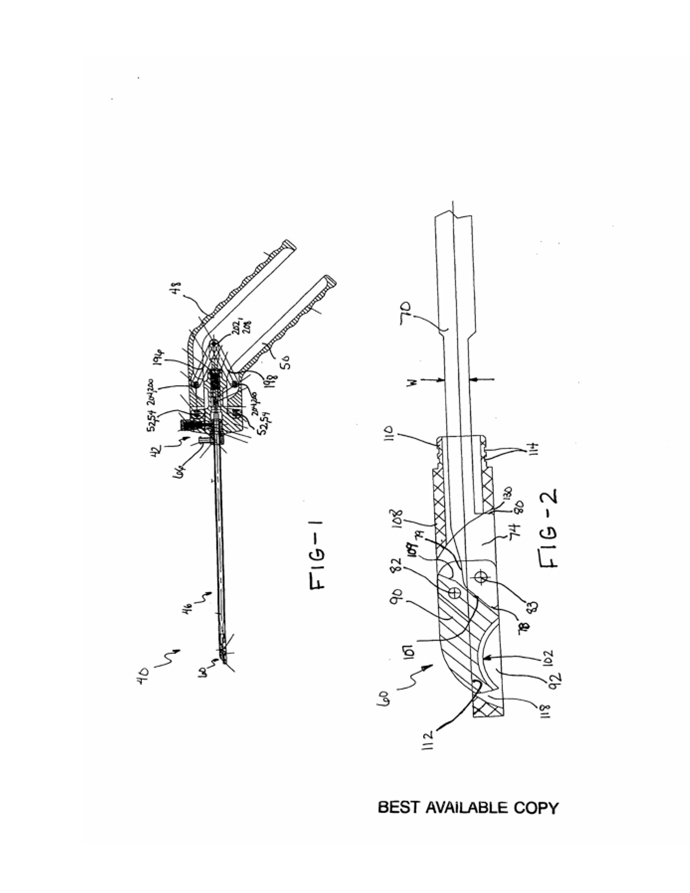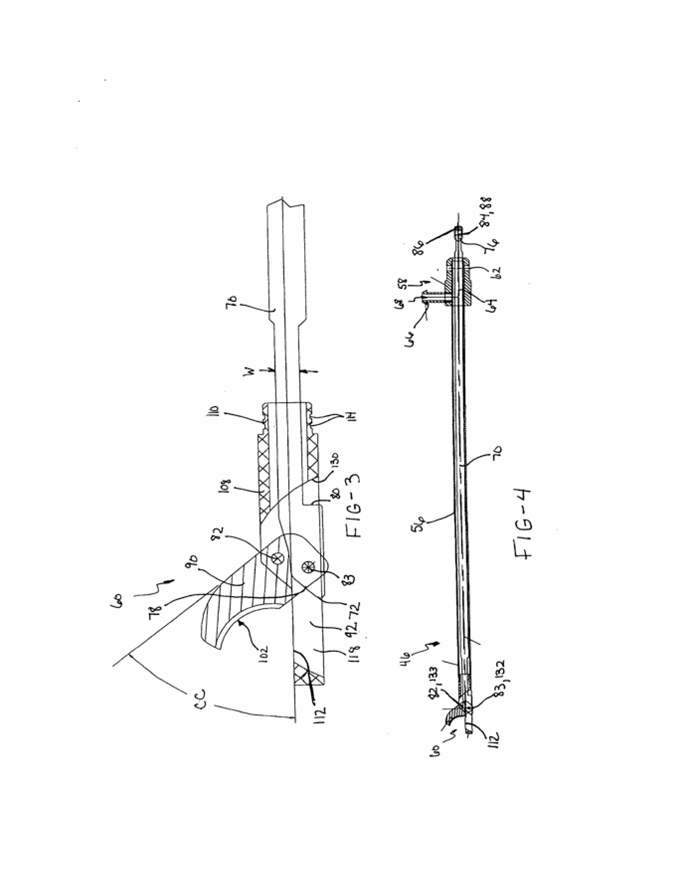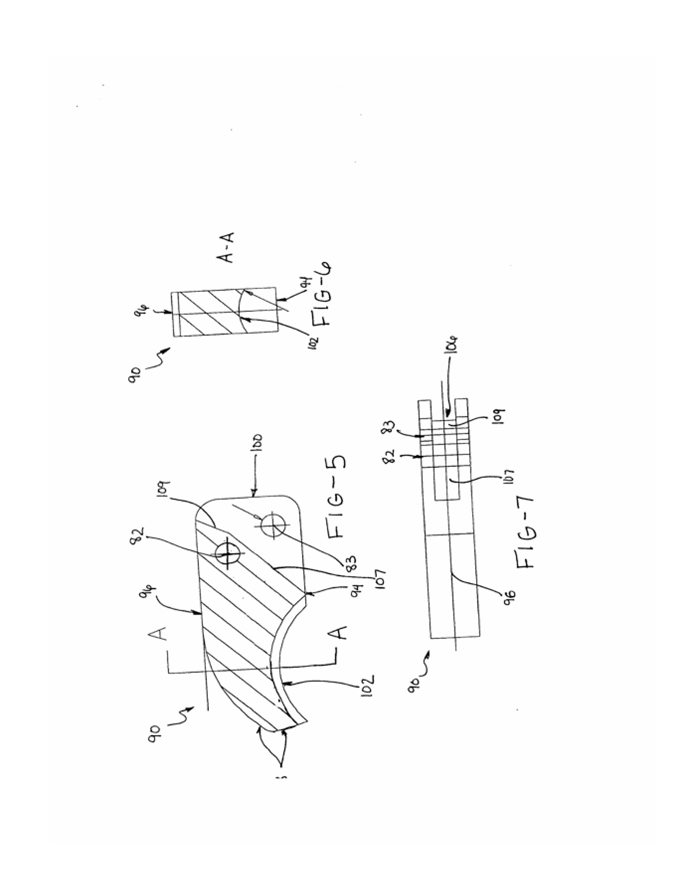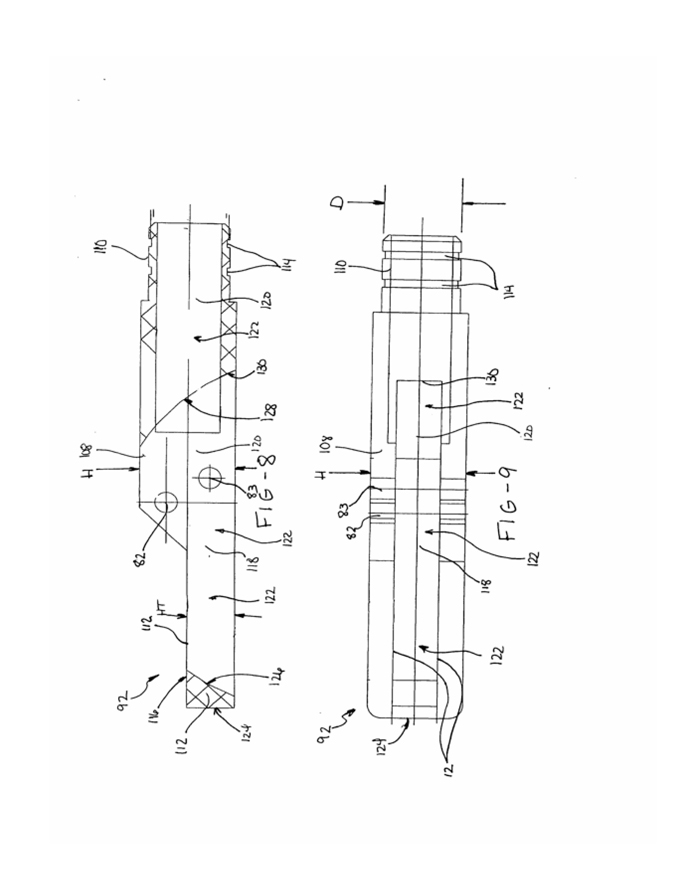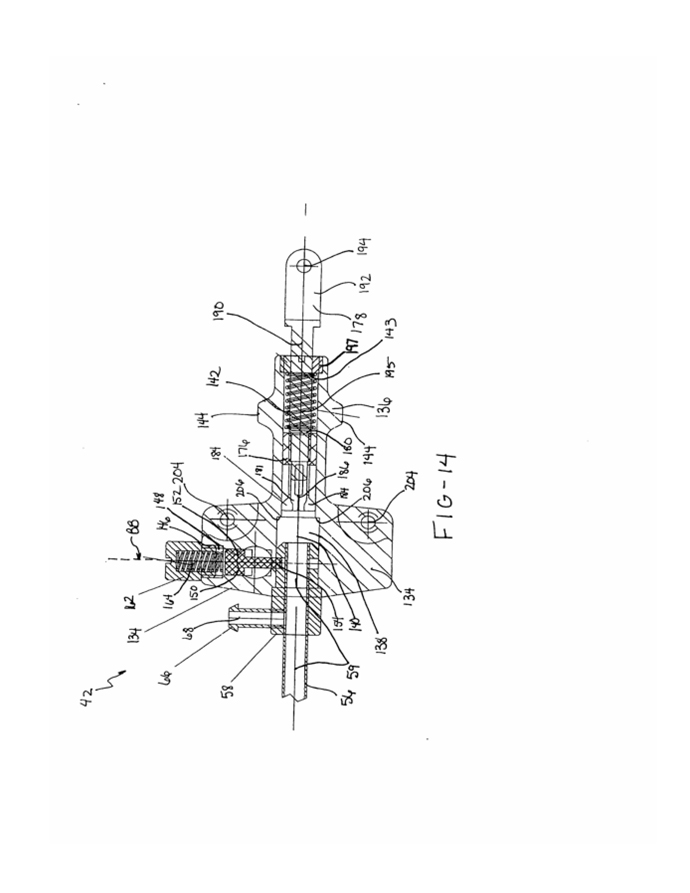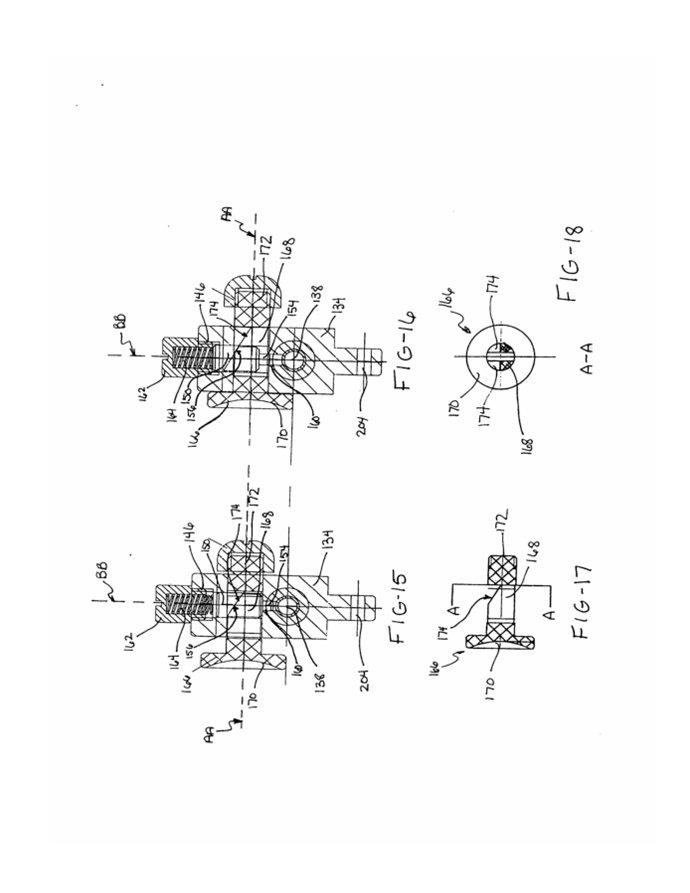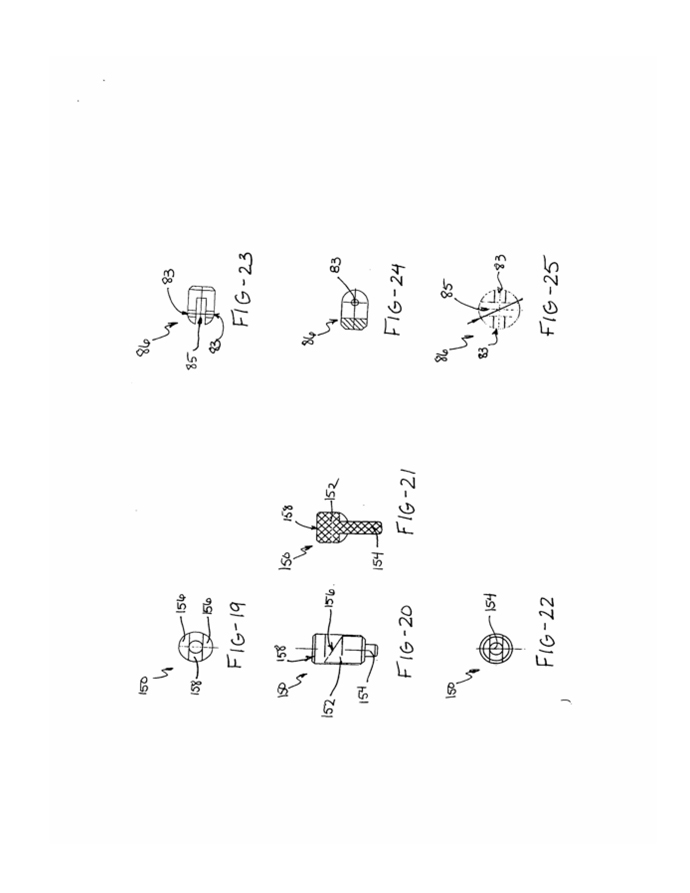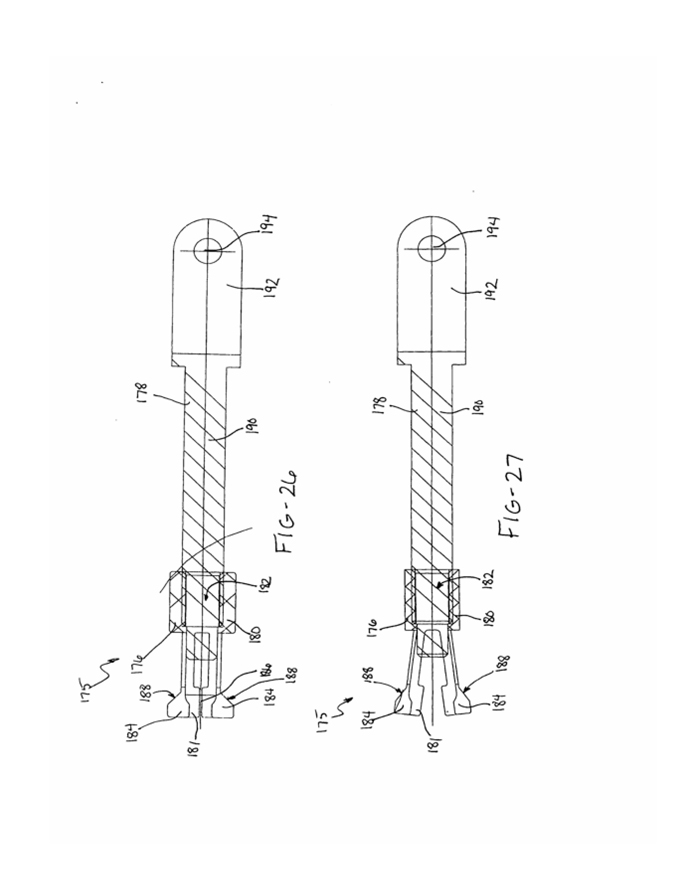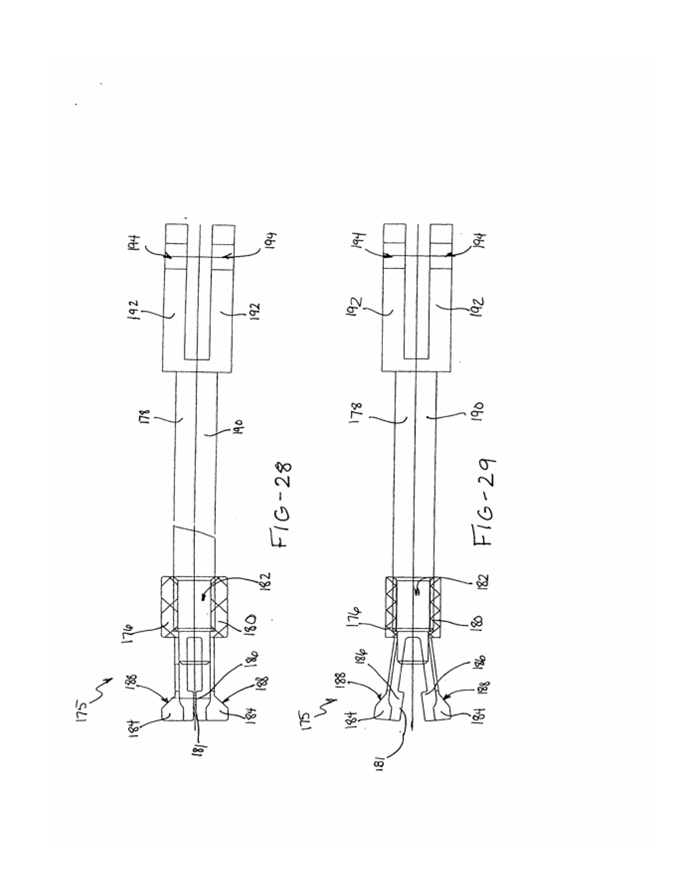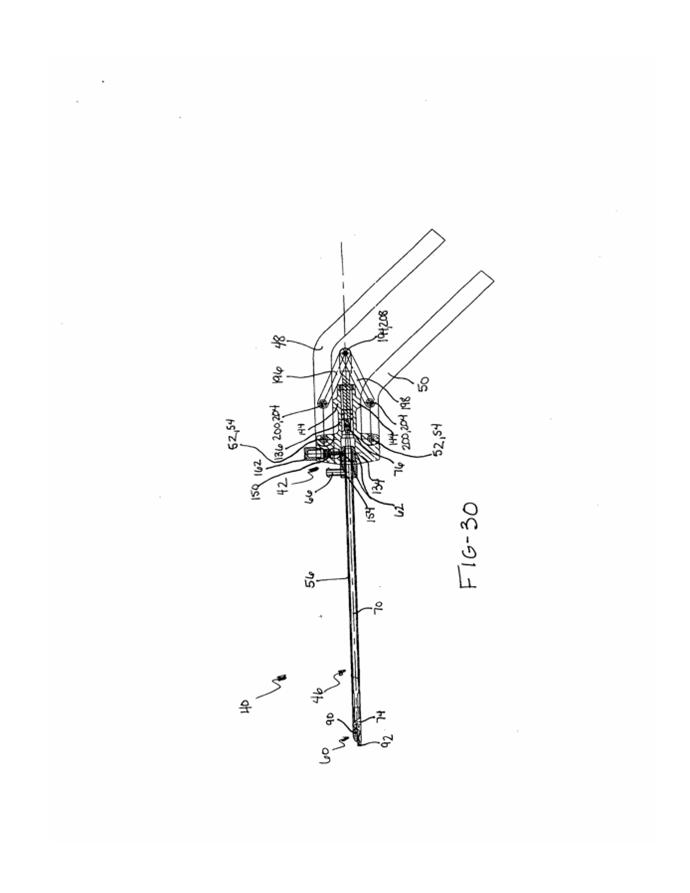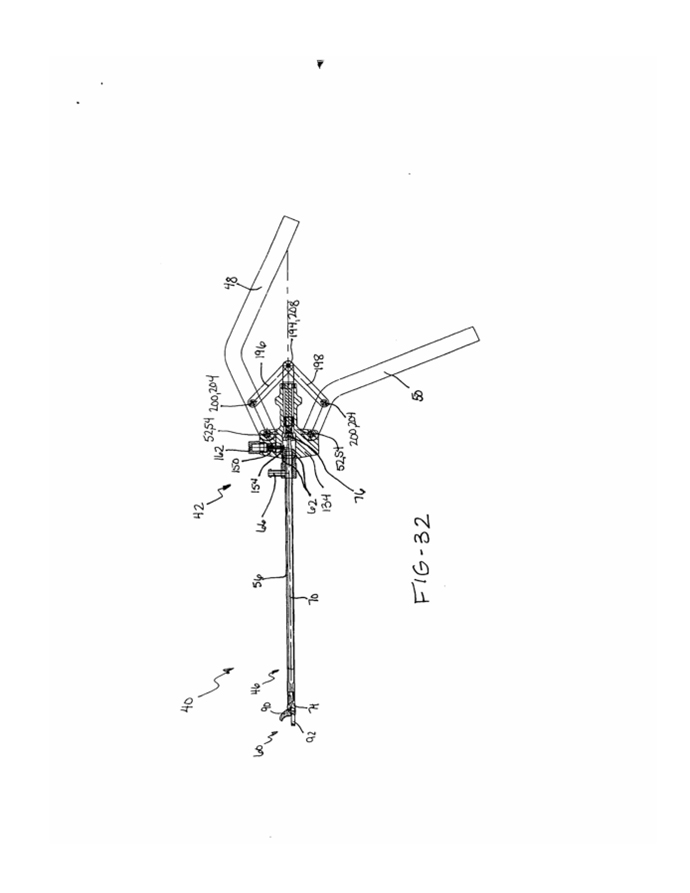Contract
EXHIBIT 10.15
This
ASSET PURCHASE AGREEMENT
(“Agreement”),
dated as of October 2, 2006 (“Effective Date”), is entered into by and
between Bovie Medical Corporation, a Delaware corporation (the "Buyer"), and
Lican Developments, Ltd., an Ontario, Canada corporation
("Seller").
WITNESSETH:
WHEREAS, Seller is in the
business of creating, engineering and developing intellectual property related
to medical devices, for commercialization in the United States, Canada, and
elsewhere in the world, and is to transfer certain Assets (as such term and each
other capitalized term used herein without definition is defined in Section 7.1)
to the Buyer pursuant to this Agreement; and
WHEREAS, the Buyer wishes, on
or about November 10, 2006 (“Expected Closing Date”) to purchase or acquire
(directly or indirectly through subsidiaries) from Seller, and Seller wishes to
sell, assign and transfer to the Buyer, certain Fixed Assets and Intangible
Assets (as such terms are defined below) held in connection with, necessary for,
or material to Seller’s business and operations (the "Business"), and the Buyer
has agreed to assume (directly or indirectly through its subsidiaries) the
Assumed Liabilities, all for the Purchase Price and upon the terms and subject
to the conditions hereinafter set forth;
NOW, THEREFORE, in
consideration of the mutual covenants, representations and warranties made
herein, and of the mutual benefits to be derived hereby, the sufficiency of
which is hereby acknowledged, the Parties hereto agree as follows:
ARTICLE
I
SALE
AND PURCHASE OF THE ASSETS
1.1.
Assets. Subject
to and upon the terms and conditions set forth in this Agreement, at the
Closing, Seller will sell, transfer, convey, assign and deliver to the Buyer,
and the Buyer will purchase or acquire from Seller, all right, title and
interest of Seller in and to (i) the fixed assets listed on schedule 1.1
(the “Fixed Assets”) and (ii) the intangible assets (including goodwill) listed
on Schedule 1.1 (the “Intangible Assets”), whether real, personal or mixed,
whether accrued, contingent or otherwise and whether now existing or hereinafter
acquired primarily relating to or used or held for use in connection with the
Business as the same may exist on the Closing Date (collectively, the "Assets"),
including all those items described below, as further set forth on Schedule
1.1:
(a) all
machinery, equipment, furniture, furnishings, tools, dies, molds and parts and
similar property (including, but not limited to, any of the foregoing purchased
subject to any conditional sales or title retention agreement in favor of any
other Person);
(b) all
inventories of raw materials, work in process, finished products, goods, spare
parts, replacement and component parts, and office and other supplies
(collectively, the "Inventories"), including Inventories held at any location
controlled by Seller, Inventories previously purchased and in transit to Seller
at such locations;
(c) all
Intellectual Property and all rights thereunder or in respect thereof primarily
relating to or used or held for use in connection with the Business, including,
but not limited to, rights to xxx for and remedies against past, present and
future infringements thereof, and rights of priority and protection of interests
therein under the laws of any jurisdiction worldwide and all tangible
embodiments thereof (together with all Intellectual Property rights included in
the other clauses of this Section 1.1, the "Intellectual Property
Assets");
(d) all
books, records, files, manuals and other materials (in any form or medium),
including, without limitation, correspondence, photographs, production data,
purchasing materials and records, personnel records, manufacturing and quality
control records and procedures, blueprints, research and development files,
records, data and laboratory books, Intellectual Property disclosures,
accounting records, and other files, related to the Assets;
|
Page
1 of 34
|
BUYER:
___ SELLER:
___
|
(e) to
the extent their transfer is permitted by law, all Governmental Approvals
(including but not limited to Seller’s manufacturing ISO certifications),
including all applications therefor;
(f)
all rights to causes of action, lawsuits, judgments, claims and demands of any
nature available to or being pursued by Seller with respect to the Business or
the ownership, use, function or value of any Asset, whether arising by way of
counterclaim or otherwise;
(g) all
guarantees, warranties, indemnities and similar rights in favor of Seller with
respect to any Asset;
(h)
Seller’s permission for, cooperation with, and support of Buyer’s hiring and
employing Seller’s organized, ISO-certified workforce consisting of Seller’s
former and current Employees; and
(i)
Henvil Corp.’s assignable right to all or any portion of the commercial space
leased by Henvil Corp. from L&M COCO Construction Ltd. (“Landlord”) being
approximately 4,375 square feet municipally located at 0000 Xxxxx Xxxxxx Xxxx.
X., Xxxxxxx, Xxxxxxx, X0X 0X0 (“Lease”);
Subject
to the terms and conditions hereof, at the Closing, the Assets shall be
transferred or otherwise conveyed to the Buyer free and clear of all
liabilities, obligations, liens and encumbrances excepting only Assumed
Liabilities, Liens listed on Schedule 3.1.11, and Permitted Liens.
1.2.
Excluded
Assets. The Seller will retain and not transfer, and Buyer will not
purchase or acquire, the following assets (collectively, the "Excluded
Assets"):
(a) the
assets listed on Schedule 1.2;
(b) the
name and xxxx "Lican Developments, Ltd.," in whole or in part;
(c) all
cash and cash equivalents held by Seller on the Effective Date;
(d) any
and all accounts receivable of the Seller; and
(e) any
other assets of the Seller not otherwise set out in Section 1.1.
ARTICLE
II
THE
CLOSING
2.1.
Place and Date.
The closing of the sale and purchase of the Assets (the “Closing”) shall take
place on the 2nd day of October, 2006, at the offices of Buyer, or at such other
time, place, and manner, as the Parties may agree. The day on which
the Closing actually occurs is herein sometimes referred to as the "Closing
Date."
2.2.
Purchase Price.
On the terms and subject to the conditions set forth in this Agreement, the
Buyer agrees to pay or cause to be paid to Seller: (i) an aggregate of Three
Hundred and Fifty Thousand Dollars ($350,000), (ii) subject to American Stock
Exchange listing approval, a grant to Seller of Two Hundred Thousand (200,000)
shares of Bovie Medical Corporation (AMEX:BVX) restricted stock, subject to the
vesting schedule described below, (iii) a grant to Seller of up to an aggregate
of One Hundred and Fifty Thousand (150,000) BVX shares of restricted stock
(conditioned on terms set forth below), (iv) royalty payments of
Two-and-One-Half Percent (2.5%) on Buyer’s Net Sales of “Tip on Tube” Products
and “RF Skin Resurfacing” Products, as set forth below, and (vi) royalty
payments of Three Percent (3%) on Buyer’s Net Sales of “SEAL-N-CUT” Products and
“MODULLION” Products, as set forth below (collectively, the "Purchase Price"),
and to assume or cause Buyer’s subsidiary to assume, the Assumed Liabilities as
provided in Section 2.4. The Purchase Price shall be payable to Seller as
follows:
(a) On
the Closing Date, by wire transfer, One Hundred and Fifty Thousand Dollars
($150,000) in immediately available funds to Seller’s bank account set forth on
Schedule 2.2(a);
|
Page 2
of 34
|
BUYER:
___ SELLER:
___
|
(b) No
later than thirty (30) days after each of the first four (4) anniversaries of
the Closing Date, by wire transfer, Fifty Thousand Dollars ($50,000) in
immediately available funds to Seller’s bank account set forth on Schedule
2.2(a); provided, however, that if Buyer fails to render the payments set forth
in this Section 2.2(b) after a thirty (30) day grace period immediately
following the due date of each such payment, Seller shall be entitled to an
immediate vesting of all remaining unvested shares of restricted BVX stock set
forth in Section 2.2(c);
(c)
Subject to the provisions of Section 7.7(d), no later than thirty (30) days
after the Closing Date, Two Hundred Thousand (200,000) shares of restricted BVX
stock, vesting over a four (4) year period as follows: Forty Percent (40%) or
80,000 shares immediately vested, and Twenty Percent (20%) or 40,000 shares
vested at each of the first three (3) anniversaries of the Closing Date;
provided, however, Seller shall hold all such vested shares for a period of at
least one (1) year before Seller may sell or transfer them;
(d) No
later than forty-five (45) days after each of the events set forth in
subsections (i)-(vi), below (the occurrence of which vests the corresponding
number of shares of restricted BVX stock), the number of such shares specified,
for an aggregate of up to One Hundred and Fifty Thousand (150,000) such shares;
provided, however, Seller shall hold all such vested shares for a period of at
least one (1) year before Seller may sell or transfer them :
(i) Forty Thousand
(40,000) shares upon Buyer obtaining a 510(k) FDA marketing clearance for the
“SEAL-N-CUT” Product;
(ii) Forty Thousand
(40,000) shares upon Buyer obtaining a 510(k) FDA marketing clearance for the
“MODULLION” Product;
(iii) Seventeen Thousand
Five Hundred (17,500) shares upon Buyer attaining a total of One Million Dollars
($1,000,000) in Net Sales of the “SEAL-N-CUT” Product;
(iv) Seventeen Thousand Five
Hundred (17,500) shares upon Buyer attaining a total of One Million Dollars
($1,000,000) in Net Sales of the “MODULLION” Product;
(v) Seventeen Thousand
Five Hundred (17,500) shares upon Buyer attaining a total of Three Million
Dollars ($3,000,000) in Net Sales of the “SEAL-N-CUT” Product; and
(vi) Seventeen Thousand Five
Hundred (17,500) shares upon Buyer attaining a total of Three Million Dollars
($3,000,000) in Net Sales of the “MODULLION” Product.
(e)
Royalty payments of Two-and-One-Half Percent (2.5%) on Buyer’s Net Sales of “Tip
on Tube” Products, as further set forth in Schedule 2.2(e);
(f)
Royalty payments of Two-and-One-Half Percent (2.5%) on Buyer’s Net Sales of “RF
Skin Resurfacing” Products, as further set forth in Schedule
2.2(f);
(g)
Royalty payments of Three Percent (3%) on Buyer’s Net Sales of “SEAL-N-CUT”
Products, as further set forth in Schedule 2.2(g); and
(h)
Royalty payments of Three Percent (3%) on Buyer’s Net Sales of “MODULLION”
Products, as further set forth in Schedule 2.2(h).
(i) In
addition to the foregoing, after Buyer obtains the applicable 510(k) FDA
marketing clearances, Buyer shall pay Seller royalty payments of Two Percent
(2%) on Buyer’s Net Sales of “Morscellator” Products and “Focused Ultrasonic
Energy” Skin and Tissue Products, as further set forth in Schedule
2.2(i).
The
Parties agree and acknowledge that Xxxxx Xxxxxx’x on-going personal services,
and fulfillment of his obligations, under the “Livneh Employment Agreement” (set
forth in Section 5.2.5(a), below) are (w) a material inducement for Buyer to
enter into this Agreement, (x) a condition precedent to the Seller’s attainment
of each of the elements of the Purchase Price set forth in this Section 2.2
(including all subsections (a)-(i), except (b)), (y) a condition precedent to
the vesting of shares of restricted BVX stock under subsections 2.2(c) and
2.2(d), and (z) a condition subsequent to the right to receive royalty payments
under subsections 2.2(e)-(i) hereof. With regard to Seller’s right to
receive royalty payments hereunder, a failure of the condition subsequent in the
preceding subsection (z) (i.e., termination for cause or non-renewal of the
Livneh Employment Agreement resulting in less than a total of five (5) years of
continuous service thereunder) will permit Buyer to reduce such royalty payments
by Fifty Percent (50%).
|
Page 3
of 34
|
BUYER:
___ SELLER:
___
|
The
provisions of the foregoing paragraph concerning Xxxxx Xxxxxx’x performance
under the Livneh Employment Agreement shall not apply if Buyer (or its Affiliate
employing Xxxxx Xxxxxx under that agreement) (i) terminates the Livneh
Employment Agreement without cause, (ii) fails to renew the Livneh Employment
Agreement for an additional two (2) years beyond the initial 3-year term, as
provided therein, or (iii) both materially and adversely modifies Xxxxx Xxxxxx’x
title, location of employment, definitions or compensation, under the Livneh
Employment Agreement, without his written consent. In the event of a
termination of the Livneh Employment Agreement due to Xxxxx Xxxxxx’x death as
set forth under Section 11(a) thereof, Buyer shall (1) pay to Seller Fifty
Percent (50%) of the royalty payments due and payable under this Section 2.2,
which royalty payments are earned and in effect as of the date of such
termination for death, and Buyer shall immediately accelerate the vesting of any
remaining unvested shares of restricted BVX stock set forth in Section 2.2(c),
if any.
From and
after the Effective Date the Buyer shall be solely responsible for any and all
costs and expenses associated with all provisional patent applications being
purchased hereunder.
2.3.
Allocation of Purchase
Price. (a) The Parties agree to allocate the aggregate of the Purchase
Price and the Assumed Liabilities acquired from Seller in accordance with an
allocation schedule to be prepared by the Buyer. Such allocation schedule
shall be prepared in accordance with section 1060 of the Code.
(b) The
Purchase Price allocated to Assets in the United States pursuant to Section
2.3(a) shall be allocated among the Assets in accordance with an allocation
schedule to be prepared by the Buyer. Such allocation schedule shall be
prepared in accordance with section 1060 of the Code. The Purchase
Price allocated to the Assets in Canada pursuant to Section 2.3(a) shall be
allocated among the Assets in such country in accordance with an allocation
schedule to be prepared by the Buyer. Such allocation schedule shall be
prepared in accordance with the requirements of the applicable tax laws of
Canada and the United States.
(c) In
connection with the determination of the foregoing allocation schedules, the
Parties shall cooperate with each other and provide such information as any of
them shall reasonably request. The Parties will each report the federal, state
and local and other Tax consequences of the purchase and sale contemplated
hereby (including the filing of Internal Revenue Service Form 8594 by the Buyer)
in a manner consistent with such allocation schedules.
2.4.
Assumption of
Liabilities. Subject to the terms and conditions set forth herein, at the
Closing, the Buyer shall assume and agree to pay, honor and discharge when due
all of the following liabilities relating to the Assets and arising on or after
the Closing Date (collectively, the "Assumed Liabilities"):
(a) any
and all liabilities, obligations and commitments relating exclusively to the
Assets that are incurred after the Closing Date except for (A) liabilities
related to product liability claims, (B) liabilities for Taxes relating to or
arising out of the Business accruing, or with respect to any event or time
period occurring, at or prior to Closing, (C) liabilities in respect of
Employees;
(b) any
and all liabilities, obligations and commitments (x) arising out of the
agreements, contracts and commitments set forth on the Schedule 3.1.12(a) (or
not required to be set forth therein because of the amount involved), but not
including any obligation or liability for any breach thereof occurring prior to
the Closing Date or (y) listed on Schedule 2.4(b);
(c)
liabilities in respect of Transferred Employees to the extent specifically and
expressly assumed by Buyer pursuant to Article VI of this Agreement;
and
|
Page 4
of 34
|
BUYER:
___ SELLER:
___
|
(d) any
and all liabilities, obligations and commitments of the Seller relating to the
Lease of the premises from which the Business is currently being conducted
including, without limitation, the payment of rent and all
utilities.
2.5.
Excluded
Liabilities. Notwithstanding the provisions of Section 2.4 or any other
provision hereof or any schedule or exhibit hereto and regardless of any
disclosure to the Buyer, the Buyer shall not assume any liabilities, obligations
or commitments of Seller relating to or arising out of either the operation of
the Business or the ownership of the Assets prior to the Closing Date other than
the Assumed Liabilities (the "Excluded Liabilities").
2.6.
Consent of Third
Parties. Notwithstanding anything to the contrary in this Agreement, this
Agreement shall not constitute an agreement to assign or transfer any
Governmental Approval, instrument, contract, lease, permit or other agreement or
arrangement (collectively, “Party Right”) or any claim, right or benefit arising
thereunder or resulting therefrom if an assignment or transfer or an attempt to
make such an assignment or transfer without the consent of a third party would
constitute a breach or violation thereof or affect adversely the rights of the
Buyer or Seller thereunder; and any transfer or assignment to the Buyer by
Seller of any interest under any such Party Right that requires the consent of a
third party shall be made subject to such consent or approval being obtained. In
the event any such consent or approval is not obtained on or prior to the
Closing Date, Seller shall continue to use all reasonable efforts to obtain any
such approval or consent after the Closing Date until such time as such consent
or approval has been obtained, or Seller has reasonably determined, in good
faith, that it cannot obtain such consent or approval, and Seller will cooperate
with the Buyer in any lawful and economically feasible arrangement to provide
that the Buyer shall receive the interest of Seller, as the case may be, in the
benefits under any such Party Right, including performance by Seller, as the
case may be, as agent, if economically feasible, provided that the Buyer shall
undertake to pay or satisfy the corresponding liabilities for the enjoyment of
such benefit to the extent the Buyer would have been responsible therefor
hereunder if such consent or approval had been obtained. Seller shall pay and
discharge, and shall indemnify and hold the Buyer harmless from and against, any
and all out-of-pocket costs of seeking to obtain or obtaining any such consent
or approval whether before or after the Closing Date. Nothing in this Section
2.6 shall be deemed a waiver by the Buyer of its right to have received on or
before the Closing an effective assignment of all of the Assets nor shall this
Section 2.6 be deemed to constitute an agreement to exclude from the Assets any
assets described under Section 1.1.
ARTICLE
III
REPRESENTATIONS
AND WARRANTIES
3.1.
Representations and
Warranties of Seller. As of the Effective Date and as of the Closing
Date, Seller represents and warrants to the Buyer as follows:
3.1.1.
Authorization.
Seller has the corporate power and authority to execute and deliver this
Agreement and each of the Collateral Agreements to which it will be a party, to
perform fully its obligations hereunder and thereunder, and to consummate the
transactions contemplated thereby. The execution and delivery by Seller of this
Agreement, and the consummation of the transactions contemplated hereby, have
been, and on the Closing Date, the execution and delivery of the Collateral
Agreements to which it will be a party and the consummation of the transactions
contemplated thereby will have been, duly authorized by all requisite corporate
action of Seller. This Agreement is, and on the Closing Date each of the
Collateral Agreements to which Seller is a party will be, legal, valid and
binding obligations of Seller, enforceable against it in accordance with their
respective terms.
3.1.2.
Corporate
Status. (a) Seller is a corporation duly organized, validly existing and
in good standing under the laws of the Province of Ontario, Canada, with full
corporate power and authority to carry on its business and to own or lease and
to operate its properties as and in the places where such business is conducted
and such properties are owned, leased or operated.
(b)
Seller is duly qualified or licensed to do business and is in good standing in
the Province of Ontario, Canada, where it does business or owns property, which
is the only jurisdiction in which the operation of the Business or the character
of the properties owned, leased or operated by it in connection with the Assets
makes such qualification or licensing necessary.
|
Page 5
of 34
|
BUYER:
___ SELLER:
___
|
(c)
Seller has delivered to the Buyer complete and correct copies of its certificate
of incorporation and by-laws or other organizational documents, as amended and
in effect on the date hereof. Seller is not in violation of any of
the provisions of its certificate of incorporation or by-laws or other
organizational documents.
3.1.3.
No Conflicts.
The execution, delivery and performance by Seller of this Agreement and each of
the Collateral Agreements to which it is a party, and the consummation of the
transactions contemplated thereby, do not and will not conflict with, result in
a violation or breach of or default under (with or without the giving of notice
or the lapse of time or both), give rise to a right or claim of termination,
amendment, modification, vesting, acceleration or cancellation of any right or
obligation or loss of any material benefit under, or result in the creation of
any Lien (or any obligation to create any Lien) upon any of the Assets under (i)
any Applicable Law applicable to Seller or any Affiliate thereof or any of the
properties or assets of Seller (including but not limited to the Assets), (ii)
the certificate of incorporation or by-laws or other organizational documents of
Seller or (iii) except as set forth in Schedule 3.1.3, any Contract or other
contract, agreement or other instrument to which Seller or any Affiliate thereof
is a party or by which Seller or any of their properties or assets, including
but not limited to the Assets, may be bound or affected. Except as specified in
Schedule 3.1.3, no Governmental Approval or other Consent is required to be
obtained or made by Seller in connection with the execution and delivery of this
Agreement and the Collateral Agreements or the consummation of the transactions
contemplated thereby.
3.1.4.
Financial
Statements. Seller has delivered to the Buyer Seller’s unaudited
consolidated financial statements as of and for the period ended August 29, 2006
(the "Unaudited Balance Sheet Date"), together with a report thereon by Seller's
Accountants (the "Unaudited Financial Statements"), including a balance sheet,
statements of income and retained earnings and a statement of cash flows (all
parts of the Unaudited Financial Statements collectively known as the
"Financial Statements"). The Unaudited Financial Statements have been prepared.
From February 1, 2006 forward, the balance sheets included in the Financial
Statements do not include any material assets or liabilities not intended to
constitute a part of the Business or the Assets after giving effect to the
transactions contemplated hereby, and present fairly the financial condition of
the Business as at their respective dates. The statements of income and retained
earnings and statements of cash flows included in the Financial Statements do
not reflect the operations of any entity or business not intended to constitute
a part of the Business after giving effect to all such transactions, reflect all
costs that historically have been incurred by the Business (other than the
Excluded Liabilities) and present fairly the results of operations and cash
flows of the Business for the periods indicated.
3.1.5.
Absence of Undisclosed
Liabilities. To Seller’s Knowledge, Seller has no liabilities or
obligations of any nature, whether known or unknown, absolute, accrued,
contingent or otherwise and whether due or to become due, arising out of or
relating to the Business or Assets, except (a) as set
forth in Schedule 3.1.5, (b) as and to the extent disclosed or reserved against
in the Unaudited Balance Sheet and (c) for liabilities and obligations that (i)
were incurred after the date of the Unaudited Balance Sheet in the ordinary
course of business consistent with prior practice and (ii) individually and in
the aggregate are not material to the Business and have not had or resulted in,
and will not have or result in, a Material Adverse Effect. None of Seller’s
employees is now, or will by the passage of time, hereinafter become entitled to
receive any vacation time, vacation pay or severance pay attributable to
services rendered prior to such date except as disclosed on the Unaudited
Balance Sheet.
3.1.6.
Taxes. (a)
Seller has (or by the Closing Date will have) duly and timely filed all Tax
Returns relating to the Business with respect to Covered Taxes required to be
filed on or before the Closing Date ("Covered Returns"). Except for Covered
Taxes set forth on Schedule 3.1.6(a), which are being contested in good faith
and by appropriate proceedings, the following Covered Taxes have (or by the
Closing Date will have) been duly and timely paid: (i) all Covered Taxes shown
to be due on the Covered Returns, (ii) all deficiencies and assessments of
Covered Taxes of which notice has (or by the Closing Date will have) been
received by Seller that are or may become payable by the Buyer or chargeable as
a lien upon the Business or the Assets, and (iii) all other Covered Taxes due
and payable on or before the Closing Date for which neither filing of Covered
Returns nor notice of deficiency or assessment is required, of which Seller is
or reasonably should be (or by the Closing Date will be or reasonably should be)
aware that are or may become payable by the Buyer or chargeable as a lien upon
the Business or Assets. All Taxes required to be withheld by or on behalf of
Seller in connection with amounts paid or owing to any employee, independent
contractor, creditor or other party with respect to the Business or the Assets
("Withholding Taxes") have been withheld, and such withheld taxes have either
been duly and timely paid to the proper Governmental Authorities or set aside in
accounts for such purpose.
|
Page 6
of 34
|
BUYER:
___ SELLER:
___
|
(b)
Except as set forth on Schedule 3.1.6(b), no agreement or other document
extending, or having the effect of extending, the period of assessment or
collection of any Covered Taxes or Withholding Taxes, and no power of attorney
with respect to any such Taxes, has been filed with any Governmental Authority
(including, but not limited to, the IRS).
(c)
Except as set forth on Schedule 3.1.6(c), (i) there are no Covered Taxes or
Withholding Taxes asserted in writing by any Governmental Authority to be due
and (ii) no issue has been raised in writing by any Governmental Authority in
the course of any audit with respect to Covered Taxes or Withholding Taxes.
Except as set forth on Schedule 3.1.6(c), no Covered Taxes and no Withholding
Taxes are currently under audit by any Governmental Authority. Except as set
forth on Schedule 3.1.6(c), neither the IRS nor any other Governmental Authority
is now asserting or, to the best Knowledge of Seller, threatening to assert
against Seller any deficiency or claim for additional Covered Taxes or any
adjustment of Covered Taxes that would, if paid by the Buyer, have a Material
Adverse Effect, and there is no reasonable basis for any such assertion of which
Seller is or reasonably should be aware.
(d)
Except as set forth on Schedule 3.1.6(d), there is no litigation or
administrative appeal pending or, to the best Knowledge of Seller, threatened
against or relating to Seller in connection with Covered Taxes.
3.1.7.
Absence of
Changes. Except as set forth in Schedule 3.1.7, since the Unaudited
Balance Sheet Date, Seller has conducted the Business only in the ordinary
course consistent with prior practice and, to the Seller’s Knowledge, has not,
on behalf of, in connection with or relating to the Business or the
Assets:
(a)
suffered any Material Adverse Effect;
(b)
incurred any obligation or liability, absolute, accrued, contingent or
otherwise, whether due or to become due, except current liabilities for trade or
business obligations incurred in connection with the purchase of goods or
services in the ordinary course of business consistent with prior practice, none
of which liabilities, in any case or in the aggregate, could have a Material
Adverse Effect;
(c)
discharged or satisfied any Lien other than those then required to be discharged
or satisfied, or paid any obligation or liability, absolute, accrued, contingent
or otherwise, whether due or to become due, other than current liabilities shown
on the Unaudited Balance Sheet and current liabilities incurred since the date
thereof in the ordinary course of business consistent with prior
practice;
(d)
assigned, mortgaged, pledged or otherwise subjected to Lien, any property,
business or assets (including Assets), tangible or intangible, held in
connection with the Business;
(e) sold,
transferred, leased to others or otherwise disposed of any of the Assets, except
for inventory sold in the ordinary course of business, or forgiven, canceled or
compromised any debt or claim, or waived or released any right of substantial
value;
(f)
received any notice of termination of any contract, lease or other agreement or
suffered any damage, destruction or loss (whether or not covered by insurance)
which, in any case or in the aggregate, has had a Material Adverse
Effect;
(g)
transferred or granted any rights or licenses under, or entered into any
settlement regarding the breach or infringement of, any Intellectual Property,
or modified any existing rights with respect thereto;
|
Page 7
of 34
|
BUYER:
___ SELLER:
___
|
(h) made
any change in the rate of compensation, commission, bonus or other direct or
indirect remuneration payable, or paid or agreed or orally promised to pay,
conditionally or otherwise, any bonus, incentive, retention or other
compensation, retirement, welfare, fringe or severance benefit or vacation pay,
to or in respect of any shareholder, director, officer, employee, salesman,
distributor or agent of Seller relating to the Business or the
Assets;
(i)
encountered any labor union organizing activity, had any actual or threatened
employee strikes, work stoppages, slowdowns or lockouts, or had any material
change in its relations with its employees, agents, customers or
suppliers;
(j)
instituted, settled or agreed to settle any litigation, action or proceeding
before any court or governmental body relating to the Business or the
Assets;
(k) (i)
entered into any transaction, contract or commitment other than in the ordinary
course of business, (ii) breached any contract or commitment or (iii) paid or
agreed to pay any brokerage, finder's fee, Taxes or other expenses in connection
with, or incurred any severance pay obligations by reason of, this Agreement or
the transactions contemplated hereby;
(l) made
any material changes in policies or practices relating to selling practices,
returns, discounts or other terms of sale or accounting therefor or in policies
of employment;
(m) made
any prepayment of any accounts payable, delayed payment of any trade payables or
other obligations other than in the ordinary course of business consistent with
past practice, or made any other cash payments other than in the ordinary course
of business;
(n)
failed to maintain all of the tangible Assets and all other tangible properties
and assets owned, leased, occupied, operated or used in connection with the
Business in good repair, working order and operating condition subject only to
ordinary wear and tear;
(o)
failed to use best efforts to keep in full force and effect insurance comparable
in amount and scope of coverage to insurance now carried in connection with the
Business; or
(p) taken
any action or omitted to take any action that would result in the occurrence of
any of the foregoing.
3.1.8.
Litigation. To
Seller’s Knowledge, except as set forth on Schedule 3.1.8, there is no action,
claim, demand, suit, proceeding, arbitration, grievance, citation, summons,
subpoena, inquiry or investigation of any nature, civil, criminal, regulatory or
otherwise, in law or in equity, pending or threatened against or relating to
Seller in connection with the Assets or the Business or against or relating to
the transactions contemplated by this Agreement, and Seller does not know or
have reason to be aware of any basis for the same. Except as set forth in such
Schedule 3.1.8, no citations, fines or penalties have been asserted against
Seller since February 1, 2006, under any foreign, federal, state or local law
relating to occupational health or safety.
3.1.9.
Compliance with Laws;
Governmental Approvals and Consents; Governmental Contracts. (a) Except
as disclosed in Schedule 3.1.9(a) since February 1, 2006, Seller has complied in
all material respects with all Applicable Laws applicable to the Business or the
Assets, and Seller has not received any notice alleging any such conflict,
violation, breach or default.
(b)
Schedule 3.1.9(b) sets forth all Governmental Approvals and other Consents
necessary for, or otherwise material to, the conduct of the Business and the
ownership and use of the Assets. Except as set forth in Schedule 3.1.9(b), all
such Governmental Approvals and Consents have been duly obtained and are in full
force and effect, and Seller is in compliance with each of such Governmental
Approvals and Consents held by it with respect to the Assets and the
Business.
(c)
Schedule 3.1.9(c) sets forth all Contracts with any Governmental
Authority.
(d) To
Seller’s Knowledge, there are no proposed laws, rules, regulations, ordinances,
orders, judgments, decrees, governmental takings, condemnations or other
proceedings which would be applicable to the business, operations or properties
of Seller and which might adversely affect the properties, assets, liabilities,
operations or prospects of Seller, either before or after the Closing
Date.
|
Page 8
of 34
|
BUYER:
___ SELLER:
___
|
3.1.10.
Operation of the
Business. Except as set forth in Schedule 3.1.10, (a) Seller has
conducted the Business only through Seller and not through any other divisions
or any direct or indirect subsidiary or affiliate of Seller and (b) no part of
the Business is operated by Seller through any entity other than
Seller.
3.1.11.
Assets. Except
as disclosed in Schedule 3.1.11, Seller has good title to all the Assets free
and clear of any and all Liens other than Permitted Liens. The Assets, together
with the services and arrangements described in Section 5.2.5, comprise all
assets and services required for the continued conduct of the Business, by the
Buyer, as now being conducted. The Assets, taken as a whole, constitute all the
properties and assets relating to or used or held for use in connection with the
Business during the past twelve (12) months. Except for Excluded
Assets, there are no assets or properties used in the operation of the Business
and owned by any Person other than Seller that will not be leased or licensed to
the Buyer under valid, current leases or license arrangements. As of the
Effective Date, the Assets are in all material respects adequate for the
purposes for which such assets were then currently used or were held for use,
and were in reasonably good repair and operating condition (subject to normal
wear and tear) and, to the Knowledge of Seller, there are no facts or conditions
affecting the Assets which could, individually or in the aggregate, interfere in
any material respect with the use, occupancy or operation thereof as currently
used, occupied or operated, or their adequacy for such use.
3.1.12.
Contracts. (a)
Schedule 3.1.12(a) contains a complete and correct list of all agreements,
contracts, commitments and other instruments and arrangements (whether written
or oral) of the types described below (x) by which any of the Assets are bound
or affected or (y) to which Seller is a party or by which it is bound in
connection with the Business or the Assets (the "Contracts"):
(i)
leases, licenses, permits, franchises, insurance policies, Governmental
Approvals and other contracts concerning or relating to the Real
Property;
(ii)
employment, consulting, agency, collective bargaining or other similar
contracts, agreements, and other instruments and arrangements relating to or for
the benefit of current, future or former employees, officers, directors, sales
representatives, distributors, dealers, agents, independent contractors or
consultants;
(iii)
loan agreements, indentures, letters of credit, mortgages, security agreements,
pledge agreements, deeds of trust, bonds, notes, guarantees, and other
agreements and instruments relating to the borrowing of money or obtaining of or
extension of credit;
(iv)
licenses, licensing arrangements and other contracts providing in whole or in
part for the use of, or limiting the use of, any Intellectual
Property;
(v)
brokerage or finder's agreements;
(vi)
joint venture, partnership and similar contracts involving a sharing of profits
or expenses (including but not limited to joint research and development and
joint marketing contracts);
(vii)
stock purchase agreements, asset purchase agreements and other acquisition or
divestiture agreements, including but not limited to any agreements relating to
the acquisition, sale, lease or disposal of any Assets (other than sales of
inventory in the ordinary course of business) or involving continuing indemnity
or other obligations;
(viii)
orders and other contracts for the purchase or sale of materials, supplies,
products or services, each of which involves aggregate payments in excess of Ten
Thousand Dollars ($10,000) in the case of purchases;
(ix)
contracts with respect to which the aggregate amount that could reasonably
expected to be paid or received thereunder in the future exceeds Ten Thousand
Dollars ($10,000);
(x) sales
agency, manufacturer's representative, marketing or distributorship
agreements;
|
Page 9
of 34
|
BUYER:
___ SELLER:
___
|
(xi)
contracts, agreements or arrangements with respect to the representation of the
Business in foreign countries;
(xii)
lease agreements providing for the leasing of both (A) personal property
primarily used in, or held for use primarily in connection with, the Business
and (B) other personal property;
(xiii)
contracts, agreements or commitments with any employee, director, officer,
stockholder or Affiliate of Seller; and
(xiv) any
other contracts, agreements or commitments that are or will be material to the
Business.
(b)
Seller has delivered to Buyer complete and correct copies of all written
Contracts, together with all amendments thereto, and accurate descriptions of
all material terms of all oral Contracts, set forth or required to be set forth
in Schedule 3.1.12(a).
(c) All
Contracts are in full force and effect and enforceable against each party
thereto. There does not exist under any Contract any event of default or event
or condition that, after notice or lapse of time or both, would constitute a
violation, breach or event of default thereunder on the part of Seller or, to
the best Knowledge of Seller, any other party thereto except as set forth in
Schedule 3.1.12(c) and except for such events or conditions that, individually
and in the aggregate, (i) have not had or resulted in, and will not have or
result in, a Material Adverse Effect and (ii) have not and will not materially
impair the ability of Seller to perform their respective obligations under this
Agreement and under the Collateral Agreements. Except as set forth in Schedule
3.1.12(c), no consent of any third party is required under any Contract as a
result of or in connection with, and the enforceability of any Contract will not
be affected in any manner by, the execution, delivery and performance of this
Agreement or any of the Collateral Agreements or the consummation of the
transactions contemplated thereby.
(d)
Seller has no outstanding power of attorney relating to the Business or the
Assets.
3.1.13.
Territorial
Restrictions. Seller is not restricted by any written agreement or
understanding with any other Person from carrying on the Business anywhere in
the world. To Seller’s Knowledge, the Buyer, solely as a result of its purchase
of the Assets from Seller pursuant hereto and the assumption of the Assumed
Liabilities, will not thereby become restricted in carrying on any business
anywhere in the world.
3.1.14.
Inventories.
All Inventories are of good, usable and merchantable quality in all material
respects and, except as set forth on Schedule 3.1.14, do not include obsolete or
discontinued items. Except as set forth on Schedule 3.1.14, (a) all Inventories
are of such quality as to meet the quality control standards of Seller and any
applicable governmental quality control standards, (b) all Inventories that are
finished goods are saleable as current inventories at the current prices thereof
in the ordinary course of business, (c) all Inventories are recorded on the
books of the Business at the lower of cost or market value determined in
accordance with GAAP, and (d) no write-down in inventory has been made or should
have been made pursuant to GAAP during the past two years. Schedule 3.1.14 lists
the locations of all Inventories.
3.1.15.
Suppliers; Raw
Materials. Schedule 3.1.15 sets forth the names and addresses of all
suppliers from which Seller ordered raw materials, supplies, merchandise and
other goods and services with an aggregate purchase price for each such supplier
of One Thousand Dollars ($1,000) or more during the twelve-month period
immediately preceding the Unaudited Balance Sheet Date. Seller has neither
received any notice nor has any reason to believe that there has been any
material adverse change in the price of such raw materials, supplies,
merchandise or other goods or services, or that any such supplier will not sell
raw materials, supplies, merchandise and other goods to the Buyer at any time
after the Closing Date on terms and conditions similar to those used in its
current sales to Seller, subject to general and customary price increases. To
the best Knowledge of Seller, no supplier of Seller described hereinabove has
otherwise threatened to take any action described in the preceding sentence as a
result of the consummation of the transactions contemplated by this Agreement
and the Collateral Agreements.
|
Page
10 of 34
|
BUYER:
___ SELLER:
___
|
3.1.16.
Products. (a)
Warranties.
Seller has neither manufactured nor sold any products, to any customers, for
which there are or could be any product liability claims. Except as
required by Applicable Law or as set forth on Schedule 3.1.16(a), no product
manufactured, sold, or delivered by, or service rendered by or on behalf of,
Seller is subject to any guaranty, warranty or other indemnity, express or
implied, beyond such standard terms and conditions.
(b) Product Liability.
Except as set forth on Schedule 3.1.16(b), Seller has no liability or obligation
of any nature (whether known or unknown, accrued, absolute, contingent or
otherwise, and whether due or to become due), whether based on strict liability,
negligence, breach of warranty (express or implied), breach of contract or
otherwise, in respect of any product, component or other item manufactured,
sold, designed or produced prior to the Closing by, or service rendered prior to
the Closing by or on behalf of, Seller or any predecessor thereto, that (i) is
not fully and adequately covered by policies of insurance or by indemnity,
contribution, cost sharing or similar agreements or arrangements by or with
other Persons, and (ii) is not otherwise fully and adequately reserved against
as reflected in the Financial Statements.
(c) Rebates. Except as
set forth on Schedule 3.1.16(c), Seller has not entered into, or offered to
enter into, any agreement, contract commitment or other arrangement (whether
written or oral) pursuant to which Seller is or will be obligated to make any
rebates, discounts, promotional allowances or similar payments or arrangements
to any customer ("Rebate Obligations"). All Rebate Obligations are reflected in
the Unaudited Financial Statements or have been incurred after the date thereof
in the ordinary course of business.
3.1.17.
Absence of Certain
Business Practices. To Seller’s Knowledge, neither Seller nor any of its
officers, employees or agents, or any other person acting on their behalf, has,
directly or indirectly, within the past five (5) years, given or agreed to give
any gift or similar benefit to any customer, supplier, governmental employee or
other person who is or may be in a position to help or hinder the Business (or
assist Seller in connection with any actual or proposed transaction relating to
the Business) (i) which subjected or might have subjected Seller to any damage
or penalty in any civil, criminal or governmental litigation or proceeding, (ii)
which if not given in the past, might have had a Material Adverse Effect, (iii)
which if not continued in the future, might have a Material Adverse Effect or
subject Seller to suit or penalty in any private or governmental litigation or
proceeding, (iv) for any of the purposes described in or equivalent to Section
162(c) of the Code or (v) for the purpose of establishing or maintaining any
concealed fund or concealed bank account.
3.1.18.
Intellectual
Property. (a) Title. Schedule
3.1.18(a) contains a complete and correct list of all Intellectual Property that
is owned by Seller and primarily related to, used in, held for use in connection
with, or necessary for the conduct of, or otherwise material to the Business
(the "Owned Intellectual Property"). Seller owns or has the exclusive right to
use pursuant to license, sublicense, agreement or permission all Intellectual
Property Assets, free from any Liens and free from any requirement of any past,
present or future royalty payments, license fees, charges or other payments, or
conditions or restrictions whatsoever. As of the Effective Date, the
Intellectual Property Assets comprise all of the Intellectual Property necessary
for the Buyer to conduct and operate the Business as now being conducted by
Seller.
(b) Transfer. Immediately
after the Closing, Buyer will own all of the Owned Intellectual Property and
will have a right to use all other Intellectual Property Assets, free from any
Liens and on the same terms and conditions as in effect prior to the Closing
Date.
(c) No Infringement. To
Seller’s Knowledge, the conduct of the Business does not infringe or otherwise
conflict with any rights of any Person in respect of any Intellectual Property.
To Seller’s Knowledge, none of the Intellectual Property Assets is being
infringed or otherwise used or available for use, by any other
Person.
(d) Licensing
Arrangements. Schedule 3.1.18(d) sets forth all agreements, arrangements
or laws (i) pursuant to which Seller has licensed Intellectual Property Assets
to, or the use of Intellectual Property Assets is otherwise permitted (through
non-assertion, settlement or similar agreements or otherwise) by, any other
Person and (ii) pursuant to which Seller has had Intellectual Property licensed
to it, or has otherwise been permitted to use Intellectual Property (through
non-assertion, settlement or similar agreements or otherwise). All of the
agreements or arrangements set forth on Schedule 3.1.18(d) (x) are in full force
and effect in accordance with their terms and no default exists thereunder by
Seller, or to the Knowledge of Seller after due inquiry, by any other party
thereto, (y) are free and clear of all Liens, and (z) do not contain any change
in control or other terms or conditions that will become applicable or
inapplicable as a result of the consummation of the transactions contemplated by
this Agreement. Seller has delivered to the Buyer true and complete copies of
all licenses and arrangements (including amendments) set forth on Schedule
3.1.18(d). All royalties, license fees, charges and other amounts payable by, on
behalf of, to, or for the account of, Seller in respect of any Intellectual
Property are disclosed in the Unaudited Financial Statements.
|
Page
11 of 34
|
BUYER:
___ SELLER:
___
|
(e) No Intellectual Property
Litigation. To Seller’s Knowledge, no claim or demand of any Person has
been made nor is there any proceeding that is pending or threatened, nor is
there a reasonable basis therefor, nor has Seller received any written notice of
a claim, demand or proceeding, which (i) challenges the rights of Seller in
respect of any Intellectual Property Assets, (ii) asserts that Seller is
infringing or otherwise in conflict with, or is, except as set forth in Schedule
3.1.18(d), required to pay any royalty, license fee, charge or other amount with
regard to, any Intellectual Property, or (iii) claims that any default exists
under any agreement or arrangement listed on Schedule 3.1.18(d). To Seller’s
Knowledge, none of the Intellectual Property Assets is subject to any
outstanding order, ruling, decree, judgment or stipulation by or with any court,
arbitrator, or administrative agency, or has been the subject of any litigation
within the last five (5) years, whether or not resolved in favor of
Seller.
(f) Due Registration.
Except for trade secrets, the Owned Intellectual Property has been duly
registered with, filed in or issued by, as the case may be, the United States
Patent and Trademark Office, United States Copyright Office or such other filing
offices, domestic or foreign, and Seller has taken such other actions (including
such other actions as may apply to trade secrets), to ensure full protection
under any applicable laws or regulations, and such registrations, filings,
issuances and other actions remain in full force and effect, in each case to the
extent material to the Business and the Assets.
(g) Use of Name and Xxxx.
To Seller’s Knowledge, except as set forth in Schedule 3.1.18(g), there are, and
immediately after the Closing will be, no contractual restriction or limitations
pursuant to any orders, decisions, injunctions, judgments, awards or decrees of
any Governmental Authority, on Buyer's right to use the names and marks
"SEAL-N-CUT" and “MODULLION” (and all respective close variants thereof) in its
conduct of the Business as presently carried on by Seller or as such Business
may be extended or pursued by the Buyer.
3.1.19.
Insurance.
Schedule 3.1.19 contains a complete and correct list and summary description of
all insurance policies maintained by Seller for the benefit of or in connection
with the Assets or the Business. Seller has delivered to the Buyer complete and
correct copies of all such policies together with all riders and amendments
thereto. Such policies are in full force and effect, and all premiums due
thereon have been paid. Seller has complied in all material respects with the
terms and provisions of such policies. The insurance coverage provided by such
policies is adequate and customary for the Business and the Assets, and is on
such terms (including without limitation as to deductibles and self-insured
retentions), covers such risks, contains such deductibles and retentions, and is
in such amounts, as the insurance customarily carried by comparable companies of
established reputation similarly situated and carrying on the same or similar
business. Schedule 3.1.19 sets out all claims made by Seller under any policy of
insurance during the past two years with respect to the Business or the
Assets.
3.1.20.
Employees, Labor
Matters. Except as set forth in Schedule 3.1.20, Seller is not a party to
nor bound by any collective bargaining agreement and there are no labor unions
or other organizations representing, purporting to represent or attempting to
represent any employees employed in the operation of the Business. Since
February 1, 2006 there has not occurred or, to the best Knowledge of Seller,
been threatened any material strike, slowdown, picketing, work stoppage,
concerted refusal to work overtime or other similar labor activity with respect
to any employees employed in the operation of the Business. There are no labor
disputes currently subject to any grievance procedure, arbitration or litigation
and there is no representation petition pending or, to the best Knowledge of
Seller after due inquiry, threatened with respect to any employee employed in
the operation of the Business. Seller has complied with all provisions of
Applicable Law pertaining to the employment of employees, including, without
limitation, all such Laws relating to labor relations, equal employment, fair
employment practices, entitlements, prohibited discrimination or other similar
employment practices or acts, except for any failure so to comply that,
individually or together with all such other failures, has not and will not
result in a material liability or obligation on the part of the Buyer, and has
not had or resulted in, and will not have or result in, a Material Adverse
Effect.
|
Page
12 of 34
|
BUYER:
___ SELLER:
___
|
3.1.21.
Confidentiality.
Except as set forth on Schedule 3.1.21, Seller has taken reasonable steps
necessary to protect the confidential nature of all material confidential
information (including, without limitation, any proprietary information and
Seller’s Intellectual Property) with respect to the Business and the
Assets.
3.1.22.
No Guarantees.
None of the obligations or liabilities of the Business or of Seller incurred in
connection with the operation of the Business (including the use of the Assets)
is guaranteed by or subject to a similar contingent obligation of any other
Person. Seller has not guaranteed or become subject to a similar contingent
obligation in respect of the obligations or liabilities of any other Person.
There are no outstanding letters of credit, surety bonds or similar instruments
of Seller or any of its Affiliates in connection with the Business or the
Assets.
3.1.23.
Records. The
books of account of Seller, insofar as they relate to or affect the Business and
the Assets, are sufficient to prepare the Financial Statements in accordance
with GAAP.
3.1.24.
Brokers,
Finders. All negotiations relating to this Agreement, the Collateral
Agreements, and the transactions contemplated thereby, have been carried on
without the participation of any Person acting on behalf of Seller or its
Affiliates in such manner as to give rise to any valid claim against the Buyer
or any of its subsidiaries for any brokerage or finder's commission, fee or
similar compensation, or for any bonus payable to any officer, director,
employee, agent or sales representative of or consultant to Seller or their
respective Affiliates upon consummation of the transactions contemplated hereby
or thereby.
3.1.25.
Disclosure. No
representation or warranty by Seller contained in this Agreement nor any
statement or certificate furnished or to be furnished by or on behalf of Seller
to the Buyer or its representatives in connection herewith or pursuant hereto
contains or will contain any untrue statement of a material fact, or omits or
will omit to state any material fact required to make the statements contained
herein or therein not misleading. To Seller’s Knowledge, there is no fact (other
than matters of a general economic or political nature which do not affect the
Business uniquely) known to Seller that has not been disclosed by Seller to the
Buyer that might reasonably be expected to have or result in a Material Adverse
Effect.
3.2.
Representations and
Warranties of the Buyer. As of the Effective Date and as of the Closing
Date, the Buyer represents and warrants to Seller as follows:
3.2.1.
Corporate Status;
Authorization. Buyer is a corporation duly organized, validly existing
and in good standing, under the laws of the jurisdiction of its incorporation
with full corporate power and authority to execute and deliver this Agreement
and the Collateral Agreements to which it is a party, to perform its obligations
thereunder, and to consummate the transactions contemplated thereby. The
execution and delivery by the Buyer of this Agreement, and the consummation of
the transactions contemplated hereby, have been, and on the Closing Date the
execution and delivery of the Collateral Agreements to which it is a party will
have been, duly authorized by all requisite corporate action of Buyer. The Buyer
has duly executed and delivered this Agreement. This Agreement is, and on the
Closing Date each of the Collateral Agreements to which the Buyer is a party
will be, valid and legally binding obligations of the Buyer, enforceable against
the Buyer in accordance with their respective terms.
3.2.2.
No Conflicts.
The execution, delivery and performance by Buyer of this Agreement and each of
the Collateral Agreements to which it is a party, and the consummation of the
transactions contemplated thereby, do not and will not conflict with or result
in a violation or breach of or default under (with or without the giving of
notice or the lapse of time, or both) (i) the certificate of incorporation or
by-laws or other organizational documents of Buyer, (ii) any Applicable Law
applicable to Buyer or any of its Affiliates or any of its or their properties
or assets or (iii) any contract, agreement or other instrument applicable to
Buyer or any of its Affiliates or any of its or their properties or assets,
except, in the case of clause (iii), for violations and defaults that,
individually and in the aggregate, have not and will not materially impair the
ability of Buyer to perform its obligations under this Agreement or under any of
the Collateral Agreements to which it is a party. Except as specified in
Schedule 3.2.2, no Governmental Approval or other Consent is required to be
obtained or made by Buyer in connection with the execution and delivery of this
Agreement or the Collateral Agreements or the consummation of the transactions
contemplated thereby.
|
Page
13 of 34
|
BUYER:
___ SELLER:
___
|
3.2.3.
Litigation. To
Buyer’s Knowledge, there is no action, claim, suit, proceeding, arbitration,
grievance, citation, summons, subpoena, inquiry or investigation pending or
threatened, by or against or affecting Buyer, in connection with or relating to
the transactions contemplated by this Agreement or of any action taken or to be
taken in connection herewith or the consummation of the transactions
contemplated hereby.
3.2.4.
Brokers,
Finders. All negotiations relating to this Agreement, the Collateral
Agreements, and the transactions contemplated hereby and thereby, have been
carried on without the participation of any Person acting on behalf of the Buyer
in such manner as to give rise to any valid claim against Seller for any
brokerage or finder's commission, fee or similar compensation.
ARTICLE
IV
COVENANTS
4.1.
Covenants of
Seller.
4.1.1.
Conduct of
Business. From the Effective Date to the Closing Date, except as
expressly permitted or required by this Agreement or as otherwise consented to
by the Buyer in writing, Seller shall:
(a) carry
on the Business in, and only in, the ordinary course, in substantially the same
manner as heretofore conducted, and use all reasonable efforts to preserve
intact its present business organization, maintain its properties in good
operating condition and repair, keep available the services of its present
officers and significant employees, and preserve its relationship with
customers, suppliers and others having business dealings with it, to the end
that its goodwill and going business shall be in all material respects
unimpaired following the Closing;
(b) pay
accounts payable and other obligations of the Business when they become due and
payable in the ordinary course of business consistent with prior
practice;
(c)
perform in all material respects all of its obligations under all Contracts and
other agreements and instruments relating to or affecting the Business or the
Assets, and comply in all material respects with all Applicable Laws applicable
to it, the Assets or the Business;
(d) not
enter into or assume any material agreement, contract or instrument relating to
the Business, or enter into or permit any material amendment, supplement, waiver
or other modification in respect thereof;
(e) not
grant (or commit to grant) any increase in the compensation (including incentive
or bonus compensation) of any employee employed in the operation of the Business
or institute, adopt or amend (or commit to institute, adopt or amend) any
compensation or benefit plan, policy, program or arrangement or collective
bargaining agreement applicable to any such employee; and
(f) not
take any action or omit to take any action, which action or omission would
result in a breach of any of the representations and warranties set forth in
Section 3.1.7.
4.1.2.
No
Solicitation. During the term of this Agreement, Seller, its Affiliates
and any Person acting on their behalf shall not (i) solicit or encourage any
inquiries or proposals for, or enter into any discussions with respect to, the
acquisition of any properties and assets held for use in connection with,
necessary for the conduct of, or otherwise material to, the Business or (ii)
furnish or cause to be furnished any non-public information concerning the
Business to any Person (other than the Buyer and its agents and
representatives), other than in the ordinary course of business or pursuant to
Applicable Law and after prior written notice to the Buyer. Seller shall not
sell, transfer or otherwise dispose of, grant any option or proxy to any Person
with respect to, create any Lien upon, or transfer any interest in, any Asset,
other than in the ordinary course of business and consistent with this
Agreement.
|
Page
14 of 34
|
BUYER:
___ SELLER:
___
|
4.1.3.
Access and
Information. (a) So long as this Agreement remains in effect, Seller will
give the Buyer and its accountants, attorneys, consultants, employees and
agents, full access during normal business hours to, and furnish them with, all
documents, records, work papers and information with respect to Seller’s
properties, assets, books, contracts, commitments, reports and records relating
to the Assets or the Business, as the Buyer shall from time to time reasonably
request. In addition, Seller will permit the Buyer and its accountants,
attorneys, consultants, employees and agents, reasonable access to such
personnel of Seller during normal business hours as may be reasonably necessary
to the Buyer in its review of the properties, assets and business affairs of the
Assets and the Business and the above-mentioned documents, records and
information; provided, however, that such access is undertaken by the Buyer
without undue interference to or with the business of the Seller and under the
direct supervision of an officer of the Seller or its nominee.
(b)
Seller will retain all books and records relating to the Assets and the Business
in accordance with Seller's record retention policies as presently in effect.
During the seven (7) year period beginning on the Closing Date, Seller shall not
dispose of or permit the disposal of any such books and records not required to
be retained under such policies without first giving sixty (60) days' prior
written notice to the Buyer offering to surrender the same to the Buyer at the
Buyer's expense.
4.1.4.
{RESERVED}
4.1.5.
Public
Announcements. Except as required by Applicable Law, Seller shall
not make any public announcement in respect of this Agreement or the
transactions contemplated hereby without the prior written consent of the
Buyer.
4.1.6.
Further
Actions. (a) Seller agrees to use all reasonable good faith efforts to
take all actions and to do all things necessary, proper or advisable to
consummate the transactions contemplated hereby by the Expected Closing
Date.
(b)
Seller will, as promptly as practicable, file or supply, or cause to be filed or
supplied, all applications, notifications and information required to be filed
or supplied by it pursuant to Applicable Law in connection with this Agreement,
the Collateral Agreements, the sale and transfer of the Assets pursuant to this
Agreement and the consummation of the other transactions contemplated
thereby.
(c)
Seller, as promptly as practicable, will use all reasonable efforts to obtain,
or cause to be obtained, all Consents (including, without limitation, all
Governmental Approvals and any Consents required under any Contract) necessary
to be obtained by it to consummate the sale and transfer of the Assets pursuant
to this Agreement and the consummation of the other transactions contemplated
thereby.
(d)
Seller will coordinate and cooperate with the Buyer in exchanging such
information and supplying such assistance as may be reasonably requested by the
Buyer in connection with the filings and other actions contemplated by Section
4.2.2.
(e) At
all times prior to the Closing, Seller shall promptly notify the Buyer in
writing of any fact, condition, event or occurrence that will or may result in
the failure of any of the conditions contained in Sections 5.1 and 5.2 to be
satisfied, promptly upon becoming aware of the same.
4.1.7.
Further
Assurances. Following the Closing, Seller shall, and shall cause each of
its Affiliates to, from time to time, execute and deliver such additional
instruments, documents, conveyances or assurances and take such other actions as
shall be necessary, or otherwise reasonably requested by the Buyer, to confirm
and assure the rights and obligations provided for in this Agreement and in the
Collateral Agreements and render effective the consummation of the transactions
contemplated thereby.
4.1.8.
Liability for Transfer
Taxes. Except as prohibited by Applicable Law, Seller shall indemnify and
hold harmless the Buyer against, all sales (including, without limitation, bulk
sales), use, value added, documentary, stamp, gross receipts, registration,
transfer, conveyance, excise, recording, license and other similar Taxes and
fees ("Transfer Taxes"), arising out of or in connection with or attributable to
the transactions effected pursuant to this Agreement and the Collateral
Agreements. Seller shall prepare and timely file all Tax Returns required to be
filed in respect of Transfer Taxes (including, without limitation, all notices
required to be given with respect to bulk sales taxes), provided that the Buyer
shall be permitted to prepare any such Tax Returns that are the primary
responsibility of the Buyer under Applicable Law. The Buyer's preparation of any
such Tax Returns shall be subject to Seller's approval, which approval shall not
be withheld unreasonably nor delayed.
|
Page
15 of 34
|
BUYER:
___ SELLER:
___
|
4.1.9.
{RESERVED}
4.2.
Covenants of the
Buyer.
4.2.1.
Public
Announcements. Prior to the Closing, except as required by Applicable
Law, the Buyer shall not, and shall not permit its Affiliates to, make any
public announcement in respect of this Agreement or the transactions
contemplated hereby without the prior written consent of Seller.
4.2.2.
Further
Actions. (a) Buyer agrees to use all reasonable good faith efforts to
take all actions and to do all things necessary, proper or advisable to
consummate the transactions contemplated hereby by the Expected Closing
Date.
(b) Buyer
will, as promptly as practicable, file or supply, or cause to be filed or
supplied, all applications, notifications and information required to be filed
or supplied by Buyer pursuant to Applicable Law in connection with this
Agreement, the Collateral Agreements, the Buyer' acquisition of the Assets
pursuant to this Agreement, and the consummation of the other transactions
contemplated thereby.
(c) Buyer
will coordinate and cooperate with Seller in exchanging such information and
supplying such reasonable assistance as may be reasonably requested by Seller in
connection with the filings and other actions contemplated by Section
4.1.5.
(d) At
all times prior to the Closing, the Buyer shall promptly notify Seller in
writing of any fact, condition, event or occurrence that will or may result in
the failure of any of the conditions contained in Sections 5.1 and 5.3 to be
satisfied, promptly upon becoming aware of the same.
(e)
Buyer, as promptly as practicable, will use all reasonable efforts to obtain, or
cause to be obtained, all Consents (including, without limitation, all
Governmental Approvals and consents required under any document) necessary to be
obtained by it to consummate the purchase and acquisition of the Assets pursuant
to this Agreement, and the consummation of the other transactions contemplated
thereby.
4.2.3.
Further
Assurances. Following the Closing, the Buyer shall, and shall cause its
Affiliates to, from time to time, execute and deliver such additional
instruments, documents, conveyances or assurances and take such other actions as
shall be necessary, or otherwise reasonably requested by Seller, to confirm and
assure the rights and obligations provided for in this Agreement and in the
Collateral Agreements and render effective the consummation of the transactions
contemplated thereby.
ARTICLE
V
CONDITIONS
PRECEDENT
5.1.
Conditions to
Obligations of Each Party. The obligations of the Parties to consummate
the transactions contemplated hereby shall be subject to the fulfillment on or
prior to the Closing Date of the following conditions:
5.1.1.
{RESERVED}
5.1.2.
No Injunction.
Consummation of the transactions contemplated hereby shall not have been
restrained, enjoined or otherwise prohibited by any Applicable Law, including
any order, injunction, decree or judgment of any court or other Governmental
Authority. No court or other Governmental Authority shall have determined any
Applicable Law to make illegal the consummation of the transactions contemplated
hereby or the Collateral Agreements and no proceeding with respect to the
application of any such Applicable Law to such effect shall be
pending.
|
Page
16 of 34
|
BUYER:
___ SELLER:
___
|
5.2.
Conditions to
Obligations of the Buyer. The obligations of the Buyer to consummate the
transactions contemplated hereby shall be subject to the fulfillment (or waiver
by the Buyer) on or prior to the Closing Date of the following additional
conditions, which Seller agrees to use reasonable good faith efforts to cause to
be fulfilled:
5.2.1.
Representations,
Performance. The representations and warranties of Seller contained in
this Agreement and in the Collateral Agreements (i) shall be true and correct in
all respects (in the case of any representation or warranty containing any
materiality qualification) or in all material respects (in the case of any
representation or warranty without any materiality qualification) at and as of
the Effective Date, and (ii) shall be repeated and shall be true and correct in
all respects (in the case of any representation or warranty containing any
materiality qualification) or in all material respects (in the case of any
representation or warranty without any materiality qualification) on and as of
the Closing Date with the same effect as though made on and as of the Closing
Date. Seller shall have duly performed and complied in all material respects
with all agreements and conditions required by this Agreement and each of the
Collateral Agreements to be performed or complied with by it prior to or on the
Closing Date. Seller shall have delivered to the Buyer a certificate, dated the
Closing Date and signed by its duly authorized officer(s), to the foregoing
effect.
5.2.2.
Financing. The
Buyer shall have obtained funds sufficient to enable the Buyer to consummate the
transactions contemplated by this Agreement.
5.2.3.
Consents.
Seller shall have obtained and shall have delivered to the Buyer copies of (i)
all Governmental Approvals required to be obtained by Seller in connection with
the execution and delivery of this Agreement and the Collateral Agreements and
the consummation of the transactions contemplated hereby or thereby and (ii) all
Consents (including, without limitation, all Consents required under any
Contract) necessary to be obtained in order to consummate the sale and transfer
of the Assets pursuant to this Agreement and the consummation of the other
transactions contemplated thereby and by the Collateral Agreements, unless the
failure to obtain such Consent would not, individually or in the aggregate, have
a Material Adverse Effect.
5.2.4.
No Material Adverse
Effect. Except as set forth in Schedule 3.1.8, no event, occurrence,
fact, condition, change, development or effect shall have occurred, exist or
come to exist since February 1, 2006 that, individually or in the aggregate, has
constituted or resulted in, or could reasonably be expected to constitute or
result in, a Material Adverse Effect.
5.2.5.
Collateral
Agreements. Seller shall have entered into each of the following
agreements with the Buyer:
(a) an
employment agreement between Buyer (or its subsidiary guaranteed by Buyer) and
Xxxxx Xxxxxx for a duration of three (3) years, subject to the approval of
Buyer’s Board of Directors (the “Livneh Employment Agreement”), attached hereto
as Schedule 5.2.5(a);
(b) an
employment agreement between Buyer (or its subsidiary guaranteed by Buyer) and
Xxxxxx Xxxxxxxx for a duration of three (3) years, subject to the approval of
Buyer’s Board of Directors, attached hereto as Schedule 5.2.5(b);
(c) a
release and consent agreement from Henvil, in favor of Buyer and its Affiliates,
officers, directors, employees, agents, advisors, attorneys, accountants, and
consultants, permitting the immediate cancellation of all Buyer purchase orders
pending with Henvil as of the Effective Date, attached hereto as Schedule
5.2.5(c);
(d) an
assignment of lease agreement, in the form attached hereto in Schedule 5.2.5(d),
pursuant to which Buyer (or its subsidiary) shall lease the commercial space of
the Lease; and
(e) a
non-competition agreement, in the form attached hereto as Schedule 5.2.5(e),
pursuant to which Seller agrees not to engage, either directly or indirectly, in
any business competitive with Buyer anywhere in the world for a period of five
(5) years.
|
Page
17 of 34
|
BUYER:
___ SELLER:
___
|
5.2.6.
Corporate
Proceedings. All corporate and other proceedings of Seller in connection
with this Agreement and the Collateral Agreements and the transactions
contemplated thereby, and all documents and instruments incident thereto, shall
be reasonably satisfactory in substance and form to the Buyer and its counsel,
and the Buyer and its counsel shall have received all such documents and
instruments, or copies thereof, certified if requested, as may be reasonably
requested.
5.2.7.
Transfer
Documents. Seller shall have delivered to the Buyer at the Closing all
documents, certificates and agreements necessary to transfer to the Buyer good
and marketable title to the Assets, free and clear of any and all Liens thereon,
other than Permitted Liens, including without limitation:
(a) a
xxxx of sale, assignment and general conveyance, in form and substance
reasonably satisfactory to the Buyer, dated the Closing Date, with respect to
the Fixed Assets, as set forth in Schedule 5.2.7(a);
(b)
assignments of all Intellectual Property and any other agreements and
instruments constituting Intangible Assets, dated the Closing Date, assigning to
the Buyer all of Seller's right, title and interest therein and thereto, with
any required Consent endorsed thereon, as set forth in Schedule
5.2.7(b);
(c) an
assignment of lease agreement to Buyer (or its subsidiary), dated as of the
Closing Date or other mutually agreeable date, with respect to the Lease in the
form attached as Schedule 5.2.5(d).
5.2.8.
Consents. Buyer
has received consent from the lessor of the Lease in Schedule 1.1(i) to assign
the Lease to the Buyer (or its subsidiary).
5.3.
Conditions to
Obligations of Seller. The obligation of Seller to consummate the
transactions contemplated hereby shall be subject to the fulfillment (or waiver
by Seller), on or prior to the Closing Date, of the following additional
conditions, which the Buyer agrees to use reasonable good faith efforts to cause
to be fulfilled.
5.3.1.
Representations,
Performance. The representations and warranties of the Buyer contained in
this Agreement and the Collateral Agreements (i) shall be true and correct in
all respects (in the case of any representation or warranty containing any
materiality qualification) or in all material respects (in the case of any
representation or warranty without any materiality qualification) at and as of
the Effective Date and (ii) shall be repeated and shall be true and correct in
all respects (in the case of any representation or warranty containing any
materiality qualification) or in all material respects (in the case of any
representation or warranty without any materiality qualification) on and as of
the Closing Date with the same effect as though made at and as of such time.
Buyer shall have duly performed and complied in all material respects with all
agreements and conditions required by this Agreement and the Collateral
Agreements to be performed or complied with by it prior to or on the Closing
Date. Buyer shall have delivered to Seller a certificate, dated the Closing Date
and signed by its duly authorized officer, to the foregoing effect.
5.3.2.
Corporate
Proceedings. All corporate proceedings of Buyer in connection with this
Agreement and the Collateral Agreements and the transactions contemplated
thereby, and all documents and instruments incident thereto, shall be reasonably
satisfactory in substance and form to Seller, and its counsel, and Seller and
its counsel shall have received all such documents and instruments, or copies
thereof, certified if requested, as may be reasonably requested.
5.3.3.
Consents and
Approvals. Seller shall have obtained and delivered to Buyer copies of
all Governmental Approvals and Consents necessary to be obtained by it to
consummate the transactions contemplated under this Agreement and the Collateral
Agreements, unless failure to obtain such Governmental Approvals or Consents
would not individually or in the aggregate, have a Material Adverse
Effect.
5.3.4.
Collateral
Agreements. Buyer shall have entered into each of the Collateral
Agreements to which it is a party.
|
CONFIDENTIAL
(11.10.06)
|
Page
18 of 34
|
BUYER:
___ SELLER:
___
|
5.3.5.
Closing
Deliveries. Buyer shall have delivered to and/or entered into with, as
the case may be, the Seller at the Closing (or as soon as practicable
thereafter) the following items:
(a) an assignment of lease agreement to
Buyer, dated as of the Closing Date (or a date subsequent as practicable after
the formation of Buyer’s formation, as mutually agreed), with respect to the
Lease in form attached as Schedule 5.2.5(d);
(b) funds in the amount of One Hundred
and Fifty Thousand Dollars ($150,000) by wire transfer; and
(c) Buyer shall have assumed the
Assumed Liabilities as soon as practicable after the formation of Buyer’s
subsidiary.
5.3.6.
Consents.
Seller shall have received the Consent from the lessor of the Lease to assign
the lease to the Buyer, as set forth in Schedule 5.3.6.
ARTICLE
VI
EMPLOYEES
AND EMPLOYEE BENEFIT PLANS
6.1.
Employment of Seller's
Employees. (a) Seller will use its best efforts to cause the employees
employed by Seller in the Business as of the Closing Date to make available
their employment services to the Buyer and its subsidiary. For a period of
five (5) years from the Closing Date, Seller will not, and will not permit
any of its Affiliates to, solicit, offer to employ or retain the services of or
otherwise interfere with the relationship of Buyer with any Person employed by
or otherwise engaged to perform services for Buyer in connection with the
operation of the Business or the use of the Assets. Seller shall not
be entitled to receive any additional compensation, beyond that set forth in
Section 2.2, above, for Seller’s obligations under this Article VI.
(b)
Effective as of the Closing Date, Buyer shall offer employment to all of
the Employees who are employed by Seller principally in the Business, at
wage or salary levels, as applicable, and with employee benefits that are in
compliance with applicable law. Those Employees who accept such
offers of employment shall be referred to herein as the "Transferred
Employees." As soon as practicable after formation of Buyer’s
subsidiary, Buyer shall employ the Transferred Employees set forth in Schedule
6.1(b).
(c) As
soon as practicable after formation of the Buyer’s subsidiary, conditional on
Closing, Buyer shall assume and be responsible for all Plans and other benefits
of the Transferred Employees, accruing on or after the Closing
Date. The Seller shall quantify to Buyer the amount of accrued
vacation pay due and owning to the Transferred Employees as of the Effective
Date.
6.2.
Workers
Compensation. From and after the Closing Date, Seller shall remain solely
responsible for any and all liabilities to or in respect of any Transferred
Employee relating to or arising in connection with any and all claims for
workers' compensation benefits arising in connection with any occupational
injury or disease occurring or existing on or prior to the Closing
Date.
ARTICLE
VII
DEFINITIONS,
MISCELLANEOUS
7.1.
Definition of Certain
Terms. The terms defined in this Section 7.1, whenever used in this
Agreement (including in the Schedules), shall have the respective meanings
indicated below for all purposes of this Agreement. All references herein to a
Section, Article or Schedule are to a Section, Article or Schedule of or to this
Agreement, unless otherwise indicated.
Affiliate:
of a Person means a Person that directly or indirectly through one or more
intermediaries, controls, is controlled by, or is under common control with, the
first Person. "Control" (including the terms "controlled by" and "under common
control with") means the possession, directly or indirectly, of the power to
direct or cause the direction of the management policies of a person, whether
through the ownership of voting securities, by contract or credit arrangement,
as trustee or executor, or otherwise.
|
CONFIDENTIAL
(11.10.06)
|
Page
19 of 34
|
BUYER:
___ SELLER:
___
|
Agreement:
this Asset Purchase Agreement,
including the Schedules hereto.
Applicable
Law: all applicable provisions of all (i) constitutions, treaties, statutes,
laws (including the common law), rules, regulations, ordinances, codes or orders
of any Governmental Authority, (ii) Governmental Approvals and (iii) orders,
decisions, injunctions, judgments, awards and decrees of or agreements with any
Governmental Authority.
Assets:
as defined in Section 1.1.
Assumed
Liabilities: as defined in Section 2.5.
Business:
the business of the Seller pertaining to the Assets, and the Assumed
Liabilities, and relating generally to the creation, engineering and development
of intellectual property related to medical devices, and the provision of
technical and professional services in connection therewith.
Buyer: as
defined in the first paragraph of this Agreement.
Buyer
Indemnities: as defined in Section 7.2(a).
Closing:
as defined in Section 2.1.
Closing
Date: as defined in Section 2.1.
Code: the
Internal Revenue Code, as amended.
Collateral
Agreements: the agreements and other documents and instruments described in
Sections 5.2.5 and 5.2.7.
Consent:
any consent, approval, authorization, waiver, permit, grant, franchise,
concession, agreement, license, exemption or order of, registration,
certificate, declaration or filing with, or report or notice to, any Person,
including but not limited to any Governmental Authority.
Contract:
as defined in Section 3.1.12(a).
Covered
Returns: as defined in Section 3.1.6.
Covered
Taxes: any and all Taxes required to be paid by Seller in connection with the
ownership, operation or transfer of the Business, Assets or
otherwise.
$ or
Dollars: lawful money of the United States of America.
Employees:
all of employees of Seller employed or formerly employed in the operation of the
Business, including their respective beneficiaries and dependents.
Excluded
Liabilities: as defined in Section 2.6.
Financial
Statements: each of the financial statements required to be provided by Section
3.1.4.
Fixed
Assets: as defined in Section 1.1 and more specifically described in Schedule
1.1.
GAAP:
generally accepted accounting principles as in effect in the United
States.
Governmental
Approval: any Consent of, with or to any Governmental Authority.
Governmental
Authority: any nation or government, any state or other political subdivision
thereof, any entity exercising executive, legislative, judicial, regulatory or
administrative functions of or pertaining to government, including, without
limitation, any government authority, agency, department, board, commission or
instrumentality of the United States, any State of the United States or any
political subdivision thereof, and any tribunal or arbitrator(s) of competent
jurisdiction, and any self-regulatory organization.
|
CONFIDENTIAL
(11.10.06)
|
Page 20
of 34
|
BUYER:
___ SELLER:
___
|
Henvil
Corp..: the Ontario, Canada corporation, which is a Fifty Percent (50%)
shareholder in Seller, owned and controlled by Xxxxx Xxxxxx, and located at 0000
Xxxxx Xxxxxx X., Xxxxxxx, Xxxxxxx Xxxxxx X0X 0X0.
Indemnified
Party: as defined in Section 7.2(d).
Indemnifying
Party: as defined in Section 7.2(d).
Intangible
Assets: as defined in Section 1.1 and more specifically described in Schedule
1.1.
Intellectual
Property: any and all United States and foreign: (a) patents (including design
patents, industrial designs and utility models) and patent applications
(including docketed patent disclosures awaiting filing, reissues, divisions,
continuations-in-part and extensions), patent disclosures awaiting filing
determination, inventions and improvements thereto; (b) trademarks, service
marks, trade names, trade dress, logos, business and product names, slogans, and
registrations and applications for registration thereof; (c) copyrights
(including software) and registrations thereof but excluding the name "Lican
Developments, Ltd."; (d) inventions, processes, designs, formulae, trade
secrets, know-how, industrial models, confidential and technical information,
manufacturing, engineering and technical drawings, product specifications and
confidential business information; (e) mask work and other semiconductor chip
rights and registrations thereof; (f) intellectual property rights similar to
any of the foregoing; (g) copies and tangible embodiments thereof (in whatever
form or medium, including electronic media).
Intellectual
Property Assets: as defined in Section 1.1(c).
Inventories:
as defined in Section 1.1(b).
IRS: the
Internal Revenue Service.
Knowledge:
an individual will be deemed to have "Knowledge" of a particular fact or other
matter if: (a) such individual is actually aware of such fact or other matter;
or (b) a prudent individual could reasonably be expected to discover or
otherwise become aware of such fact or other matter with the exercise of
reasonable and prudent diligence and oversight. A Person (other than an
individual) will be deemed to have "Knowledge" of a particular fact or other
matter if any individual who is serving, or who has at any time served, as a
director, officer, partner, executor, or trustee of such Person (or in any
similar capacity) has, or at any time had, Knowledge of such fact or other
matter. For purposes of this Agreement, “Knowledge” when used with respect
to Seller shall mean the Knowledge of Xx. Xxxxx Xxxxxx, and when used with
respect to Buyer shall mean the Knowledge of Mr. Moshe Citronowicz.
Lease:
means the real property lease pursuant to which Seller is the lessee, for the
use of the commercial space within which the Business is currently being
conducted.
Lien: any
mortgage, pledge, hypothecation, right of others, claim, security interest,
encumbrance, lease, sublease, license, occupancy agreement, adverse claim or
interest, easement, covenant, encroachment, burden, title defect, title
retention agreement, voting trust agreement, interest, equity, option, lien,
right of first refusal, charge or other restrictions or limitations of any
nature whatsoever, including but not limited to such as may arise under any
Contracts.
Losses:
as defined in Section 7.2(a).
Material
Adverse Effect: any event, occurrence, fact, condition, change or effect that is
materially adverse to the business, operations, prospects, results of
operations, prospects, condition (financial or otherwise), properties (including
intangible properties), assets (including intangible assets) or liabilities of
the Business or related to the Assets.
MODULLION™
Products: medical devices and related services based on or derived from the
Intellectual Property Assets pertaining to the “Modullion” designs and trade
name.
|
CONFIDENTIAL
(11.10.06)
|
Page 21
of 34
|
BUYER:
___ SELLER:
___
|
Net
Sales: the arithmetic result determined by subtracting the following items from
gross sales: merchandise returned for credit, allowances for damaged or missing
goods, freight out, and any cash discounts allowed.
Non-Competition
Agreement: as defined in Section 5.2.5.
Owned
Intellectual Property: as defined in Section 3.1.18(a).
Permitted
Liens: (i) Liens reserved against in the Unaudited Financial Statements, to the
extent so reserved, (ii) Liens for Taxes not yet due and payable or which are
being contested in good faith and by appropriate proceedings if adequate
reserves with respect thereto are maintained on the books of Seller in
accordance with GAAP, or (iii) Liens that, individually and in the aggregate, do
not and would not materially detract from the value of any of the property or
assets of the Business or materially interfere with the use thereof as currently
used or contemplated to be used or otherwise.
Person:
any natural person, firm, partnership, association, corporation, company, trust,
business trust, Governmental Authority or other entity.
Plans:
any "employee benefit plan," and each bonus, incentive or deferred compensation,
severance, termination, retention, change of control, stock option, stock
appreciation, stock purchase, phantom stock or other equity-based, performance
or other employee or retiree benefit or compensation plan, program, arrangement,
agreement, policy or understanding, whether written or unwritten, that provides
or may provide benefits or compensation in respect of any Employees or under
which any Employee is or may become eligible to participate or derive a benefit
and that is or has been maintained or established by Seller, or to which Seller
or any Related Person contributes or is or has been obligated or required to
contribute or with respect to which Seller may have any liability or
obligation.
Purchase
Price: as defined in Section 2.2.
Restricted
Stock: Shares of Common Stock of Bovie Medical Corporation which have not been
registered under the United States Securities Act of 1933, as amended (the
“Act”), and each restricted stock certificate shall bear a restrictive legend to
the effect that the shares have not been registered under the Act and may not be
transferred or sold in the absence of an effective registration statement duly
filed with the U.S. Securities and Exchange Commission with respect to the
shares, or the Issuer is otherwise furnished with an opinion of counsel,
satisfactory to it, that registration is not required under the
Act.
RF Skin
Resurfacing: the invention of the Seller described in Exhibit “B”
hereto.
RF Skin
Resurfacing Products: medical devices and related services based on or derived
from the Intellectual Property Assets pertaining to the “RF Skin Resurfacing”
designs and trade name.
SEAL-N-CUT:
the invention of the Seller described in the Exhibit “C” hereto.
SEAL-N-CUT
Products: medical devices and related services based on or derived from the
Intellectual Property Assets pertaining to the “SEAL-N-CUT” designs and trade
name.
Sellers
Accountants: means Canadian Chartered Accountant Xxxxx Xxxxxx.
Seller:
as defined in the first paragraph of this Agreement.
Subsidiaries:
each corporation or other Person in which a Person owns or controls, directly or
indirectly, capital stock or other equity interests representing at least 50% of
the outstanding voting stock or other equity interests.
|
CONFIDENTIAL
(11.10.06)
|
Page 22
of 34
|
BUYER:
___ SELLER:
___
|
Tax: any
United States or Canadian federal, state, provincial, local, foreign or other
income, alternative, minimum, accumulated earnings, personal holding company,
franchise, capital stock, net worth, capital, profits, windfall profits, gross
receipts, value added, sales, use, goods and services, excise, customs duties,
transfer, conveyance, mortgage, registration, stamp, documentary, recording,
premium, severance, environmental (including taxes under Section 59A of the
Code), real property, personal property, ad valorem, intangibles, rent,
occupancy, license, occupational, employment, unemployment insurance, social
security, disability, workers' compensation, payroll, health care, withholding,
estimated or other similar tax, duty or other governmental charge or assessment
or deficiencies thereof (including all interest and penalties thereon and
additions thereto whether disputed or not).
Tax
Return: any return, report, declaration, form, claim for refund or information
return or statement relating to Taxes, including any schedule or attachment
thereto, and including any amendment thereof.
Tip-on-Tube:
the invention of the Seller described in Exhibit “D” hereto.
Tip-on-Tube
Products: medical devices and related services based on or derived from the
Intellectual Property Assets pertaining to the “Tip on Tube” designs and trade
name.
Transaction
Expenses: as defined in Section 7.4.
Transfer
Amounts: as defined in Section 6.2(c).
Transferred
Employees: as defined in Section 6.1(b).
Transfer
Taxes: as defined in Section 4.1.8.
Treasury
Regulations: the regulations prescribed pursuant to the Code.
Unaudited
Balance Sheet Date: as defined in Section 3.1.4.
Withholding
Taxes: as defined in Section 3.6(a).
7.2.
Indemnification. (a)
By Seller.
Seller covenants and agrees to defend, indemnify and hold harmless the Buyer,
its officers, directors, employees, agents, advisers, representatives and
Affiliates (collectively, the "Buyer Indemnitees") from and against, and pay or
reimburse the Buyer Indemnitees for, any and all claims, liabilities,
obligations, losses, fines, costs, royalties, proceedings, deficiencies or
damages (whether absolute, accrued, conditional or otherwise and whether or not
resulting from third party claims), including out-of-pocket expenses and
reasonable attorneys' and accountants' fees incurred in the investigation or
defense of any of the same or in asserting any of their respective rights
hereunder (collectively, "Losses"), resulting from or arising out
of:
(i) any
material inaccuracy of any representation or warranty by Seller herein or in any
Collateral Agreement or in connection herewith or therewith;
(ii) any
material failure of Seller to perform any covenant or agreement hereunder or
Collateral Agreement or to fulfill any other obligation in respect hereof or of
Collateral Agreement;
(iii) any
Excluded Liabilities or Excluded Assets;
(iv) any
and all Taxes of Seller and its Affiliates not relating to or arising out of the
Business;
(v) any
and all Benefit Liabilities in respect of Employees except, with respect to
Transferred Employees, to the extent expressly assumed by the Buyer pursuant to
Article VI;
(vi) any
product liability claim with respect to products manufactured or sold or events
occurring prior to the Closing; and
(vii) any
failure of the Seller to comply with applicable bulk sales laws (in
consideration of which indemnification obligation the Buyer hereby waives
compliance by Seller with any applicable bulk sales laws).
|
CONFIDENTIAL
(11.10.06)
|
Page 23
of 34
|
BUYER:
___ SELLER:
___
|
Except
for inaccuracies in the representations and warranties contained in Sections
3.1.1, 3.1.2, 3.1.3 and 3.1.6, Seller shall not be required to indemnify the
Buyer Indemnities with respect to any claim for indemnification pursuant to
clause (i) of the first sentence of this Section 7.2(a) unless and until the
aggregate amount of all claims against Seller under such clause exceeds One
Thousand Dollars ($1,000) and then only to the extent such aggregate amount
exceeds One Thousand Dollars ($1,000).
(b) By the Buyer. Buyer
covenants and agrees to defend, indemnify and hold harmless Seller and its
officers, directors, employees, agents, advisers, representatives and Affiliates
(collectively, the "Seller Indemnities") from and against any and all Losses
resulting from or arising out of:
(i) any
material inaccuracy in any representation or warranty by Buyer herein or in any
Collateral Agreement or in connection therewith; or
(ii) any
material failure of Buyer to perform any covenant or agreement made or contained
in this Agreement or any Collateral Agreement or to fulfill any other obligation
in respect thereof;
(iii) the
Assumed Liabilities; and
(iv) the
Buyer's ownership, operation or use of the Assets following the Closing
Date,
except, in the case
of clause (iv), to the extent such Losses result from or arise out of the
Excluded Liabilities or constitute Losses for which Seller is required to
indemnify the Buyer Indemnities under Section 7.2(a). Except for inaccuracies in
the representations and warranties contained in Sections 3.2.1 and 3.2.2, Buyer
shall not be required to indemnify Seller Indemnitees with respect to any claim
for indemnification pursuant to clause (i) of the first sentence of this Section
7.2(b) unless and until the aggregate amount of all claims against Buyer under
such clause exceeds One Thousand Dollars ($1,000) and then only to the extent
such aggregate amount exceeds One Thousand Dollars ($1,000).
(c) Indemnification
Procedures. In the case of any claim asserted by a third party against a
party entitled to indemnification under this Agreement (the "Indemnified
Party"), notice shall be given by the Indemnified Party to the party required to
provide indemnification (the "Indemnifying Party") promptly after such
Indemnified Party has actual Knowledge of any claim as to which indemnity may be
sought, and the Indemnified Party shall permit the Indemnifying Party (at the
expense of such Indemnifying Party) to assume the defense of any claim or any
litigation resulting therefrom, provided that (i) the counsel for the
Indemnifying Party who shall conduct the defense of such claim or litigation
shall be reasonably satisfactory to the Indemnified Party, (ii) the Indemnified
Party may participate in such defense at such Indemnified Party's expense, and
(iii) the omission by any Indemnified Party to give notice as provided herein
shall not relieve the Indemnifying Party of its indemnification obligation under
this Agreement except to the extent that such omission results in a failure of
actual notice to the Indemnifying Party and such Indemnifying Party is
materially damaged as a result of such failure to give notice. Except with the
prior written consent of the Indemnified Party, no Indemnifying Party, in the
defense of any such claim or litigation, shall consent to entry of any judgment
or enter into any settlement that provides for injunctive or other non-monetary
relief affecting the Indemnified Party or that does not include as an
unconditional term thereof the giving by each claimant or plaintiff to such
Indemnified Party of a release from all liability with respect to such claim or
litigation. In the event that the Indemnified Party shall in good faith
determine that the conduct of the defense of any claim subject to
indemnification hereunder or any proposed settlement of any such claim by the
Indemnifying Party might be expected to affect adversely the Indemnified Party's
Tax liability or the ability of the Buyer to conduct its business (including,
but not limited to, use, license or transfer of the Assets, or any part
thereof), or that the Indemnified Party may have available to it one or more
defenses or counterclaims that are inconsistent with one or more of those that
may be available to the Indemnifying Party in respect of such claim or any
litigation relating thereto, the Indemnified Party shall have the right at all
times to take over and assume control over the defense, settlement, negotiations
or litigation relating to any such claim at the sole cost of the Indemnifying
Party, provided that if the Indemnified Party does so take over and assume
control, the Indemnified Party shall not settle such claim or litigation without
the written consent of the Indemnifying Party, such consent not to be
unreasonably withheld. In the event that the Indemnifying Party does not accept
the defense of any matter as above provided, the Indemnified Party shall have
the full right to defend against any such claim or demand and shall be entitled
to settle or agree to pay in full such claim or demand. In any event, the
Indemnifying Party and the Indemnified Party shall cooperate in the defense of
any claim or litigation subject to this Section 7.2 and the records of each
shall be available to the other with respect to such defense.
|
CONFIDENTIAL
(11.10.06)
|
Page 24
of 34
|
BUYER:
___ SELLER:
___
|
(d) Time Limitation. All
claims for indemnification under clause (i) of the first sentence of Section
7.2(a) or clause (i) of the first sentence of Section 7.2(b) must be asserted
within thirty (30) days of the termination of the respective survival periods
set forth in Section 7.3.
7.3.
Survival of
Representations and Warranties. The representations and warranties
contained in this Agreement shall survive the execution and delivery of this
Agreement, any examination by or on behalf of the Parties hereto and the
completion of the transactions contemplated herein, but only to the extent
specified below:
(a)
except as set forth in clauses (b) and (c) below, the representations and
warranties contained in Section 3.1 and Section 3.2 shall survive for a period
of five (5) years following the Closing Date.
(b) the
representations and warranties contained in Sections 3.1.1, 3.1.2, 3.1.3, 3.2.1
and 3.2.2 shall survive without limitation; and
(c) the
representations and warranties of Seller contained in Section 3.1.6 shall
survive as to any Tax covered by such representations and warranties for so long
as any statute of limitations for such Tax remains open, in whole or in part,
including without limitation by reason of waiver of such statute of
limitations.
7.4.
Expenses.
Except as provided in Section 4.1.8, Seller, on the one hand, and Buyer, on the
other hand, shall bear their respective expenses, costs and fees (including
attorneys', auditors' and financing commitment fees) in connection with the
transactions contemplated hereby, including the preparation, execution and
delivery of this Agreement and compliance herewith (the "Transaction Expenses"),
whether or not the transactions contemplated hereby shall be
consummated.
7.5.
Severability.
If any provision of this Agreement, including any phrase, sentence, clause,
Section or subsection is inoperative or unenforceable for any reason, such
circumstances shall not have the effect of rendering the provision in question
inoperative or unenforceable in any other case or circumstance, or of rendering
any other provision or provisions herein contained invalid, inoperative, or
unenforceable to any extent whatsoever.
7.6.
Notices. All
notices, requests, demands, waivers and other communications required or
permitted to be given under this Agreement shall be in writing and shall be
deemed to have been duly given if (a) delivered personally, (b) mailed by
first-class, registered or certified mail, return receipt requested, postage
prepaid, or (c) sent by next-day or overnight mail or delivery or (d) sent by
facsimile or telegram.
(i) if to
the Buyer to,
Bovie Medical Corporation
0000 00xx Xxxxxx,
Xxxxx
Xx. Xxxxxxxxxx, XX 00000
Attn: Xxxxx Citronowicz,
COO
with a
copy to:
Bovie Medical Corporation
0000 00xx Xxxxxx,
Xxxxx
Xx. Xxxxxxxxxx, XX 00000
Attn: General Counsel
(ii) if
to Seller,
Lican Developments, Ltd.
0000 Xxxxx Xxxxxx Xxxx.
X.
Xxxxxxx, Xxxxxxx
Xxxxxx X0X 0X0
Attn: Xxxxx Xxxxxx,
President
|
CONFIDENTIAL
(11.10.06)
|
Page 25
of 34
|
BUYER:
___ SELLER:
___
|
with a
copy to:
Xxxxxx
Xxxxxxxx Xxxxxxx and Xxxxx, LLP
000 Xxxxxxxxx Xxxxxx
Xxxxxxx, Xxxxxxx, Xxxxxx
Attn: Xxxxxxx Xxxxxx
or, in
each case, at such other address as may be specified in writing between the
Parties.
All such
notices, requests, demands, waivers and other communications shall be deemed to
have been received (w) if by personal delivery on the day after such delivery,
(x) if by certified or registered mail, on the seventh business day after the
mailing thereof (provided sender produces countersigned return receipt), (y) if
by next-day or overnight mail or delivery, on the day delivered, (z) if by
facsimile or telegram, on the next day following the day on which such facsimile
or telegram was sent, provided that a copy is also sent by certified or
registered mail.
7.7.
Change in
Control. (a) Buyer Acquired. If
Buyer is acquired by a third party during the period of five (5) years after the
Closing Date, and Buyer thereafter elects not to commercialize the products for
which Seller is entitled to receive the royalty payments set forth in Section
2.2, Seller shall notify in writing Buyer of its election to invoke this Section
of the Agreement.
(b) Appraiser. No later
than thirty (30) days after Buyer’s receipt of Seller’s notice under 7.7(a),
Buyer and Seller shall mutually select an appraiser (the “Appraiser”) whose
determination of Seller’s Added Value shall be binding upon the Parties only for
the purposes set forth in this Section 7.7. If Buyer and Seller
cannot agree on an Appraiser, Buyer and Seller shall each select an appraiser
that satisfies the qualifications and experience requirements of the Appraiser,
who in turn will select the Appraiser. Appraiser shall possess
professional qualifications and industry experience suitable to the
determination of Seller’s Added Value. Buyer and Seller shall
each pay one-half of the professional fees and expenses of the Appraiser (and of
Buyer’s and Seller’s appraisers, if necessary, as set forth
above). “Seller’s Added Value” means the incremental value above
Buyer’s market capitalization (as of the Closing Date) attributed to the Assets
acquired under this Agreement.
(c) Fee Payable. No later
than ninety (90) days after the Parties’ receipt of the Appraiser’s report
containing the determination of Seller’s Added Value, Buyer shall pay to Seller
an amount (the “Change in Control Fee”) equal to Five Percent (5%) of Seller’s
Added Value.
(d) Accelerated
Vesting. Upon Buyer’s payment to Seller of the Change in
Control Fee set forth in Section 7.7(c), Buyer shall immediately accelerate the
vesting of all remaining unvested, restricted shares granted pursuant to Section
2.2(c), if any.
(e) Release. Upon Buyer’s
payment to Seller of the Change in Control Fee in Section 7.7(c) and Buyer’s
accelerated vesting of restricted shares in Section 7.7(d), Seller shall
contemporaneously deliver to Buyer a duly executed release in favor of Buyer and
its Affiliates, officers, directors, employees, agents, advisors, attorneys,
accountants, and consultants (collectively, the “Released Parties”), in a form
acceptable to Buyer’s counsel, relieving the Released Parties from any further
obligations under Section 2.2.
7.8.
Miscellaneous.
7.8.1.
Headings. The
headings contained in this Agreement are for purposes of convenience only and
shall not affect the meaning or interpretation of this Agreement.
7.8.2.
Entire
Agreement. This Agreement (including the Schedules and Exhibits hereto)
and the Collateral Agreements (when executed and delivered) constitute the
entire agreement and supersede all prior agreements and understandings, both
written and oral, between the Parties with respect to the subject matter
hereof.
7.8.3.
Counterparts.
This Agreement may be executed in several counterparts, each of which shall be
deemed an original and all of which shall together constitute one and the same
instrument.
|
CONFIDENTIAL
(11.10.06)
|
Page 26
of 34
|
BUYER:
___ SELLER:
___
|
7.8.4.
Governing Law.
This Agreement shall be governed in all respects, including as to validity,
interpretation and effect, by the internal laws of the State of Florida, without
giving effect to the conflict of laws rules thereof to the extent that the
application of the law of another jurisdiction would be required thereby. Buyer
and Seller hereby irrevocably submit to the jurisdiction of the courts of the
State of Florida and the Federal courts of the United States of America located
in the State, City and County of St. Petersburg, Florida, USA, solely in respect
of the interpretation and enforcement of the provisions of this Agreement and of
the documents referred to in this Agreement, and hereby waive, and agree not to
assert, as a defense in any action, suit or proceeding for the interpretation or
enforcement hereof or of any such document, that it is not subject thereto or
that such action, suit or proceeding may not be brought or is not maintainable
in said courts or that the venue thereof may not be appropriate or that this
Agreement or any of such document may not be enforced in or by said courts, and
the Parties irrevocably agree that all claims with respect to such action or
proceeding shall be heard and determined in such a St. Petersburg, Florida,
State or Federal court. Buyer and Seller hereby consent to and grant any such
court jurisdiction over the person of such Parties and over the subject matter
of any such dispute and agree that mailing of process or other papers in
connection with any such action or proceeding in the manner provided in Section
7.6, or in such other manner as may be permitted by law, shall be valid and
sufficient service thereof.
7.8.5.
Binding Effect.
This Agreement shall be binding upon and inure to the benefit of the Parties
hereto and their respective heirs, successors and permitted
assigns.
7.8.6.
Assignment.
This Agreement shall not be assignable or otherwise transferable by any Party
hereto without the prior written consent of the other party hereto, provided
that the Buyer may assign this Agreement to any Subsidiary of the Buyer or to
any lender to the Buyer or any Subsidiary or Affiliate thereof as security for
obligations to such lender in respect of the financing arrangements entered into
in connection with the transactions contemplated hereby and any re-financings,
extensions, re-funding or renewals thereof, provided, further, that no
assignment to any such lender shall in any way affect the Buyer's obligations or
liabilities under this Agreement.
7.8.7.
No Third Party
Beneficiaries. Except as provided in Section 7.2 with respect to
indemnification of Indemnified Parties hereunder, nothing in this Agreement
shall confer any rights upon any person or entity other than the Parties hereto
and their respective heirs, successors and permitted assigns.
7.8.8.
Amendment;
Waivers. No amendment, modification or discharge of this Agreement, and
no waiver hereunder, shall be valid or binding unless set forth in writing and
duly executed by the Party against whom enforcement of the amendment,
modification, discharge or waiver is sought. Any such waiver shall constitute a
waiver only with respect to the specific matter described in such writing and
shall in no way impair the rights of the Party granting such waiver in any other
respect or at any other time. Neither the waiver by any of the Parties hereto of
a breach of or a default under any of the provisions of this Agreement, nor the
failure by any of the Parties, on one or more occasions, to enforce any of the
provisions of this Agreement or to exercise any right or privilege hereunder,
shall be construed as a waiver of any other breach or default of a similar
nature, or as a waiver of any of such provisions, rights or privileges
hereunder. The rights and remedies herein provided are cumulative and are not
exclusive of any rights or remedies that any Party may otherwise have at law or
in equity. The rights and remedies of any Party based upon, arising out of or
otherwise in respect of any inaccuracy or breach of any representation,
warranty, covenant or agreement or failure to fulfill any condition shall in no
way be limited by the fact that the act, omission, occurrence or other state of
facts upon which any claim of any such inaccuracy or breach is based may also be
the subject matter of any other representation, warranty, covenant or agreement
as to which there is no inaccuracy or breach. The representations and warranties
of Seller shall not be affected or deemed waived by reason of any investigation
made by or on behalf of the Buyer (including but not limited to by any of its
advisors, attorneys, consultants or representatives) or by reason of the fact
that the Buyer or any of such advisors, attorneys, consultants or
representatives knew or should have known that any such representation or
warranty is or might be inaccurate.
|
CONFIDENTIAL
(11.10.06)
|
Page 27
of 34
|
BUYER:
___ SELLER:
___
|
7.8.9.
Foreign
Currencies. Unless otherwise stated, all dollars specified in this
Agreement and the Collateral Agreements shall be in U.S. dollars. All foreign
currency shall be converted to U.S. dollar equivalents determined on the basis
of the exchange rates published in The Wall Street Journal on the date three (3)
days prior to the relevant Closing (or, if The Wall Street Journal is not
published on such date, the next preceding date on which it is
published).
IN WITNESS WHEREOF, the
Parties have duly executed this Agreement as of the Effective Date.
|
BOVIE
MEDICAL CORPORATION
|
|
|
By:
|
/S/ Xxxxx Citronowicz
|
|
Name:
|
Xxxxx Citronowicz
|
|
Title:
|
VP/COO
|
|
LICAN
DEVELOPMENTS, LTD.
|
|
|
By:
|
/S/ Xxxxx Xxxxxx
|
|
Name:
|
Xxxxx Xxxxxx
|
|
Title:
|
President
|
|
CONFIDENTIAL
(11.10.06)
|
Page 28
of 34
|
BUYER:
___ SELLER:
___
|
SCHEDULES
– Exceptions and Declarations
Schedule
1.1 (Assets)
Fixed Assets (Seller)
|
Item
|
Asset
|
Model
|
S/N
|
Owner
|
||||
|
1
|
Emcomat Tabletop Lathe
|
8.4
|
8.4
|
Lican
|
||||
|
2
|
Hardinge Lathe
|
HC
|
CT-A
|
Lican
|
||||
|
3
|
16 Speed Heavy Duty Drill
Press
|
1412
|
4299
|
Lican
|
||||
|
4
|
Castek EDM Hole Driller
|
SD20
|
80207144
|
Lican
|
||||
|
5
|
8" Bench Grinder
|
00-0000-0
|
4075
|
Lican
|
||||
|
6
|
Degreasing Machine
|
E110
|
1056332
|
Lican
|
||||
|
7
|
Foredom Hand grinder
|
F060343
|
Lican
|
|||||
|
8
|
Baldor Polisher
|
P4-96
|
Lican
|
|||||
|
9
|
Baltec Riveter
|
RN081
|
810029
|
Lican
|
||||
|
10
|
|
See Attached List of Office Equipment, Telephone
System, TV, Work Bench, Software Licenses, Printers (4), Routers (2),
Facsimile Machine (1), Computers (7), and Monitors
(7).
|
|
See
Attached
List
|
|
See Attached List
|
|
Lican
|
Intangible Assets (Seller)
|
Item
|
Asset
|
Owner
|
||||
|
1
|
Provisional Patent Applications for
MODULLION
|
See Exhibit A
|
Lican
|
|||
|
2
|
Provisional Patent Applications for RF Skin
Resurfacing
|
See Exhibit B
|
Lican
|
|||
|
3
|
Provisional Patent Applications
for
SEAL-N-CUT
|
See Exhibit C
|
Lican
|
|||
|
4
|
Provisional Patent Applications
for
TIP-ON-TUBE
|
See Exhibit D
|
Lican
|
|||
|
5
|
MODULLION trademark
(unregistered)
|
Lican
|
||||
|
6
|
SEAL-N-CUT trademark
(unregistered)
|
Lican
|
||||
|
7
|
TIP-ON-TUBE trademark
(unregistered)
|
Lican
|
||||
|
8
|
Organized ISO-Certified
Workforce
|
Lican
|
||||
|
9
|
|
ISO Certified Manufacturing Process & ISO
Certification
|
|
|
Schedule
1.2 (Excluded Assets)
None.
Schedule
2.2(a) (Seller’s Wire Transfer Information)
Routing
Number: 00000000
Account
Number: 0298-0000000
Bank
Name: TD Canada Trust Bank
0000
Xxxxxxx Xxxxxx, Xxxxxxx, XX
|
CONFIDENTIAL
(11.10.06)
|
Page 29
of 34
|
BUYER:
___ SELLER:
___
|
Lican
Developments Ltd.
0000
Xxxxx Xxxxxx Xxxx., Xxxxxxx, XX
Schedule
2.2(e) (Tip-on-Tube Product Royalties)
The
royalties payable under these subsections shall be determined for Net Sales on a
calendar year basis and shall be disbursed no later than sixty (60) days
after the end of each calendar year during the Term.
Schedule
2.2(f) (RF Skin Resurfacing Product Royalties)
The
royalties payable under these subsections shall be determined for Net Sales on a
calendar year basis and shall be disbursed no later than sixty (60) days
after the end of each calendar year during the Term.
Schedule
2.2(g) (Seal-n-Cut Product Royalties)
The
royalties payable under these subsections shall be determined for Net Sales on a
calendar year basis and shall be disbursed no later than sixty (60) days
after the end of each calendar year during the Term.
Schedule
2.2(h) (Modullion Product Royalties)
The
royalties payable under these subsections shall be determined for Net Sales on a
calendar year basis and shall be disbursed no later than sixty (60) days
after the end of each calendar year during the Term.
Schedule
2.2(i) (Morsellator Product Royalties and Focused Ultrasonic Energy Skin
Products Royalties)
The
royalties payable under these subsections shall be determined for Net Sales on a
calendar year basis and shall be disbursed no later than sixty (60) days
after the end of each calendar year during the Term.
Schedule
2.4(b) (Assumed Liabilities)
There are
no additional Assumed Liabilities.
Schedule
3.1.3 (No Conflicts)
None.
Schedule
3.1.5 (Absence of Undisclosed Liabilities)
None.
Schedule
3.1.6(a) (Covered Taxes)
None.
Schedule
3.1.6(b) (Taxes)
None.
|
CONFIDENTIAL
(11.10.06)
|
Page 30
of 34
|
BUYER:
___ SELLER:
___
|
Schedule
3.1.6(c) (Taxes)
None.
Schedule
3.1.6(d) (No Litigation or Appeal for Taxes)
None.
Schedule
3.1.7 (Absence of Changes Since Unaudited Balance Sheet Date)
Seller
has operated the Business since the Unaudited Balance Sheet Date in the ordinary
course and in a manner consistent with prior practices.
Schedule
3.1.8 (No Litigation)
None.
Schedule
3.1.9(a) (Governmental Approvals)
None.
Schedule
3.1.9(b) (Governmental Approvals)
|
|
·
|
Consent
of relevant Governmental Authority to the transfer of Seller’s ISO
registration.
|
|
|
·
|
Consent
of relevant Governmental Authority to the transfer of all provisional
patent applications related to the Intellectual Property
Assets.
|
Schedule
3.1.9(c) (Governmental Authority Contracts)
Federal
(IRAP) grant of CDN $90,000 to support the development of the MODULLION
project.
Schedule
3.1.10 (Operation of the Business)
Lease and
other matters related to the Business were conducted through Henvil
Corp.
Schedule
3.1.11 (Title to Assets)
Personal
Property Security Act (Ontario) registration bearing reference file number
900855936.
Schedule
3.1.12(a) (Contracts)
|
|
·
|
Lease
between Henvil Corp. and L&M COCO Construction Ltd. for the lease of
approximately 4,375 square feet of the premises municipally located at
0000 Xxxxx Xxxxxx Xxxx. X., Xxxxxxx, Xxxxxxx, X0X
0X0;
|
|
|
·
|
Federal
(IRAP) grant of CDN $90,000 to support the development of the MODULLION;
and
|
|
|
·
|
Verbal
employment agreements for eight (8) current employees of the
Seller.
|
|
CONFIDENTIAL
(11.10.06)
|
Page 31
of 34
|
BUYER:
___ SELLER:
___
|
Schedule
3.1.12(c) (Contracts)
None.
Schedule
3.1.14 (Inventories)
None.
Schedule
3.1.15 (Suppliers)
See
Attached.
Schedule
3.1.16(a) (Product Warranties)
None.
Schedule
3.1.16(b) (Product Liabilities)
None.
Schedule
3.1.16(c) (Product Rebates)
None.
Schedule
3.1.18(a) (Owned Intellectual Property)
1. Multi-Mode
Surgical Instrument (68,197-003) filed 1/25/2005 and published on 7/28/2005
[Non-provisional application].
2. Apparatus
and Method for Skin Tightening and Corrective Forming (68,197-008) filed
3/17/2006 [Provisional application].
3. Apparatus
and Method for Skin Tightening and Corrective Forming (68,197-009) filed
7/5/2006 [Provisional application].
4. Surgical
and General Instrument Having Detachable and Movable Jaws with Stationary Tip
Mechanism (68,197-010) filed 6/30/2006 [Provisional application].
5. Seal-N-Cut
Forceps (68,197-011) filed 7/13/2006 [Provisional application].
6. The
unregistered trademarks TIP-ON-TUBE, SEAL-N-CUT, MODULLION, and
MORSELLATOR.
Schedule
3.1.18(d) (Licensing Arrangements)
None.
Schedule
3.1.18(g) (Use of Name and Xxxx)
None.
|
CONFIDENTIAL
(11.10.06)
|
Page 32
of 34
|
BUYER:
___ SELLER:
___
|
Schedule
3.1.19 (Insurance Policies)
Seller
has no insurance policies in force.
Schedule
3.1.20(a) (Employee & Labor Matters)
|
|
·
|
Verbal
employment agreements for eight (8) current employees of the
Seller.
|
Schedule
3.1.21 (Confidentiality)
None.
Schedule
3.2.2 (No Governmental Approvals or Consents)
There are
no Governmental Approvals required of the Buyer. The Buyer requires
its Board of Directors’ approval for the Asset Purchase Agreement and each
Collateral Agreement, including the employment agreements for Xxxxx Xxxxxx
and Xxxxxx Xxxxxxxx.
Schedule
5.2.5(a) (Livneh Employment Agreement)
See
Attached.
Schedule
5.2.5(b) (Xxxxxxxx Employment Agreement)
See
Attached.
Schedule
5.2.5(c) (Release and Consent from Henvil)
See
Attached.
Schedule
5.2.5(d) (Lease Assignment Agreement)
See
Attached.
Schedule
5.2.5(e) (Lican Non-Competition Agreement)
See
Attached.
Schedule
5.2.7(a) (Xxxx of Sale & General Conveyance for Assets)
See
Attached.
Schedule
5.2.7(b) (Assignments and Consents)
See
Attached.
Schedule
5.3.6 (Consent from Seller’s Lessor)
See
Attached.
|
CONFIDENTIAL
(11.10.06)
|
Page 33
of 34
|
BUYER:
___ SELLER:
___
|
Schedule
6.1(b) (List of Transferred Employees)
|
Xxxxxx,
Xxxxxx X.
|
465-768-679
|
000
Xxxx Xxxxxx, Xxxxxxxxxxx, XX X0X 0X0
|
||
|
Qian,
Dong
|
520-343-286
|
0000
Xxxxxxxx Xxxxxx, Xxxxxxx, XX X0X 0X0
|
||
|
Xxxxxxxx,
Xxxxxx
|
000-000-000
|
0000
Xxxxxxxx Xxxxx, Xxxxxxxx, XX X0X 0X0
|
||
|
Lifei,
Jiang
|
548-707-306
|
0000
Xxxxxxxx Xxxxxx, Xxxxxxx, XX X0X 0X0
|
||
|
Xxxxxxxx,
Xxxx
|
000-000-000
|
0000
Xxxxxxxx Xxxxxx, #000, Xxxxxxx, XX X0X 0X0
|
||
|
Xxxxxx,
Xxxxx
|
000-000-000
|
000
Xxxxxxxxx, Xxxxxxxxxxx, XX X0X 0X0
|
||
|
Yu,
Yingue
|
533-841-979
|
0000
Xxxxxxxx Xxxxxx, #000, Xxxxxxx, XX X0X 0X0
|
||
|
Xxxxxxxx,
Xxxxxxx
|
|
524-508-843
|
|
0000
Xxxxxxxx Xxxxxx, Xxxxxxx, XX X0X
0X0
|
Exhibit
A – Provisional Patent Applications for Modullion
See
Attached.
Exhibit
B – Provisional Patent Applications for RF Skin Resurfacing
See
Attached.
Exhibit
C – Provisional Patent Applications for Seal-n-Cut
See
Attached.
Exhibit
D - Provisional Patent Applications for Tip-on-Tube
See
Attached.
|
CONFIDENTIAL
(11.10.06)
|
Page 34
of 34
|
BUYER:
___ SELLER:
___
|
EXHIBIT A
SURGICAL
AND GENERAL INSTRUMENT HAVING
DETACHABLE
AND MOVABLE JAWS WITH STATIONARY TIP
MECHANISMS
BACKGROUND
OF THE INVENTION
1. Field
of the Invention
[0001] The
present invention relates to surgical and general instruments that allow the
attachment and detachment of working tips (i.e. single or double action jaws
assembly) to reusable handles.
2. Description
of the Prior Art
[0001] Today's
endoscopic and arthroscopic surgical instruments encompass a multitude of
different designs. While all may be designed to serve the same
function, for example, each one may be shaped differently to provide the surgeon
better access to perform the procedure. For example, a pair of
forceps may include a tube that extends from a pair of handles. A
blade is disposed at an end to the tube for performing the
surgery. The tube, near the blade in one pair of forceps is bent
upward to provide the surgeon with the required access in the patient to make a
first cut. However, if the surgeon needs to perform a second cut, on
the same patient, but in a different position, the surgeon must get a different
pair of forceps where the tube is bent to a different orientation.
[0002] Based
on the above, it is easy to relate to today's realities of the operating room
where a large inventory of specific instruments must be kept in an inventory at
a high cost. Managing and maintaining this inventory is costly and
complex. Lack of flexibility among the instruments are a direct added
cost to each surgery, while maintaining the different variety of instruments
necessitates trained personnel and sterilization facilities and
capabilities.
1
SUMMARY
OF THE INVENTION AND ADVANTAGES
[0003] Forceps
for performing endoscopic or arthroscopic surgery include a first and a second
handle, a tube extending from the handles, a shaft, and a tip-on-tube assembly
(TOT). The tip-on-tube assembly is removably attached to the tube and
the shaft. The tip-on-tube assembly includes a pair of jaws which
move relative to one another or other non-moveable elements for performing the
surgery. The tip-on-tube assembly is connected to the tube and the
shaft via a collet which is slidably disposed in the tube for moving along the
tube to grasp and/or release the tip-on-tube assembly. As the handles
pivot relative to one another, the shaft slides within the tube to grasp the TOT
and/or articulate the jaws. When a different tip-on-tube assembly is
desired, the jaws are opened to release the tip-on-tube assembly and the
tip-on-tube assembly is removed and replaced by a new tip-on-tube
assembly.
[0004] Adopting
the proprietary embodiments will allow using a variety of different tips, either
reusable or disposable, with a reusable handle, at much lower cost and reduced
inventory. This is immediately appreciated when comparing our Tip On Tube (TOT)
with stand alone, i.e., complete endoscopic forceps, containing handles,
triggers, contacts, shafts, rotation devices, ratchet etc. By
reducing the portion of the assembly which is replaced, savings and efficiency
gains are substantial even in comparison to modular reposable instruments, where
both jaws, the shaft, the tube and an attachment device need to be interchanged
as one unit. Additionally, the useful working TOT may be used in any
number of possible hand held or robotic instruments. Recent
advancements in Endoscopy (and many other industrial disciplines) require long
reaching instruments, with a variety of movable jaws and tips, (tips are similar
to screw drivers with a plurality of tips). The tips could be the
moving type, like single action or double action jaws, or “inert” tips, like
electrodes, the tips of screw drivers, Xxxxx wrench tips etc. The
present invention discloses various ways to attach and detach moving tips (i.e.
jaws) and stationary tips (i.e. screw driver tip, electrode etc.) to a tube,
containing a reciprocating shaft, activated by handles that are attached to the
said shaft’s proximal end. Adopting this invention to endoscopic
instrumentation will provide these benefits:
2
• Reducing
the interchangeable parts to a snap-on tip. This represents major
savings when compared with a disposable device with the same tip. This also
reduces cost in cases where the tip is reusable.
• Vast
reduction of contaminated waste, especially plastics and other organic
materials.
• Major
space and storage saving. Tips could be stored in small, tubular containers that
occupy a small fraction of space compared to storing whole or modular
instruments.
BRIEF
DESCRIPTION OF THE DRAWINGS
[0005] Other
advantages of the present invention will be readily appreciated, as the same
becomes better understood by reference to the following detailed description
when considered in connection with the accompanying drawings
wherein:
3
[0006] Figure
1-1 are endoscopic forceps including jaws and handles where the jaws and handles
are spread open;
[0007] Figure
1-2 shows an isometric transparent view of the tip area, showing internal
mechanism of embodiment ‘type 1’;
[0008] Figure
1-3 shows a cross-section of embodiment ‘type 1’;
[0009] Figure
2-1 shows the endoscopic forceps and jaws in closed position;
[0010] Figure
2-2 shows an isometric transparent view of the closed tip;
[0011] Figure
2-3 shows a cross-section of the closed tip of embodiment ‘type 1’;
[0012] Figure
3-1 shows the forceps and tip post-ejection or prior to attachment;
[0013] Figure
3-2 shows the said tip ejected or prior to loading into the tube;
[0014] Figure
3-3 shows a cross-section of both tip and tube post ejection or prior to
attachment;
[0015]
[0016] Figure
4-1 shows the collet in closed position;
[0017] Figure
4-2 shows an exploded view of embodiment ‘type 1’, plus a transparent view of
the tube distal end;
[0018] Figure
4-3 shows a collet in open position and the reciprocating shaft, normally
attached to the collet;
[0019]
4
[0020] Figure
5-1 shows embodiment ‘type 1’ with an isometric view of the tip, cross-section
of the tube and an isometric view of the distal end of the tube;
[0021]
Figure 5-2 shows embodiment ‘type 2’ with an isometric view of the tip, cross-
section of the tube and an isometric view of the distal end of the
tube;
[0022] Figure
5-3 shows embodiment ‘type 3’ with an isometric view of the tip, cross- section
of the tube and an isometric view of the distal end of the tube;
[0023] Figure
5-4 shows embodiment ‘type 4’ with an isometric view of the tip, cross- section
of the tube and an isometric view of the distal end of the tube;
[0024] Figure
6-1 shows a cross-section of embodiment ‘type 2’ in open position;
[0025] Figure
6-2 shows a cross-section of embodiment ‘type 2’ in closed
position;
[0026] Figure
6-3 shows a cross-section of the tip and tube of embodiment ‘type 2’
post-ejection or prior to attachment;
[0027] Figure
6-4 shows 2 isometric views of tip ‘type 2’;
[0028] Figure
7-1 shows a cross-section of embodiment ‘type 3’ in open position;
[0029] Figure
7-2 shows a cross-section of embodiment ‘type 3’ in closed
position;
[0030] Figure
7-3 shows a cross-section of the tip and tube of embodiment ‘type 3’
post-ejection or prior to attachment;
[0031] Figure
7-4 shows isometric views of the tip and tube of ‘type 3’;
5
[0032] Figure
8-1 shows a cross-section of embodiment ‘type 4’, in an open
position
[0033] Figure
8-2 shows a cross-section view through embodiment ‘type 4’, in closed
position;
[0034] Figure
8-3 shows cross-section view of the tip and the tube of embodiment ‘type 4’ in
post ejection or prior to attachment;
[0035] Figure
8-4 shows 2 isometric views of tip and tube of ‘type 4’;
[0036] Figure
9-1 shows a cross-section of embodiment ‘type 5’ in open position;
[0037] Figure
9-2 shows a cross-section view of embodiment ‘type 5’ in closed
position;
[0038] Figure
9-3 shows views of the tip and the distal end of the tube assembly of embodiment
‘type 5’ post-ejection or prior to attachment;
[0039] Figure
9-4 shows 2 isometric views of the tip and tube distal assembly of embodiment
‘type 5’;
[0040] Figure
10-1 shows an isometric view of the tube end clevis;
[0041] Figure
10-2 shows an exploded view of ‘type 5’ embodiment;
[0042] Figure
10-3 shows a cross-section of the main pin of the ‘type 5’
embodiment;
[0043] Figure
11-1 shows the endoscopic forceps with an attached ball end, ‘type 1’ electrode
embodiment;
[0044] Figure
11-2 shows an isometric transparent view of the tube distal end and the ‘type 1’
electrode;
6
[0045] Figure
11-3 shows a cross-section of the tube distal end and the attached electrode
‘type 1’;
[0046] Figure
12-1 shows the endoscopic forceps with an ejected ball end, ‘type 1’ electrode
embodiment;
[0047] Figure
12-2 shows an isometric transparent view of the tube distal end and a view of
‘type 1’ electrode;
[0048] Figure
12-3 shows a cross-section of the tube distal end and the detached electrode
‘type 1’;
[0049] Figure
13-1 shows cross-sectional and isometric views of the electrode and tube-end of
electrode ‘type 2’ embodiments;
[0050] Figure
13-2 shows cross-sectional and isometric views of the electrode and tube-end of
electrode ‘type 3’ embodiments; and
[0051] Figure
13-3 shows cross-sectional and isometric views of electrode and tube-end of
electrode ‘type 4’ embodiments.
DETAILED
DESCRIPTION OF THE INVENTION
[0052] Referring
to the Figures, wherein like numerals indicate corresponding parts throughout
the several views, endoscopic forceps are shown generally at 80 in Figure
1-1.
[0053] Referring
to Figures 1-1 through 1-3, the forceps 80 include first and second handles 3,
4, a tube 6 extending from the handles 3, 4, a shaft 5, and a tip-on-tube
assembly (TOT) 22. The TOT 22 extends from an end of the tube
6. The shaft 5 slidably extends through the tube 6 and movably
connects one of the handles 3, 4 and the TOT 22. Preferably, the
shaft 5 is connected to the first handle 3 such that when the first handle 3 is
moved with respect to the second handle 4, the shaft 5 slides through the tube
6.
7
[0054] The
TOT includes an upper and a lower jaw 1, 2. Referring to Figures 1-3,
2-3, and 3-3, the pair of jaws 1, 2 are shown in cross-section for use with
typical endoscopic forceps 80 in an open position, having upper and lower jaws
1, 2. The jaws 1, 2 may be any shape which facilitates gripping
between the two jaws 1, 2. Typically, the jaws 1, 2 each define a
pivot hole and a pin 9 extends though the pivot hole to facilitate pivotal
movement of the jaws 1, 2 relative to one another. Typically, a link
7, 8 extends from each of the jaws 1, 2. The links 7, 8 are connected
to the shaft 5. The TOT 22 also includes a clevis 11 which is
removably connected to the tube 6. The clevis 11 houses the links 7,
8. The clevis 9 also defines a pivot hole and the pin 9 extends
through the pivot hole for the clevis 9 and the links 7, 8 to pivotally
interconnect the links 7, 8 to the clevis 9. Figure 4-2 shows an
exploded view of the “type 1” TOT, which is the embodiment that is shown in
Figures 1-1 through 4-3.
[0055] The
jaws 1, 2 are activated via the handles 3, 4. A pin 10 interconnects
the first handle 3 to the second handle 4 which allows the first handle 3 to
pivot and move relative to the second handle 4. The pivotal movement
of handle 3 over the pin 10 pushes and/or pulls the reciprocating shaft 5
through the tube 6. The reciprocating movement of the shaft 5 pushes or pulls
links 7, 8, thus causing jaws 1, 2 to pivot simultaneously on the pin 9, thus
closing or opening the jaws 1, 2, subject to the relative position of handles 3,
4.
8
[0056] The
tube 6 defines a central opening 30 and a space 17, which has a larger diameter
than the central opening 30. A collet 12 is slidably disposed inside
the central opening 30. The collet 12 includes a body 82 and a
plurality of fingers 21 extending from the body 24 and toward the central
opening 30. In a constricted position, i.e., when the entire collet
12 is disposed in the central opening 30, the fingers 21 are close
together. In a relaxed position, i.e., when the fingers extend into
the space 17, the fingers 21 flare away from one another into an open
position. Figures 4-1 and 4-3 show the collet 12 and its fingers 21
in the closed and open views. The collet 12 is
permanently attached to the shaft 5. A secondary shaft 16 extends
from the links 7, 8. A ball-end 16 extends from the end of the
secondary shaft 16. The collet 12 captures the ball-end 16 of
secondary reciprocating shaft 13. The ball-end 16 is confined inside the fingers
21 of the collet 12 between and end 19 of the reciprocating shaft 5 and the
fingers 21. The secondary shaft 16 is connected with links 7, 8 via a
pin 14. The links 7, 8 are each connected to the jaws 1, 2 via a pin
15.
[0057] Figure
1-3 shows a cross-section of a “type 1” TOT 22 embodiment. Notice the collet 12
in closed position, in a forward proximity to space 17 within tube-end 6,
engulfing and pushing ball-end 16 of the secondary reciprocating shaft
13. This forces jaws 1, 2 to open xxx xxxxx 0, 0 and pins 14, 15,
9.
[0058] Figure
2-1 shows the same forceps 80 as Figure 1-1, but with the jaws 1, 2 and the
handles 3, 4 in a closed position. The handle 3 pivots on pin 10 toward handle
4, pulling the reciprocating shaft 5 backwards, thus forcing jaws 1, 2 to close.
Figure 2-3 shows collet 12 attached to the reciprocating shaft 5 and pulling
secondary reciprocating shaft 13 backward and shaft 13 pulling links 7, 8
backward via the pin 14. The links 7, 8 pull jaws 1, 2 via the pins 15 and force
the jaws 1, 2 to pivot on pin 9 into the closed position. Collet 12 is further
away from space 17, compared to its position as shown in Figure
1-3.
9
[0059] Figure
3-1 shows the same forceps 80 of Figure 1-1 in an ejected or pre-attached
position. The handles 3, 4 are spread apart to their maximum extent, thus
pushing reciprocating shaft 5 distally, i.e., away from the handles 3,
4. This forces clevis 11 to be ejected from the tube 6.
[0060] It
should be appreciated that the description of the TOT 22 for the embodiments of
types 1, 2, 3 and 4 is comparative. Therefore, this invention covers
at least five alternative embodiments. Referring to the Figures,
Figures 5-1 through 5-4 clarify the main differences between the first four
embodiment types. Types 1-4 are all relying on the TOT 22 which
includes the clevis 11 with a formed proximal end 23, 24. This clevis
11 snaps with a surface 20, 26, 30, 34 of the respective tube 6, 27, 31,
35. The tube 6, 27, 31, 35 includes the surface 20, 26, 30, 34 on
either the inside or outside of the tube 6, 27, 31, 35. Referring to
Figures 5-1 and 5-3, surfaces 20, 30 are shown as being inside the tube 6, 27,
31, 35. Referring to Figures 5-2 and 5-4, surfaces 26, 34 are shown
as being outside the tube 6, 27, 31, 35. The clevis 11 includes the
formed end 23, 24 for attachment to the tube 6, 27, 31, 35, preferably via one
of the surfaces 20, 26, 30, 34 of the tube 6, 27, 31, 35. However,
the clevis 11 may be attached to the tube 6, 27, 31, 35 in any other desired
configuration. The formed end 23 defines a pair of slots 18, for
flexing during attachment to the tube 6, as shown in Figures 5-1 and
5-2. Alternatively, the tube 6 defines the pair of slots 18 for
flexing during attachment to the formed end 23 of the clevis 11, as shown in
Figures 5-3 and 5-4. It should be appreciated, however, that the
slots 18 are not required and the tube 6, 27, 31, 35 may be attached to the TOT
22 in any other preferred manner. The surface 20, 26, 30, 34 is
typically a raised portion on either the inside, as shown in Figures 5-1 and
5-3, or the outside, as shown in Figures 5-2 and 5-4, of the tube
6. The formed end 23 defines a recess 25, 29 for interlocking with
the surface 20, 26, 30, 34 of the tube 6, 27, 31, 35 when the clevis 11 is
assembled to the tube 6, 27, 31, 35. By forcing the clevis 11 formed
end 23, aided by the slots 18, to flexure inward, as shown in Figure 4-2, the
formed end 23 overcomes the surface 20 and the clevis 11 is either attached to
or ejected from the tube 6, 27, 31, 35, along with its attached components, i.e.
jaws 1, 2, links 7, 8, pins 14, 15, 19 and the secondary shaft
13. The ball end 16 is released from the collet 12 upon the fingers
21 of the collet reaching the space 17, allowing its fingers 21 to flare and
release the ball-end 16, as shown in Figure 3-3.
10
[0061] All
of the components are preferably made from high strength, elastic materials,
normally, but not limited to stainless steels, alloy steels, titanium
etc. In light of the forward and backward movement of the
reciprocating shaft 5 within the tube 6 and the collet 12 which is attached to
the attached to the shaft 5, it is possible to understand the ease in which
loading and unloading the TOT 22 is made possible. Loading a TOT 22
is done easily. Spreading the handles 3, 4 apart extends the shaft 5
forward, bringing the distal end of collet 12 into the space 17. This
allows the fingers 21 to flare. Feeding the ball-end 16 of the
secondary shaft 13 into, or around, the formed tube 6 and closing handles 3, 4
simultaneously results in the collet 12 receding away from the space
17. As the collet recedes, the fingers 21 close around the ball-end
16 and drag the complete TOT 22 towards tube 6. The force exerted by
closing the handles 3, 4, transmitted via the shaft 5 and the collet 12, is
sufficient for one of the recesses 25, 29 to interlock with and match one of the
surfaces 20, 26, 30, 34, as shown in Figure 2-3, 6-1, 6-2, 7-1, 7-2, 8-1, and
8-2.
11
[0062] Unloading
of tip ‘type 1’ is done by spreading handles 3, 4 far apart. The
reciprocating shaft 5 is forced distally, which pushes the collet 12 and the
ball end 16 distally. This overcomes the elastic hold between the
recesses 25, 29 and the respective surfaces 20, 26, 30, 34. The end
result is having the TOT 22 ejected, i.e. free of tube 6, as shown in Figure
3-3, 6-3, 7-3, and 8-3.
[0063] Referring
again to Figure 5-1, representing the ‘Type 1’ embodiment, the clevis 11 defines
the slots 18 and the externally formed proximal end 23 defining the recess
29. The recess 29 of the proximal end 23 can be forced to snap into
the internally formed surface 20 inside the tube 6.
[0064] Referring
again to Figure 5-2, representing the ‘type 2’ embodiment, the clevis 11 defines
the slots 18 and the internally formed proximal end 24 defining the recess
25. The recess 25 of the proximal end 25 can be forced to snap onto
the externally formed surface 26 on the tube 27.
[0065] Referring
again to Figure 5-3, representing the ‘type 3’ embodiment, the clevis 11
includes the externally formed proximal end 23 defining the recess
29. The recess 29 of the proximal end 23 can be forced to snap into
the internally formed surface 30 inside the tube 31.
[0066] ‘Type
4’, Figure 5-4 shows an embodiment which includes a clevis (32), having an
internally formed proximal end (33), which could be forced to snap onto an
externally formed surface (34) on the slotted tube (35).
12
[0067] All
four of the embodiments for types 1-4 above rely on reciprocating the main and
secondary shafts 5, 13 where the shaft 5 is attached distally to the collet
12. The collet 12 grabs or releases the ball-end 16 of the shaft
13. This allows the normal open and close movement of jaws 1, 2 or a
complete ejection (or reloading) of the respective TOT 22 from the respective
tube 6, 27, 31, 35.
[0068] Figures
6-1, 6-2, and 6-3 show details of the ‘type 2’ TOT 28 in open, closed, and
detach-load positions, respectively. Figures 7-1, 7-2, and 7-3 show
details of the ‘type 3’ TOT 37 in open, closed, and detach-load positions,
respectively. Figures 8-1, 8-2, and 8-3 show details of the ‘type 4’
TOT 36 in open, closed, and detach-load positions, respectively.
[0069] Referring
to Figures 9-1 through 9-4, a ‘type 5’ TOT 38. The clevis 40 is
permanently attached or integral with tube 43. The clevis 40 had a
pair of tapered inlets 41 and defines a pair of slots 44, a pair of slots 47
which are perpendicular to the slots 44, and a pair of partial holes 42 which
are coextensive with the slots 44. A pin assembly 45 pivotally
connects the jaws 1, 2 while extending beyond the jaws 1, 2 on both
sides. The links 1, 2 pivot on the secondary reciprocating shaft
30. The pin assembly 45 is slid through the tapered inlets 41 and
snapped into the holes 42 in the clevis 40. The slots 44 allow the
clevis 40 to flex enough to snap the pin assembly 45 into the holes
42. The pin assembly 45 includes a pair of expanded heads 70
interconnected by a pin 72. The pin 72 is snapped into the holes 42
of the clevis 40. The expanded heads 70 extend beyond the clevis 40
on both sides. Once the pin assembly 45 is seated within the holes 42
and its expanded heads 70 are seated in the holes 42 within sunken shoulders 59
of clevis 40, a normal activation of the jaw 1, 2 (i.e. open, close and eject)
may take place as shown in Figures 9-1, 9-2 and 9-3, respectively.
13
[0070] Referring
to Figures 10-1, 10-2, and 10-3, jaws 1, 2 are held together with the pin
assembly 45 including a male portion 58 and a female portion 57. The portions 57
and 58 of pin assembly 45 are held together by riveting, welding, brazing,
soldering, crimping etc. The advantages to this embodiment,
designated as ‘type 5’, are a further reduction of cost by eliminating the
clevis from the tip assembly and possibly further extension of the insulated
portion of the tube 6 distally. In this embodiment, the secondary
reciprocating shaft 39 carries a perpendicular extension 46, forcing the correct
alignment of ‘type 5’ TOT 38 and specifically pin assembly 45 toward the tapered
inlets 41 of the holes 42 for completed snap-in function.
[0071] Figures
11-1 through 11-3 show a detailed description of types 1-4 with an
electrode-on-tube embodiment. These Figures show the same forceps 80
as before, having handles 3, 4. Handle 3 pivots with respect to
handle 4, thus causing the shaft 5 to reciprocate inside the tube
6. The shaft 5 carries the collet 12, attached to its distal
end. The TOT 48 is an electrode assembly. The TOT 48
includes the clevis 11 and the secondary shaft 13 extending from the clevis
11. The clevis 11 includes the formed end 23, defining the recess 29,
which extends about the formed end 23. The TOT 48 includes the
secondary shaft 13 which extends out from the formed end 23. The
ball-end 16 extends from the secondary shaft 13. An electrode 76
extends from the TOT 48, opposite the ball-end 16. Forcing the ‘type
1’ formed end 23 of the TOT electrode assembly 48 to snap into the surface 20 of
the tube 6 is similar to the ‘type 1’ embodiment shown in Figure
5-1. As a result, the TOT electrode assembly 48 is solidly attached
to the tube 6. Further, the handles 3, 4 are now “locked” in the
closed position due to the rigid mechanical train of elements 3, 5, 6, 12, 16,
53 and 48.
14
[0072] Figures
12-1 through 12-3 show ejection of the TOT electrode assembly 48 in a similar
fashion to tip ‘type 1’. Note that the only difference between the
forceps 80 having jaws 1, 2 attached and the forceps 80 having an electrode 76
attached, is in the lack of movement stroke when the electrode 76 is attached,
i.e., lack of articulation. This “handle locking” effect that occurs with the
attachment of a solid electrode 76 with the TOT electrode assembly 48 is a
desired effect, as the user expects a solid, rigid grip when operating a
non-moving tip like an electrode 76, screw driver or any other solid
tip.
[0073] Figures
13-1, 13-2 and 13-3 show the other electrode 76 attachment key elements, similar
to tips of types 2 through 5. Figure 13-1 shows a slotted electrode
assembly 51 which is a ‘type 2’, with an internally formed proximal end 25 which
is disassembled form an externally formed tube 26. Figure 13-2 shows
an electrode assembly 52 which is a ‘type 3’, with an externally formed proximal
end 29 which is disassembled from the internally formed slotted tube
30. Figure 13-3 shows a slotted electrode assembly 53 which is a
‘type 4’, with an internally formed proximal end 33 which is disassembled from
the externally formed end 34 slotted tube 35. Figure 13-4 an
electrode assembly 79 which is a ‘type 5’, with an electrode 76, adaptable with
the tube 43 and the clevis 40 that may be an integral part of the tube 43, in a
similar fashion with tip ‘type 5’ above.
15
[0074] This
invention is not limited to the specific handles, shafts, linkage type, jaws,
TOT or any other element shown above for clarification. These
embodiments relate to cases where there is a reciprocating shaft with a collet
at the distal end, designed to excite a movement of remote jaws, or mechanisms
that are held at a fixed proximity to the shaft. These mechanisms
utilize the reciprocating movement and will be perceived as having an advantage
in the interchangeability features as disclosed above. The electrode
types are disclosed with the reciprocating shaft and collet, as a way to
attached non moving end pieces to a versatile handle, having a reciprocating
shaft within. The invention discloses attachment of the TOT end pieces to the
handle.
[0075] Many
modifications and variations of the present invention are possible in light of
the above teachings. In addition, the reference numerals in the
claims are merely for convenience and are not to be read in any way as
limiting.
16
SURGICAL
AND GENERAL INSTRUMENT HAVING DETACHABLE
AND
MOVABLE JAWS WITH STATIONARY TIP MECHANISMS
ABSTRACT
OF THE DISCLOSURE
Forceps
for performing endoscopic or arthroscopic surgery include a first and a second
handle, a tube extending from the handles, a shaft, and a tip-on-tube assembly
(TOT). The tip-on-tube assembly is removably attached to the tube and
the shaft. The tip-on-tube assembly includes a pair of jaws which
move relative to one another for performing the surgery. The
tip-on-tube assembly is connected to the tube and the shaft via a collet which
is slidably disposed in the tube for moving along the tube to grasp and/or
release the tip-on-tube assembly. As the handles pivot, the shaft
slides within the tube to articulate the jaws. When a different
tip-on-tube assembly is desired, the jaws are opened to release the tip-on-tube
assembly and the tip-on-tube assembly is removed and replaced by a new
tip-on-tube assembly.

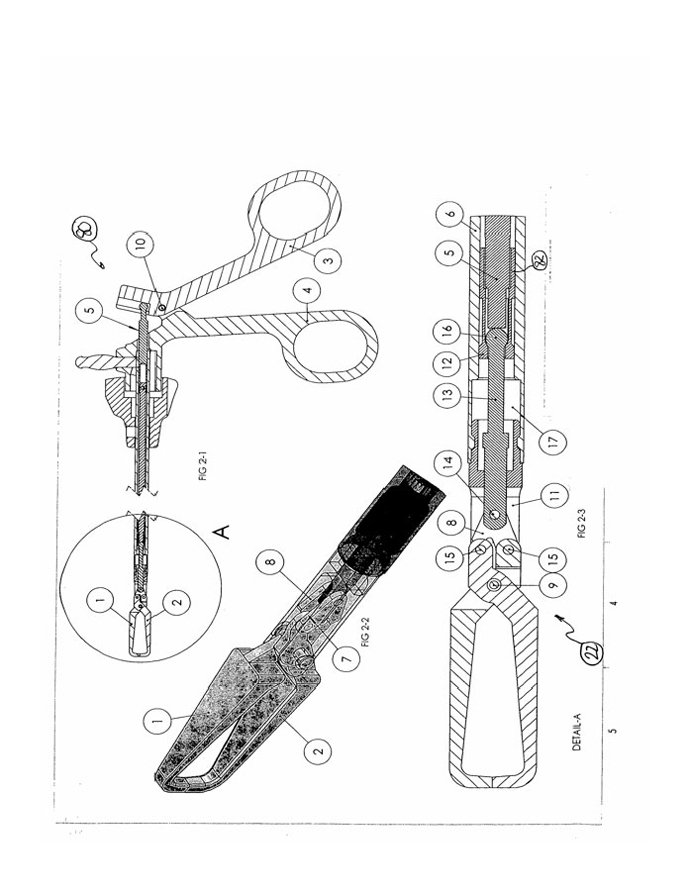
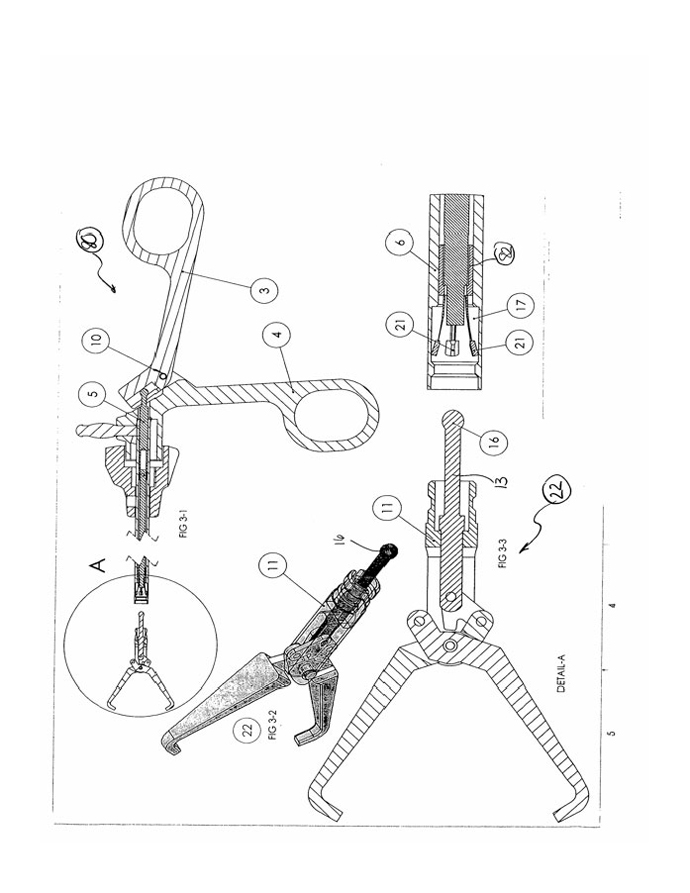

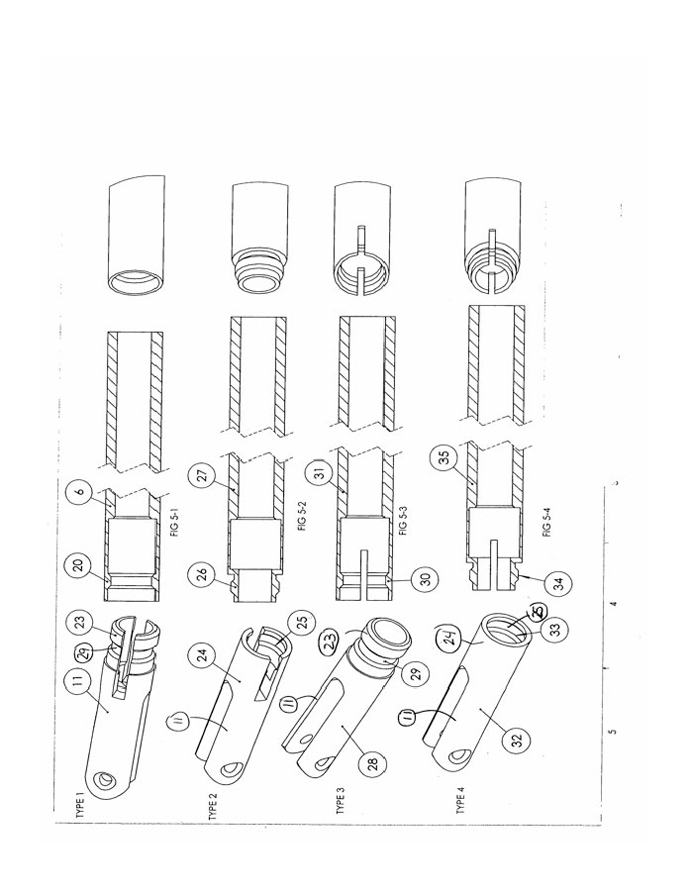

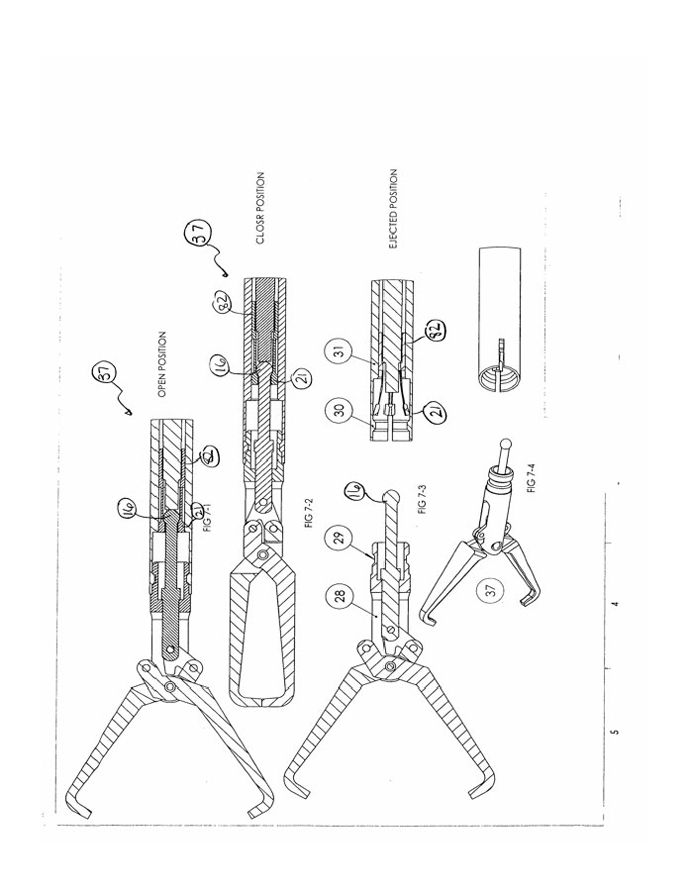
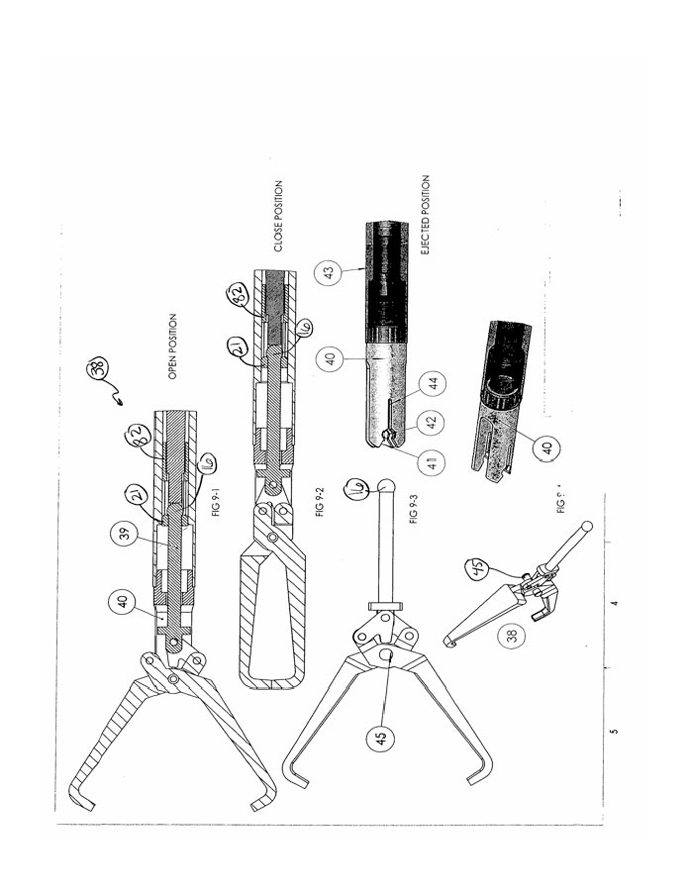
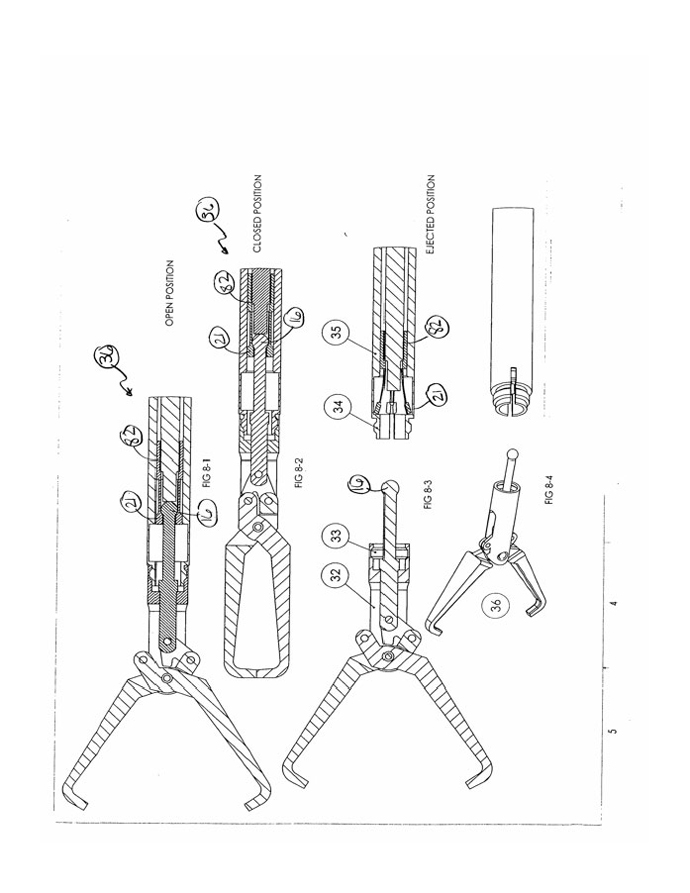
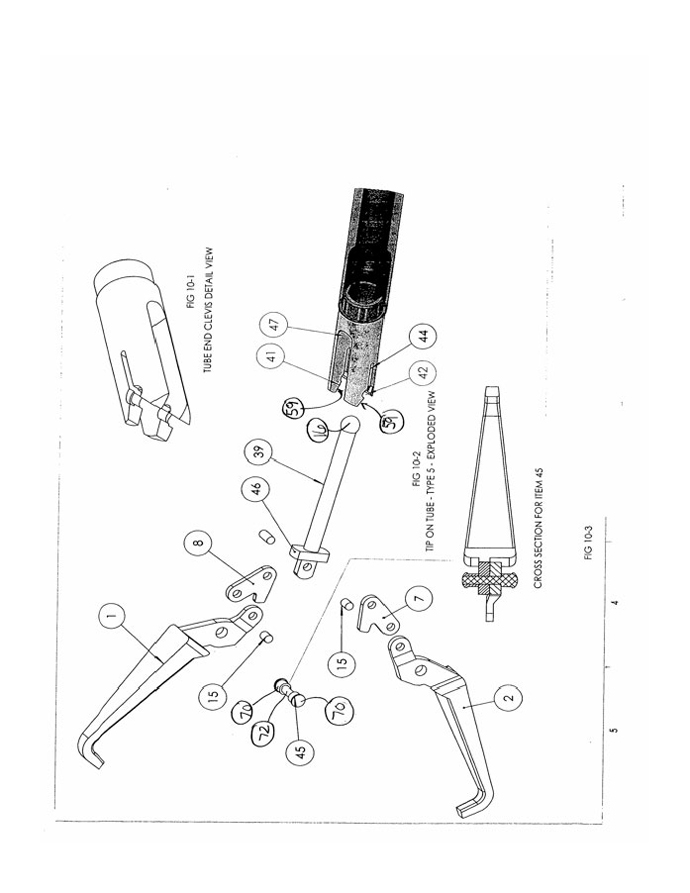
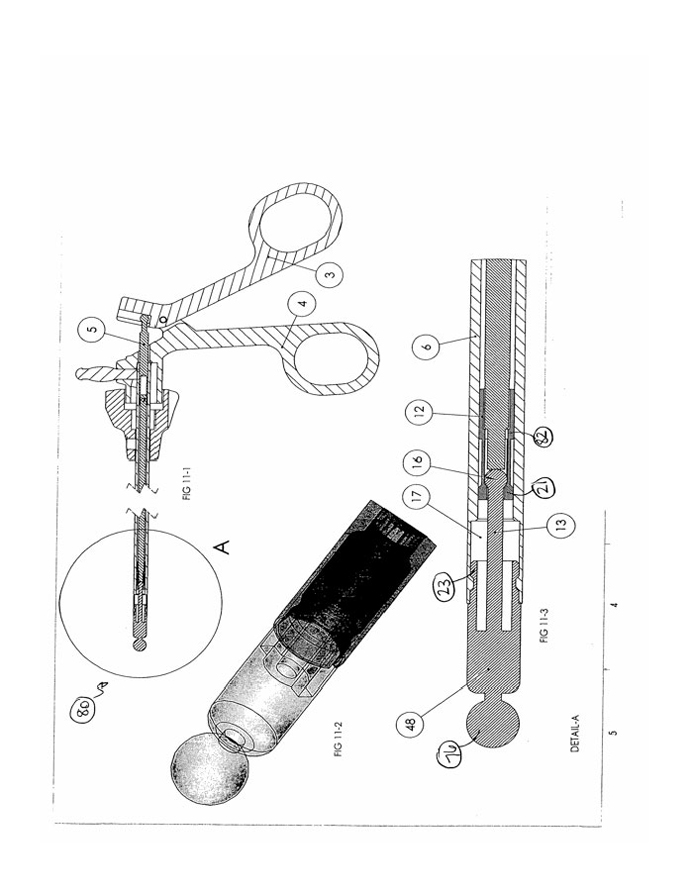
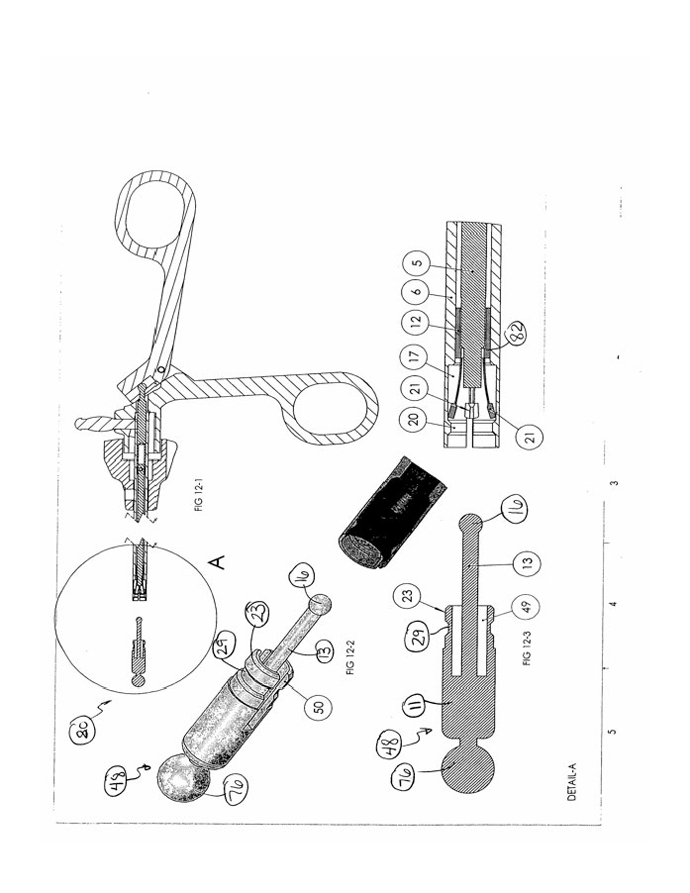
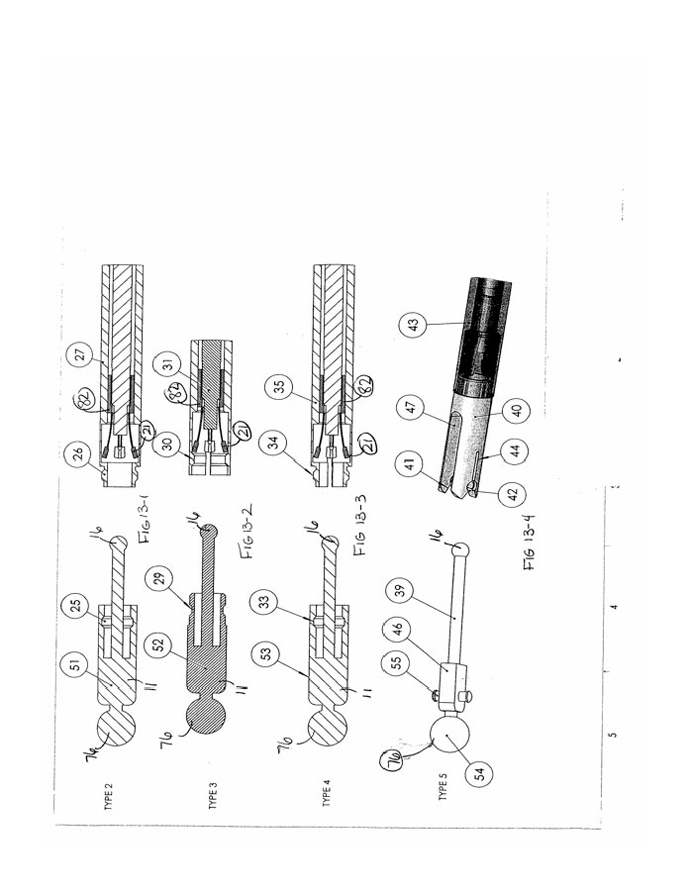
EXHIBIT B
APPARATUS
AND METHOD FOR SKIN TIGHTENING AND
CORRECTIVE
FORMING
BACKGROUND
OF THE INVENTION
1. Field
of the Invention
[0001] This
invention discloses an apparatus and accessories that are designed to induce
tightening of the skin and enhance shortening of collagen molecules in the
dermis and subcutaneous skin layers. This is achieved by inducing mechanical and
thermal injuries to the skin via electrically charged needles, arranged in
wheel(s) form.
The
recovery effect from the mechanical and thermal injuries is the tightening of
the skin, which is normally perceived to be the appearance of a younger skin.
The apparatus causes heating of the dermis and the subcutaneous layers, by
introducing charged needles either in mono-polar or bipolar mode. The mechanical
penetration of the needles assists in scar reduction and re-forming of the
epidermis.
2. Description
of the Prior Art
[0002]
Achieving a younger looking skin with tight, well defined contours, was
and is a wish common to most humans. Recent research and repeated testing shows
that either heating or puncturing the outer layers of the skin, i.e. the outer
layer: the epidermis, the inner layer: the dermis and even the next layer, the
subcutaneous layer results in skin tightening and a younger, more defined
appearance.
[0003] The
mechanisms that are responsible to the tightening of the skin and the reduction
of scar tissue are:
[0004]
Heating the dermis and subcutaneous layers results in shortening and
thickening of the collagen which leads to the tightening of the
skin
1
[0005]
Puncturing scar tissue mechanically by needles was shown to lead to the
softening of the scar and less pronounced appearance as a result of mechanical
injury like punctures by needles.
[0006] Thus,
the apparatus as described herein combines simultaneously both methods, i.e.
mechanical multi injuries induced by needle wheel(s) and thermal injury due to
heat build up due to the application of high frequency (preferably radio
frequency) current to the skin layers via the said needle wheel(s).
[0007] The
apparatus is a hand held handle including at least one needle wheel for
monopolar applications and at least 2 needle wheels for bipolar
applications. The wheel(s) are pressed against the skin and pushed
either fore or aft in a rolling motion, puncturing the skin and causing heat
buildup as a result of either monopolar or bipolar energy, supplied by the
generator to the conductive needle wheel(s).
[0008] The
handle is attached to a generator and a coolant source. The handle is powered
either by a monopolar radio frequency or bipolar radio frequency energy. In the
case of monopolar application, the patient is attached to a ground pad to allow
the current to flow. In the case of bipolar application, the current flows from
the positively charged wheel back to the generator via the negative wheel as
will be shown below.
[0009] The
wheel housing, attached to the handle, allows coolant to flow and cool the
epidermis prior and after the passage of the wheel.
[0010] The
handle preferably includes a light indicators panel, advising the physician as
to the advancement of the treatment as a function of power transfer to the
patient’s skin tissue.
2
SUMMARY
OF THE INVENTION AND ADVANTAGES
[0011] The
present invention is an apparatus and method for skin tightening and enhanced
shortening of collagen molecules in the dermis and subcutaneous skin layers.
This is achieved by inducing mechanical and thermal injuries to the skin via
electrically charged needles, arranged in wheel(s) form. The apparatus causes
heating of the dermis and the subcutaneous layers, by introducing charged
needles either in mono-polar or bipolar mode. The mechanical penetration of the
needles assists in scar reduction and re-forming of the epidermis.
[0012] As the
injuries from the mechanical and thermal injuries heal, the effect is tightening
of the skin, which is normally perceived to be the appearance of younger and
tighter skin.
BRIEF
DESCRIPTION OF THE DRAWINGS
[0013] Figure
1 shows two types of a bipolar wheel electrode apparatus being used on
skin;
[0014] Figure
2 shows a monopolar wheel electrode apparatus being used on skin;
[0015] Figure
3 is an exploded view of a bipolar wheel electrode apparatus;
[0016] Figure
4 is a general view of the bipolar apparatus with xxxx of material;
[0017]
Figures 5 shows various sections of a typical bipolar electrode
wheel;
[0018] Figure
6 shows part views of the bipolar wheel and housing component;
[0019] Figure
7 shows part views of a coated bipolar needle wheel, handle and
housing;
[0020] Figure
8 shows an exploded view of a monopolar wheel electrode apparatus;
[0021] Figure
9 shows a general view of the monopolar apparatus with a xxxx of
material;
[0022] Figure
10 shows section view of a typical monopolar wheel electrode;
[0023] Figure
11 shows views of monopolar wheels in a specific monopolar needle wheels
arrangement, and views of monopolar housing; and
3
[0024] Figure
12 shows views of a coated monopolar needle wheel, housing and
handle.
DETAILED
DESCRIPTION OF THE INVENTION
[0025]
Detailed description of the bipolar apparatus:
[0026]
Figures 1 and 2 showing an exploded view and a general view of a typical
bipolar apparatus, having a handle 14, attached to a housing 2, made of non
conductive material, said housing having axial holes to support shaft 1 of
bipolar electrode wheel.
[0027] Said
electrode wheel ranging in diameter preferably between 10- 50mm, pending on the
application and areas to be treated, and width anywhere from 1- 50mm. Said
electrode wheel containing at least 2 needle wheels, at least one of type 6 and
one of type 8. Said needle wheels are made of conductive material, preferably
stainless steel. Each needle wheel 6 and 8 is formed so that its edge carries
circumferential sharp extensions, herein called needles. The needle portion may
extend anywhere between 0.5-3mm, preferably at 1.5-2mm. Said needle wheels
having contact holes 51 for tight fit with connector pins 10. Said needle wheels
6 and 8 are placed between non conductive (preferably thermoplastic) spacer
wheels 3, 7 and 9, pending on placement of said non conductive wheel. All wheels
are placed on shaft 1. All wheels are formed with shaft key hole 52 to retain
the alignment between the needle wheels and the non conductive wheels. The
wheels are held together tightly either by adhesives, friction welding or
fasteners.
[0028] Needle
wheels are made such that said needles will protrude radially when placed
concentrically with said non conductive wheel(s) on shaft 1.
[0029] Said
needle wheels are coated with dielectric coating, typically safe for 1000V or
more, as shown in Figure 5, B and detail B, such that only needle ends, at about
0.5-2.0 mm, pending on application, are exposed, as well as contact holes for
contactors 10, to allow current passage.
4
[0030] The
electrode wheel shown contains, in this example, 12 needle wheels and 13 non
conductive wheels. Said needle wheels are arranged in a + - - + + - - + or + - +
- + . Such electrode wheel is fired via 2 connector pins 10. Said connector pins
are attached to conductive contact rings 4 and 5. Said contact rings 4 an 5 are
attached to end non conductive wheel 3 by adhesive or friction welding. First
connector pin 10 connects to all positive needle wheels via contact holes 51,
but passes freely through holes 50 in non conductive wheels, as shown in Figure
3. Second connector pin 10 connects to all negative needle wheels as shown in
Figure 3.
[0031] Handle
14 is hollow, allowing the passage of: negative 18 and positive 17 wires to the
electrode wheel; indicator lights wires 24; and coolant supply hose 16 to the
housing 2.
[0032]
Housing 2 is attached to handle and is made of non conductive material
(preferably thermoplastic) and being partially hollow, aided by covers 11 and
12, to allow the passage of wires 17 and 18 and coolant passage to holes 22,
thus cooling the epidermis prior to the electrode wheel passage and
after.
[0033]
Housing 2 includes 2 spring contactors 13, shown here as conductive ball
plungers. Such contactors maintain continuous contact between wires 17, 18 and
contact rings 4, 5 such as to have all positive needle wheels charged by wire 17
and all negative needle wheels charged by wire 18.
[0034] Handle
14 carries a light indicators panel, carrying colored lights 19, 20, 21,
attached to microprocessor 25; said microprocessor is attached to indicator
lights wires 24.
5
[0035] When
the generator is on, supplying the electrode wheel with bipolar energy, the
power through wire 17 is measured repeatedly, as an indication to the rate of
heat buildup in the skin. As long as the value read by the generator’s control
unit does not go below a set value, equivalent to the skin being heated with the
correlated increase in resistance, the green light bulb 20 is on, directing the
physician to advance in constant speed. When the decrease in power through wire
17 goes below a set value, indicative to skin resistance equivalent to above
maximum allowed temperature buildup, the power to wire 17 is cut off and red
light 21 is on. When the power is on and the physician rolls the electrode wheel
in a pace that does not allow enough time for the power to diminish to optimal
value, yellow light 19 is on, directing the physician to slow down until green
light 20 is on again.
[0036] This
simple control principle will allow the physician to adjust its electrode
rolling speed quickly and maintain safe thermal injury rate combined with
mechanical puncturing of the outer skin layers.
[0037]
Detailed description of the monopolar apparatus:
[0038]
Figures 6 and 7 showing an exploded view and a general view of a typical
monopolar apparatus, having a handle 14, attached to a housing assembly 28, made
of non conductive material, said housing having axial holes 49 to support non
conductive shaft 1 of monopolar electrode wheel.
[0039] Said
electrode wheel ranging in diameter preferably between 10- 50mm, pending on the
application and areas to be treated, and width anywhere from 1- 50mm. Said
electrode wheel containing at least 1 needle wheel, placed between 2 non
conductive wheels 41. The shown example shows 12 monopolar, selectively coated
needle wheels, and 13 non conductive wheels 41 as spacers between said needle
wheels. Said needle wheels are made of conductive material,
preferably stainless steel. Said needle wheels having holes 49 for tight fit
with connector pins 43, and loose holes 51 to allow non contact passage of
connector pins 43. Said needle wheels are placed between non conductive
(preferably thermoplastic) spacer wheels 41. All wheels are formed with shaft
key hole 52 to retain the alignment between the needle wheels and the non
conductive wheels. The wheels are held together tightly either by adhesives,
friction welding or fasteners.
6
[0040] Needle
wheels are made such that said needles will protrude radially when placed
concentrically with said non conductive wheel(s) on shaft 1.
[0041] Said
needle wheels are coated with dielectric coating, typically safe for 1000V or
more, as shown in Figure5, B and detail B, such that only needle ends, at their
respective tips, preferably but not confined to 1 mm, are exposed, as well as
contact holes for contactors pins 43, to allow current passage.
[0042] The
electrode wheel shown contains, in this example, 12 needle wheels, each 2 are
energized by one wire 17, and 13 non conductive wheels. In this example, we
intend to fire 2 non adjacent needle wheels with each live wire 17, to maintain
high energy concentration at a small number of needles, spaced apart. Thus, each
such electrode wheel is fired via 6 connector pins 43. Said connector pins are
attached to conductive contact rings 44, 45, 46. Each connector pin 43 connects
to two specific needle wheels, via one connector pin 43, but said connector pin
43 passes freely through holes in non conductive wheels and needle wheels that
are supposed not to be fired by the said connector pin 43, as shown in Figure
8.
[0043] Handle
14 is hollow, allowing the passage of (in this example): six positive 17 wires
to the electrode wheel; indicator lights wires 24; and coolant supply hose 16 to
housing 28.
[0044]
Housing 28 is attached to handle 14 and is made of non conductive
material (preferably thermoplastic) and being partially hollow, aided by covers
12, 15 and 48, to allow the passage of wires 17 and coolant passage to holes 22,
thus cooling the epidermis prior to the electrode wheel passage and
after.
7
[0045]
Housing 28 includes 6 spring contactors 13, shown here, but not limited
to conductive ball plungers. Such contactors maintain continuous contact between
wires 17 and contact rings 44, 45 and 46, such as to have all positive needle
wheels charged by wires 17 according to sequence as dictated by the generator
controls.
[0046] Handle
14 carries a light indicators panel, carrying colored lights 19, 20, 21,
attached to microprocessor 25; said microprocessor is attached to indicator
lights’ wires 24.
[0047] When
the generator is on, supplying the electrode wheel with monopolar energy, the
power through each wire 17 is timed as a stand alone and measured
individually,
[0048]
(allowing only 2 needle wheels, for example, to be fired at one time
measured repeatedly), as an indication to the rate of heat buildup in the skin.
As long as the value read by the generator control unit does not go below a set
value, equivalent to the skin being heated with the correlated increase in
resistance, the green light bulb 20 is on, directing the physician to advance in
constant speed. When the decrease in power through wire 17 goes below a set
value, indicative to skin resistance equivalent to maximum allowed temperature
buildup, the power to wire 17 is cut off and red light 21 is on. When the power
is on and the physician rolls the electrode wheel in a pace that does not allow
the power to diminish to optimal value, yellow light 19 is on, directing the
physician to slow down until green light 20 is on again.
[0049] This
design will allow alteration in the number of needle wheels to be fired
simultaneously (from 2-12 in this example) and the duration of each firing
session, thus allowing for various treatment modes as selected by the
physician.
8
[0050] This
simple control principle will allow the physician to adjust its electrode
rolling speed quickly and maintain safe thermal injury rate combined with
mechanical puncturing of the outer skin layers.
[0051] Many
modifications and variations of the present invention are possible in light of
the above teachings. In addition, the reference numerals in the claims are
merely for convenience and are not to be read in any way as
limiting.
9
ABSTRACT
OF THE DISCLOSURE
An electrode apparatus includes a
handle, a housing extending from the handles, and an electrode wheel partially
contained within the housing. A plurality of needles extend from the exterior of
the electrode wheel for penetrating through the epidermis of the skin and into
the dermis and the subcutaneous layer of skin. Energy, in the form of bipolar or
monopolar power, is transmitted through the needles to treat the dermis and/or
the subcutaneous layers of skin.
10
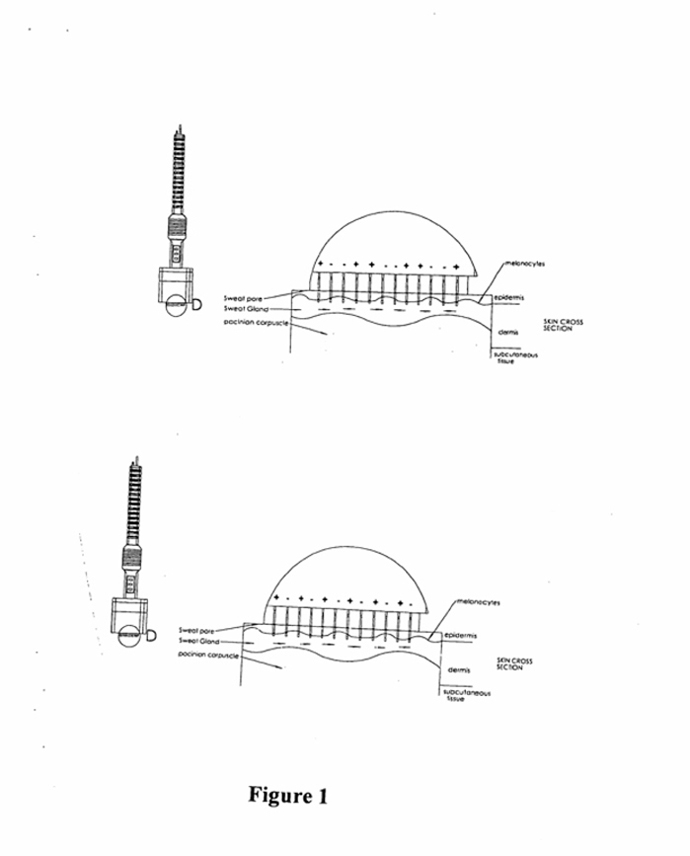
11
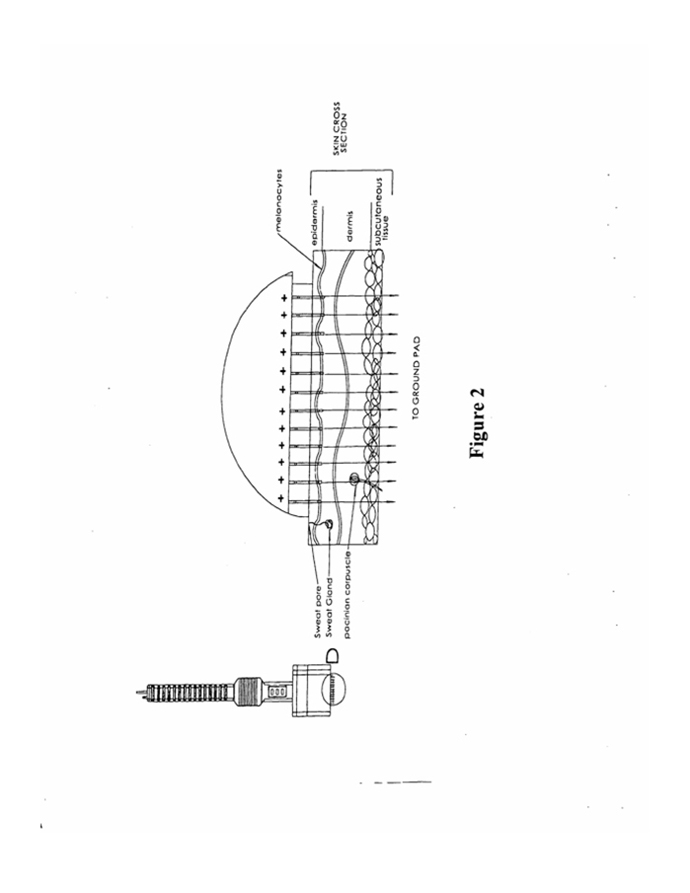
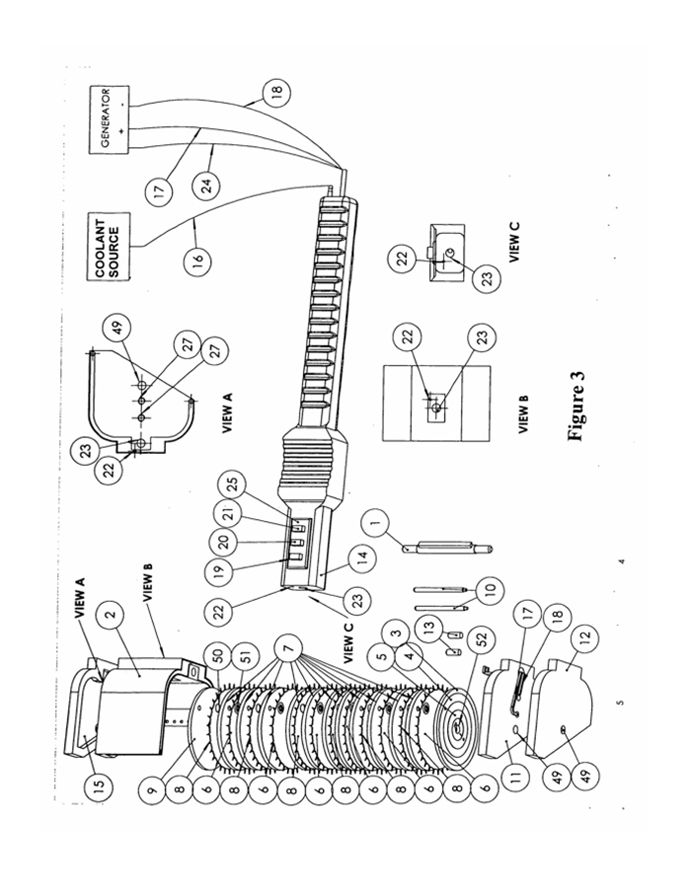
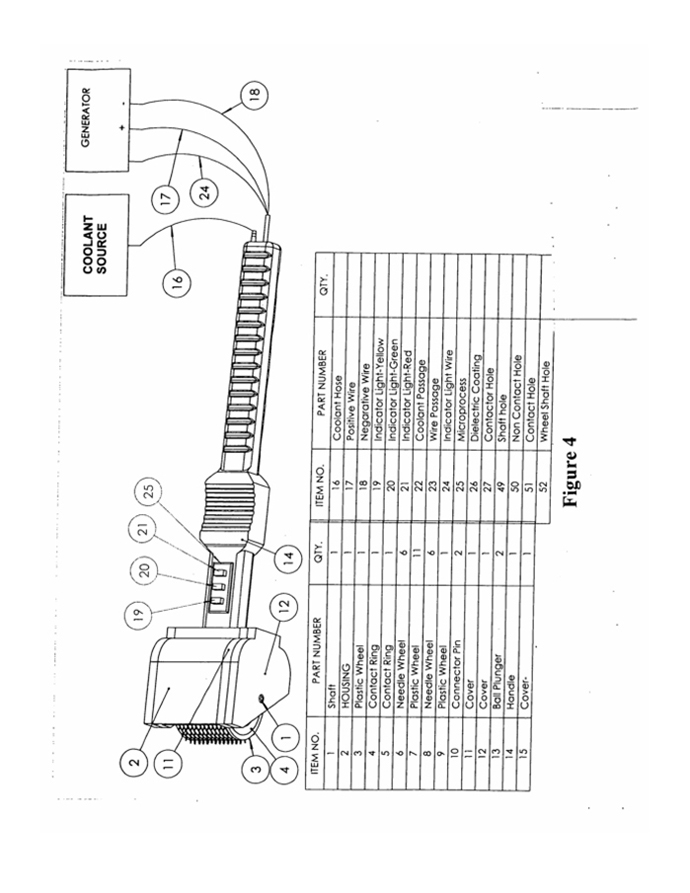


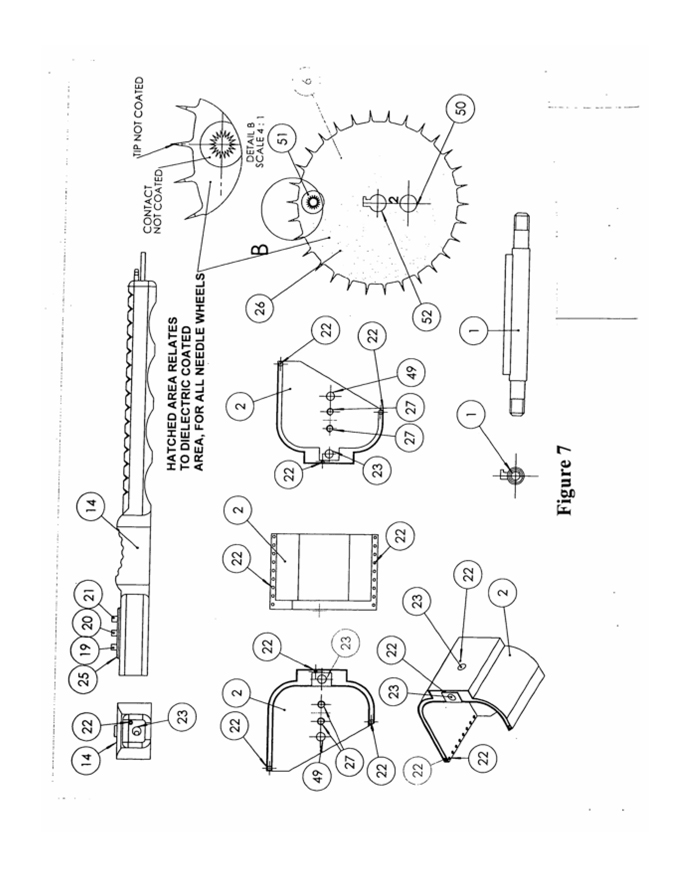

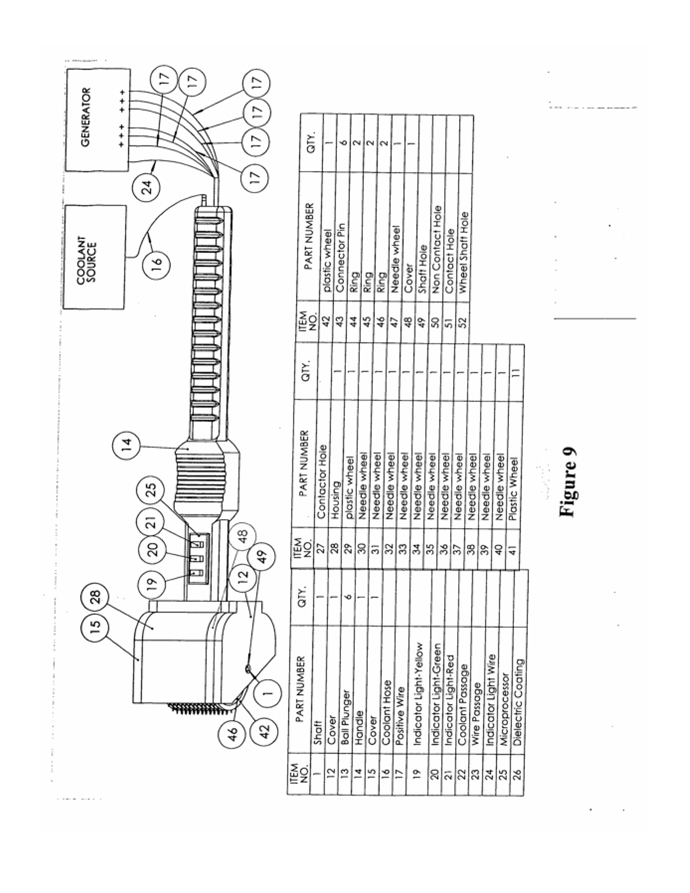
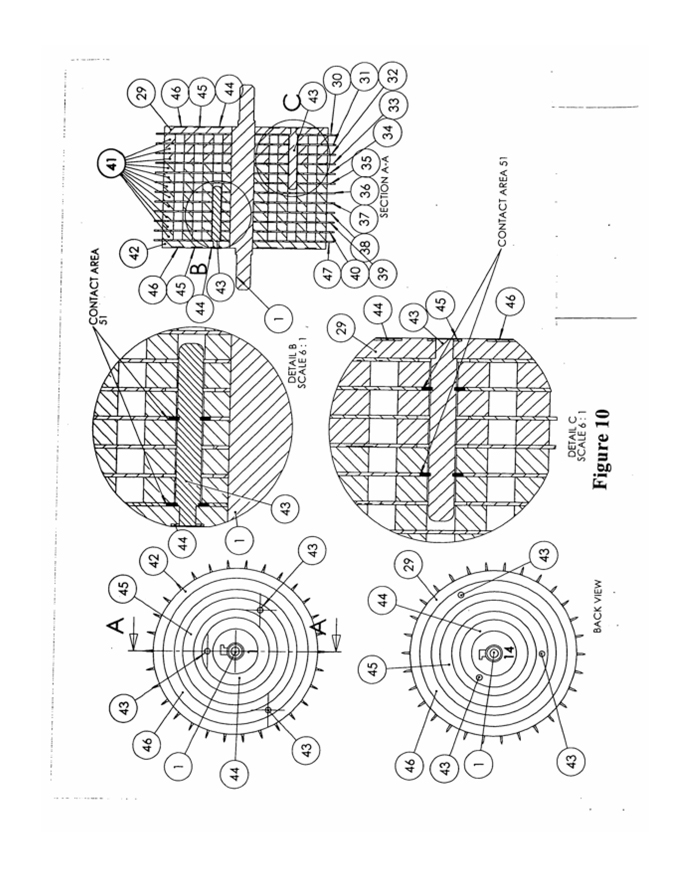
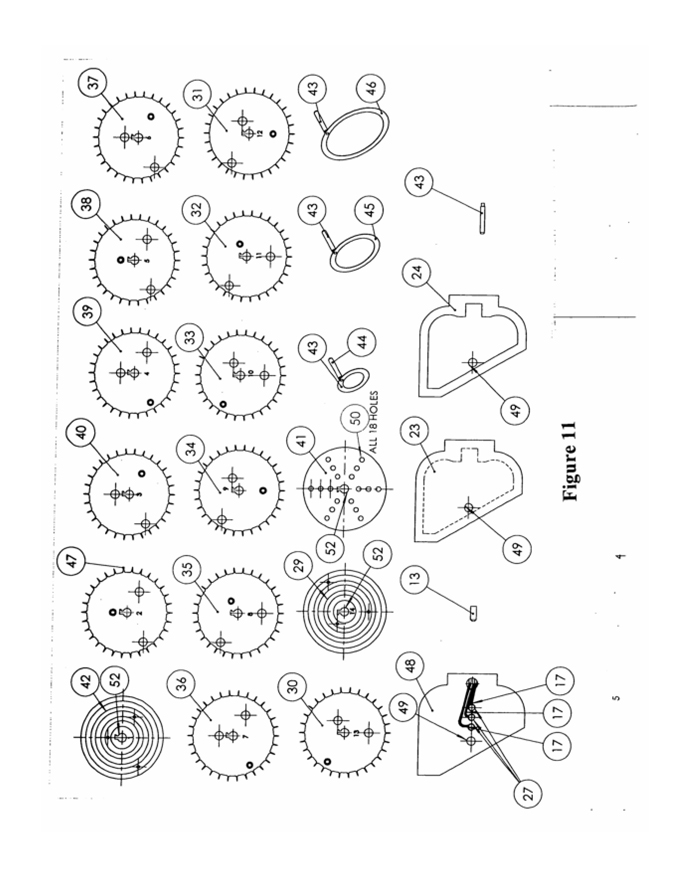
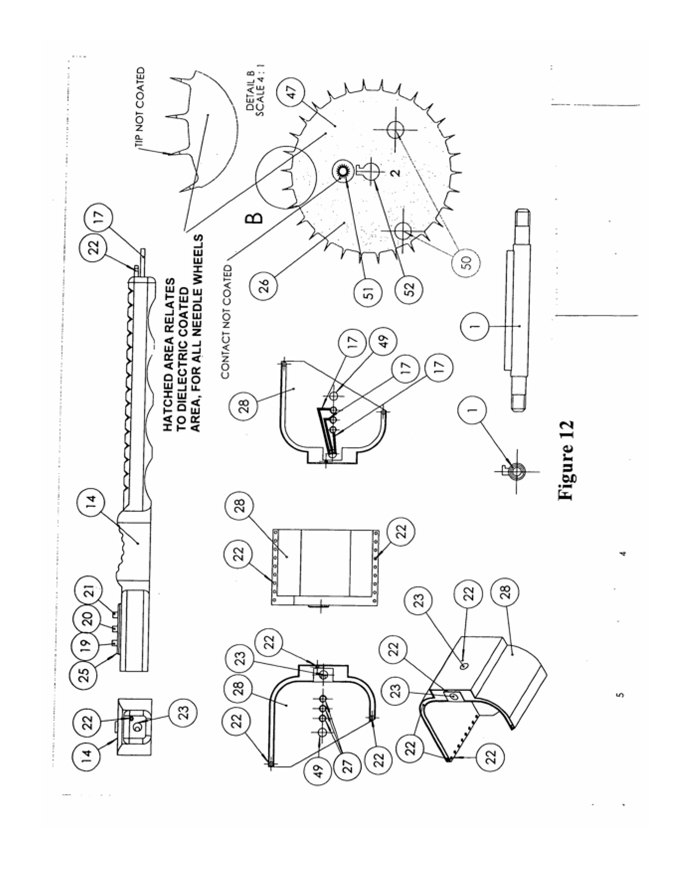
EXHIBIT C
SEAL-N-CUT
FORCEPS
BACKGROUND
OF THE INVENTION
1. Field
of the Invention
[0001] This
invention herein discloses new designs of surgical, preferably Endoscopic
forceps, intended for electro-surgery applications. Said designs show the way to
achieve monopolar and bipolar configurations, while retaining efficient, typical
jaws and linkage that are common to monopolar instruments and are highly
desirable in bipolar instruments. The current invention provides
grasping and dissection functions all in one instrument. The dissecting
elements, either blade or scissors may be disposable or reposable.
2. Background
of the Invention
[0002] Endoscopic
surgery, also known as minimally invasive surgery, is a method of surgery
designed to minimize discomfort to the patient. This is done by reducing the
required size of the opening needed to access the body’s internal organs to a
small hole. The results are, typically: fewer traumas, less pain, faster
recovery time and a shorter, if at all, length of hospitalization. The
advantages are in reduced complications, reduced mortality rate and considerable
savings to the patient and insurers.
[0003] Endoscopic
accessing of the internal cavities of the body is usually done by using a
cannula and trocar. The skin, fat, and muscle tissues are punctured by a
surgical blade or a sharp trocar. Penetrating the body cavity with a trocar that
is accompanied by a cannula, establishes a temporary inlet or a working
channel. Removing the trocar and leaving the cannula inside the body
allows the insertion of a scope, camera, forceps and other accessories into the
bodily cavity to perform the surgical procedure.
1
[0004] Endoscopic
procedures involve a majority of grasping, cauterizing and dissecting or
shearing steps, to detach tendons, muscles and blood vessels. Sealing
the cut or dissected portion is essential to avoid bleeding. This is currently
achieved, in many cases, by using electro-cautery or thermal coagulation of
tissues and vessels. Graspers and/or dissectors that apply either monopolar or
bipolar current to the cut zone are being used, following by dissection with
curved or straight scissors that are electro-cauterizing while performing the
cut. Thus, since the goal to be achieved in most endoscopic
procedures is to seal tissue and dissect it, the name seal-and-cut was selected
to describe the inventions herein.
[0005] It
is very desirable to minimize the number of openings in an endoscopic procedure,
for the purpose of reduced pain and scarring to the patient and reduced costs by
saving usage of extra cannulas and trocars. This could be achieved by combining
grasping, cauterizing and dissecting in one instrument. This reduces the number
of openings as there is no longer the need for a stand alone opening for a
grasper or a scissor. The advantages are obvious: less openings, less scarring,
less pain, less complications and less costs in trocar-cannulas and
single-function instruments and surgery time.
[0006] Some
of these goals were achieved in the past by utilizing bipolar forceps; applying
charged tongs to the grasped tissue and dissecting them by advancing a blade.
However, these designs are limited as they rely on tongs with limited openings
and reduced tactile feel, and the use of bipolar current, which is slower in
coagulation and cutting compared with monopolar current. The current
invention discloses a way to activate a dissecting blade, or secondary jaws with
an activating wire, threaded through pins and linkages, that until now seemed to
be nearly impossible.
2
SUMMARY
OF THE INVENTION AND ADVANTAGES
[0007] The
present invention is forceps for performing monopolar or bipolar surgery for
cutting and/or sealing tissue. The forceps include a moving handle, a
stationary handle, a tube extending from the stationary handle, a tip extending
from the tube, a pair of jaws extending from the tip, a connecting block
extending from the moving handle, and a hollow shaft movably connecting the
moving handle to the jaws via the connecting block. A blade extends
from a blade wire and the blade wire extends between the jaws and through the
tube, the hollow shaft, and the stationary handle and out through the connecting
block. A blade activation lever extends into the connecting block and
is connected to the blade wire for moving the blade relative to the
jaws. A compression spring is disposed between the blade activation
lever and the connecting block for providing spring-loaded resistance to the
blade activation lever. A current is sent through the blade wire
and/or the hollow shaft for performing the bipolar or the monopolar
surgery.
[0008] The
current invention discloses revolutionary designs that allow the use of
desirable jaws and links with specific solutions to monopolar and bipolar
configurations. The advantages are numerous: larger openings of jaws compared to
tongs, more accurate loading of tissue is possible by improved tactile feel,
almost any current jaw style is adaptable to the Seal-N-Cut design, and higher
loadings are possible with links and jaws as well.
3
[0009] Further,
the current invention describes ways to have only the blade or scissors as the
replaceable element. This is a much desired feature, as the sharpness
of scissor blades is a major issue of consideration in this day and age where
reposable instruments and their related savings are becoming more
popular. Replacing the sharps (i.e. the scissors function) at an
unprecedented low-cost is considered to be a major advantage by surgeons and
operating room management. This consideration served as a major
guideline in developing the concepts described herein.
[0010] Those
familiar with the art of Endoscopic instrumentation will appreciate that the
novel principles shown herein, could be applied or adapted to many other forceps
mechanisms (i.e. single jaw, rod push/pull mechanisms, etc) that necessitate a
dissection within jaws, that are activated by links and pins and a
rod. The embodiments herein are only an example of possible
applications, but are not limited to them.
BRIEF
DESCRIPTION OF THE DRAWINGS
[0011] Other
advantages of the present invention will be readily appreciated as the same
becomes better understood by reference to the following detailed description
when considered in connection with the accompanying drawings
wherein:
[0012] Figure
1-1 shows a general view of forceps;
[0013] Figure
1-2 showing forceps distal end with jaws open and blade in a normally retracted
position;
4
[0014] Figure
1-3 showing forceps distal end with jaws semi-closed and blade in extended
position;
[0015] Figure
2-1 showing forceps, 1, in a cross-sectional view;
[0016] Figure
2-2 showing detail A of distal end of said forceps;
[0017] Figure
2-3 shows section B-B through detail A and cross section at handles pivotal
area;
[0018] Figure
3-1 shows an isometric view of linkage and pins mechanism;
[0019] Figure
3-2 shows an exploded view of typical distal-end of said forceps;
[0020] Figure
4-1 shows details of typical jaw with blade-slot;
[0021] Figure
4-2 shows distal-end pins and blade;
[0022] Figure
4-3 shows hollow shaft and dielectric coating;
[0023] Figure
5-1 shows further details of the handle block set-screw and
ball-plunger;
[0024] Figure
5-2 shows details of lever and block;
[0025] Figure
5-3 shows blade-wire and its dielectric coating;
[0026] Figure
5-4 shows tube and its dielectric coating;
[0027] Figure
6-1 shows a schematic view of a bipolar forceps;
[0028] Figure
6-2 showing a transparent view of said forceps distal-end in an open
position;
[0029] Figure
6-3 shows the distal-end in closed position;
[0030] Figure
6-4 shows top-view of the jaws;
5
[0031] Figure
7 shows an isometric-view of the opened jaws grasping a blood
vessel;
[0032] Figure
8-1 shows a monopolar forceps in an isometric-view containing scissor blades
within grasping jaws;
[0033] Figure
8-2 shows a transparency of distal-end of said forceps, 60, where both scissors
and jaws are in open-position;
[0034] Figure
8-3 shows distal-end of the forceps where the jaws are semi-open and scissors
are closed (i.e. post-cutting position);
[0035] Figure
9 shows and exploded view of distal-end of said forceps;
[0036] Figure
10-1 shows an isometric-view of forceps in grasping and cutting
modes;
[0037] Figure
10-2 shows an isometric-view of a typical jaw – for clarification;
[0038] Figure
10-3 shows a transparency of scissor-blades wire and hollow-shaft;
and
[0039] Figure
10-4 shows a transparency of scissor-blades closed with clevis and
wire.
DETAILED
DESCRIPTION OF THE INVENTION
[0040] The
present invention is forceps for performing monopolar or bipolar surgery for
cutting and/or sealing tissue, e.g., blood vessels, skin, etc. The
forceps are shown generally at 1 in Figures 1-1 and 6-1. The forceps
1 generally include a moving handle 2, a stationary handle 3, a tube 5 extending
from the stationary handle 3, a tip 7 extending from the tube 5, a pair of jaws
8, 9 extending from the tip 7, a connecting block 23 extending from the moving
handle 2, and a hollow shaft 13 movably connecting the moving handle 2 to the
jaws 8, 9 via the connecting block 23.
6
[0041] The
moving handle 2 includes a clevis top 21 for receiving and retaining the
connecting block 23. Referring to Figure 5-1, the clevis top 21 is
has a generally block-shaped and defines a block tube cavity 53 and a block pin
cavity 50. The connecting block 23 includes a block portion 49 and a
block tube 55 extending from the block portion 49. The block portion
49 and a portion of the block tube 55 are inserted within the block tube cavity
53. The block tube 55 includes a pair of block pins 22 which are
inserted within the block pin cavity 50 of the clevis top 21 for preventing the
connecting block 23 from rotating with respect to the stationary handle
3.
[0042] The
carrying tube 5 extends from the fixed handle 3 and is covered with an
insulating sheath 6, i.e., a dielectric coating. Referring to Figure
3-2, the tip 7 is generally tube shaped and includes a large tube 57 and a small
tube 58. The tip 7 defines a duct 60 extending
therethrough. The small tube 58 is retained within the carrying tube
5. The large tube 57 is formed into two fingers 59, which encircle
the duct 60, for receiving a portion of the jaws 8, 9. The jaws 8, 9
are connected to the tip 7 via a pin 10 which allows the jaws 8, 9 to pivot
relative to the tip 7. The jaws 8, 9 are generally rectangular in
shape. However, they may be formed into any desired
shape. Each jaw 8, 9 defines a slot 16 extending entirely
therethrough. A pair of links 11 are connected to the jaws 8, 9 via
pins 30. The inner hollow shaft 13 slides within the carrying tube 5
and is connected to the links 11 via a pin 12. The hollow shaft 13
includes first cylinder 62 and a second cylinder 63, of a smaller diameter,
extending from the first cylinder 62. The first cylinder 62 is an
elongated tube which extends through the stationary handle 3 and is connected to
the connecting block 23. The first cylinder 62 of the hollow shaft 13
is connected to the connecting block 23 in any manner of securing, e.g., gluing,
welding, threading, etc. The second cylinder 63 extends to a
flattened end portion 61. The links 11 are connected to the end
portion 61 of the second cylinder 63 via the pin 12 for moving the jaws 8, 9
into open and closed positions as the hollow shaft 13 slides toward the tip 7
and away from the tip 7, respectively.
7
[0043] A
rotary knob 25 preferably encircles an end of the carrying tube
5. The rotary knob 25 is attached to the carrying tube 5 via a
set-screw 26. The rotary knob 25 extends into and is rotatable within
the stationary handle 3. The rotary knob 25 defines a
stationary handle cavity 27 which is defined about an exterior surface of the
rotary knob 25. The cavity 27 is positioned inside the handle
3. A ball plunger 28, which is preferably coated with a dielectric
coating 29, is mounted to the stationary handle 3, with the ball 51 of the ball
plunger 28 extending into the cavity 27 to retain the rotary knob 28 inside the
stationary handle 3. Because the carrying tube 5 is connected to the
jaws 8, 9, via the tip 7, as the rotary knob 25 is rotated with respect to the
stationary handle 3, the jaws 8, 9 also rotate.
8
[0044]
Figure 2-1 shows a cross-section extending through the forceps 1 of Figures 1-1
and 6-1. The forceps 1 also include a blade 14, slidably positioned
between the jaws 8, 9. A wire 15 is connected to the blade 14 and
extends through the inside of the tip 7, the hollow shaft 13, pins 10, 12, the
carrying tube 5, the stationary handle 3, and the connecting block
23. This allows smooth linear movement of the blade 14 and wire
15. The wire 15 extends out through the connecting block
23. The wire 15, which is coated with a block wire dielectric coating
19, is an elongated rod. A blade activating lever 17 is slidably
disposed in a tube bore 64, defined in the block tube 55. The wire 15
is connected to the blade activating lever 17 via a blade wire securing set
screw 18. A compression spring 20 is disposed inside the tube bore 64
and biases between the connecting block 23 and the blade activating lever
17. As the blade activating lever 17 is pushed toward the tip 7, the
wire 15 moves the blade 14 forward with respect to the tip 7 to perform
dissection of tissue that has been grasped between the jaws 8, 9. The
compression spring 20 not only creates resistance as the blade activating lever
17 is pushed, but the compression spring 20 acts to return the blade 14 to a
retracted position, i.e., proximally, in a proximal end of the jaws 8, 9, after
the blade activating lever 17 is released at the end of the
dissection. Therefore, pressing the blade activating lever 17
distally pushes the wire 15, carrying the blade 14 forward to perform dissection
of tissue that has been grasped between the jaws 8, 9. The wire 15 is
threaded through the hollow shaft 13 and pins 12, 10, to allow smooth linear
movement through linkage and the jaws 8, 9. The spring 20 ensures the
return of blade 14, to its proximal, retracted position at the end of the
dissection. The blade activating lever 17 is free to move fore and
aft against spring 20, inside the hollow extension 55 of the block
23. The blade activating lever 17 defines a groove 42. A
set-screw 43 extends through the block 23 and limits the aft movement of blade
activating lever 17 to avoid undesirable detachment from the block
23.
[0045] As
the rotary knob 25 and the associated jaws 8, 9 is rotated with respect to the
handles 2, 3, the blade 14 also preferably rotates with the jaws 8, 9 to remain
aligned with the respective slot 16 defined in each jaw 8, 9. To
rotate the blade 14 with the jaws 8, 9, the blade wire may have a cross-section
which is non-circular, e.g., square, oval, triangular, flattened, etc., which
slides though a complimentary shaped hole defined in links pivot pin 12, the
hollow-shaft through-hole 33, the jaws pivot-pin 12, or any other part of the
forceps 1 which already rotates as the rotary knob 25 is
rotated.
9
[0046] Figure
2-3 shows section B-B of Figure 2-2 in a typical distal-end assembly, showing
the jaw 9 and the slot 16. The blade 14 is aligned with the slot 16
and carried by the wire 15. The blade 14 is typically welded,
soldered, or crimped to the wire 15. However, the blade 14 may be
secured to the wire 15 via any other suitable method. Additionally,
the blade 14 is also contained within the slots 16 in the jaws 8,
9. Referring to Figure 1-2, the jaws 8, 9 are shown in the open
position and the blade 14 is at a normally-retracted
position. Referring to Figure 1-3, the blade 14 is shown in the
extended position, pushed forward by wire 15 via the blade activating lever
17. The blade 14 is normally nested in the proximal-end of the slots
16 within the jaws 8, 9.
[0047] Figure
2-2 shows, in detail, the proximal end of the forceps 1. The jaws 8,
9 are shown in the open position with the blade 14 is retracted. The
wire 15 extends through the pivotal pin 10 of the jaws 8, 9 and the links
pivotal pin 12. This allows for smooth and linear sliding of the wire
15 in a fore and aft position. Therefore, the wire 15 moves within
the hollow shaft 13. As the moving handle 2 is moved with respect to
the stationary handle 3, the hollow shaft 13 is pushed linearly fore and aft via
pivotal movement of the clevis 21 which is rigidly attached to the moving handle
2. The moving handle 2 pivots with respect to the stationary handle 3
via a pin 4. The clevis 21 forces movement of the inner shaft
13.
10
[0048] Figure
3-1 shows an isometric three-dimensional view of the distal-end. The
jaws 8, 9 are in the open position. The blade 14 is aligned with the
slots 16. The wire 15 is free to slide through the pins 10, 12 as the
pin 12 supports the links 11 which are connected to the jaws 8, 9 via the pins
30. Figure 3-2 shows an exploded view of a typical distal end showing
the elements in greater detail. The first cylinder 62 defines a
cavity 32 and the second cylinder 63 defines a smaller cavity 33. The
second cylinder 63 extends to the narrowed end portion 61. The
housing pin 12 connects the links 11 to the jaws 8, 9. A single lumen
31, preferably a plastic extrusion, is contained within the cavity
32. The single lumen allows the wire 15 to be guided easily through
the hollow shaft 13.
[0049] Figure
4-1 shows details of the typical jaws 8, 9 which each define the slot 16, the
pivotal pin hole 36, and the link hole 37. Figure 4-2 shows the jaw
pivotal pin 10, defining a cable wire through-hole 38; the links pin 12,
defining a blade-wire through-hole 39; the blade 14; and the single lumen
extrusion 31. Figure 4-3 shows the hollow shaft 13 including the
first and second cylinders 62, 63, defining the cavity 32 and the through hole
33, respectively, and the narrowed end portion 61defining the carrying link
pin-hole 40. The hollow shaft 13 carries a dielectric coating 35 at
its proximal-end, i.e., where it is exposed between the handles 2,
3.
[0050] Figure
5-1 shows further details of handle 2, the block 23, the set-screw 26, and the
ball-plunger 28. Figure 5-2 shows details of the lever 17 and the
block 23. Figure 5-3 shows the blade-wire 15 and its dielectric
coating 19. Figure 5-4 shows the tube 5 and its dielectric coating
6.
11
Monopolar Embodiment of the
Forceps:
[0051] Referring
again to Figures 1-1, 2-1, and 6-1, a power plug 24 is disposed in, and extends
through, a plug hole 52 defined in the connecting block 23. Referring
specifically to Figures 1-1 and 2-1, in a monopolar embodiment, current flows
through the power plug 24 to the hollow shaft 13 and through the hollow shaft 13
to the jaws 8, 9. Normally, such tissue would have been cauterized or
coagulated using a monopolar current. Dissecting the cauterized
tissue will result in a desired separation without
post-bleeding. Thus, using the forceps eliminates the need for a
stand-alone scissors to perform the cut following the cauterizing by the
grasping jaws, 8 and 9. Further, the design herein eliminates the need for an
extra portage i.e. saving an extra cannula trocar and an extra puncture the
body. Insulation aspects are not the focus of this invention. Those
familiar with the art will appreciate the ease of adaptation of insulation to
this monopolar embodiment.
Bipolar Embodiment of the
Forceps:
[0052] Referring
to Figure 6-1, a bipolar embodiment is shown. Endoscopic bipolar
cautery and coagulation are considered by many to be safer in surgery than
monopolar energy since the electrical energy is confined between two electrodes
grasping tissue, contrary to the passage of monopolar current throughout the
patients’ body into a ground pad. However, bipolar surgery is known
to be slower and is usually limited to ‘tongs’ (either wire tongs or flat tongs)
that are limited in movement and strength. These tongs are commonly
activated forcing their closure within a moving or stationary
tube. This arrangement reduces the tactile feel of the surgeon and
limits manipulation of large tissue elements. Referring to Figure
6-4, the jaws 8, 9 include a hollow conducting insert 47 which lines the
perimeter of the slot 16.
12
[0053] This
portion of the invention describes the way to adopt robust jaws, linkage, and
activating rods elements, commonly used in monopolar surgery, to improve the
performance of bipolar surgical forceps 1. Figure 6-1 shows a
schematic view of the bipolar forceps 1, similarly constructed to the
monopolar. The main difference is that the bipolar forceps 1 allow
dual polarity. The power plug 24, used with the monopolar forceps 24,
is wired to a generator 65 via a wire 44, as a negative
electrode. The blade wire 15 is connected to the generator via a wire
45, as a positive electrode.
[0054] Figure
6-4 shows a top-view of the jaw 8, showing the dielectric insert
46. The dielectric insert 46 is preferably made from ceramics or
non-conductive plastics. A hollow conducting insert 47 is disposed
along the dielectric insert 46 and is preferably made from stainless
steel. The conductive insert 47 is hollow, which allows a forward and
backward sliding motion of the blade 14.
[0055] Figure
7 shows the jaws 8, 9 in the open position with the pertaining inserts 46, 47
and the blade 14, carried on the wire 15, free to slide
forward. Electric current may flow from the blade 14 and the hollow
conductive insert 47, outward toward the jaws 8, 9, via a blood vessel
48. If polarity is changed, the current flows inward, from positively
charged jaws 8, 9, to a negatively charged frame 47 and blade
14. This flow of current results in coagulation of the tissue and
allows dissection with the blade 14 without post-bleeding.
13
[0056] The
advantages of this embodiment are clear. The jaws 8, 9 grasp
and coagulate tissue in the typical fashion of Laparoscopic electro-surgery of
today, while the blade advances, post-coagulation, and dissects the tissue
48. The coagulated ends of the tissue 48 will resist bleeding from
the cut section.
Monopolar Embodiment of the
Forceps with Scissors:
[0057] The
third embodiment shown herein, demonstrates an advanced novelty by combining the
mechanisms of cam-operated scissors with monopolar dissectors and
graspers. This embodiment brings important advantages over the
previous embodiments by allowing the usage of conventional scissors, with their
superior cutting ability, together with the wider opening of the graspers (i.e.
allowing the grasping of larger masses of tissue prior to
coagulation). This embodiment is therefore superior over existing
‘Tripolar’ instruments in the range of grasping size and cutting
efficiency. The novelty becomes clear when viewing Figure 8-1, 8-2,
and 8-3, showing similar forceps 77, in a monopolar
configuration. Many parts are identical to the elements shown in the
previous two embodiments of the forceps 1. The main differences are
listed below.
[0058] Xxxx
00, 00 xxxxx xxxxxxx xxxxxx 00, 00. The jaws 70, 71 and the blades
72, 73 pivot on a common pin 76 which is seated within the tip 7. The
jaws 70, 71 each define a jaw slot 67. The scissor blades 72, 73 are
disposed between the jaws 70, 71 and within the jaw slots
67. Therefore, as the rotary knob 25 is turned to rotate the jaws 70,
71, the scissor blades 72, 73 remain within the jaw slots 67 and therefore
rotate with the jaws 70, 71. The scissor blades 72, 73 are movably
retained by a clevis 74 and a pin 75. The pin 75 extends through a
pair of holes 68 defined in the clevis 74 and slots 78, defined in the scissor
blades 72, 73, to allow the scissor blades to articulate in a cam
fashion. A wire 69 extends from the clevis 74. A lever 79
extends from the wire 69, opposite the clevis 74, and is connected to the block
element 23 (similar to the previous embodiments). The wire 69 extends
in a sliding fashion through the hollow shaft 13 and holes 33,
32. The wire 69 is anchored to the lever 79 via the set-screw 18
disposed on the lever 79.
14
[0059] The
links 11 are connected with the hollow-shaft 13 via pin 12 and are connected
with pins 30 to the jaws 70, 71. The lever 79 is normally pushed
proximally by compression a spring (not shown) disposed within the block element
23. Therefore, in order to achieve ‘cutting’ by the scissor blades
72, 73, the lever 79 is pushed forward to close a gap 66, defined between the
lever 79 and the block element 23. The clevis 74 and the
transverse pin 75 slide within the slot 78 defined in the blades 72, 73 to force
the blades 72, 73 to pivot about a pin 76 and close. The pin 76 is
shared by the blades 72, 73 and the jaws 70, 71. Therefore while the
blades 72, 73 and the jaws 70, 71 each pivot about the pin 76, the pivotal
movement is independent of one another.
[0060] It
is important to understand that the scissor blades 72, 73, via the wire 69
disposed in the clevis 74, which are normally pulled backward by the
compression-spring 20 (not shown), are always retained in the jaws 70, 71, as
long as the lever 79 is not pushed forward. The outward movement of
the scissor blades 72, 73 is limited by the closed portion 80 in the
proximal-end of the jaws 70, 71. Further, the blades 72, 73 are
forced to close without performing a cut when the handles 2, 3 are squeezed
together to force a closure of the jaws 70, 71. Farther overlapping
of the blades 72, 73 is achieved by the forced movement of the transverse-pin
75, held by the clevis 74, via the slots 78, defined within the scissor blades
72, 73.
15
[0061] Those
familiar with the art will appreciate the adaptability of this embodiment to
other monopolar applications, such as single-jaw instruments and curved-jaw
instruments, where the curvature of the scissor blades will follow a curved slot
within the jaws.
[0062] The
invention has been described in an illustrative manner, and it is to be
understood that the terminology which has been used is intended to be in the
nature of words of description rather than of limitation. Many
modifications and variations of the present invention are possible in light of
the above teachings, and the invention may be practiced otherwise than as
specifically described.
Element
List
1 =
general forceps assembly
2 =
moving handle
3 =
stationary handle
4 =
handles pivotal pin
5 = main
tube
6 =
dielectric coating
7 =
tip
8 = upper
jaw
9 = lower
jaw
10 = jaws
pivot pin
11 =
links (two)
12 =
links pivot pin
13 =
hollow shaft
14 =
blade
15 =
blades wire
16 = jaws
slots
17 =
blade activating lever
18 =
blade wire securing set-screw
19 =
blade wire dielectric coating
20 =
compression spring
21 =
moving handle clevis
22 =
block pin
23 =
connecting block
24 =
power plug
25 =
rotary knob
26 =
rotary knob set-screw
27 =
stationary handle cavity
28 =
ball-plunger
29 =
ball-plunger dielectric coating
30 =
links-jaws pins (two)
16
31 =
single-lumen extrusion
32 =
hollow-shaft cavity
33 =
hollow-shaft through-hole
34 =
hollow-shaft narrowed-end (where links attach to pin, 12)
35 =
hollow-shaft dielectric coating
36 = jaw
pivotal-hole
37 =
jaw-link pin-hole
38 =
blade-wire through-hole in pin 10
39 =
blade-wire through-hole in pin 12
40 =
hollow-shaft through-hole for pin 12
41 =
hollow-shaft narrow distal-end
42 =
lever 17 groove
43 =
lever 17 limiter set-screw
44 =
wire, negative
45 =
wire, positive
46 =
dielectric insert
47 =
hollow conducting insert
48 =
blood vessel
49 =
block portion
50 =
block pin cavity
51 =
ball
52 = plug
hole
53 =
block tube cavity
54 =
shaft cavity
55 =
block tube
56 =
blade wire hole
57 =
large tube
58 =
small tube
59 =
fingers
60 =
duct
61 = end
portion
62 =
first cylinder
63 =
second cylinder
64 = tube
bore
65 =
generator
66 = gap
between lever, 18 and block-body, 23
67 =
jaw-slots
68 =
holes in scissor-clevis
69 =
wire
70 =
upper jaw
71 =
lower jaw
72 =
upper scissor blade
73 =
lower scissor blade
74 =
clevis
75 =
transverse pin
76 =
common pin
77 =
monopolar graspers with scissors
78 =
scissor blade-slots
79 =
scissor-activating lever
80 =
scissor blade-opening limiter
17
ABSTRACT
OF THE INVENTION
Forceps, for performing monopolar or
bipolar surgery to cut and/or seal tissue, include a moving handle, a stationary
handle, a tube extending from the stationary handle, a tip extending from the
tube, a pair of jaws extending from the tip, a connecting block extending from
the moving handle, and a hollow shaft movably connecting the moving handle to
the jaws via the connecting block. A blade extends from a blade wire
and the blade wire extends between the jaws and through the tube, the hollow
shaft, and the stationary handle and out through the connecting
block. A blade activation lever extends into the connecting block and
is connected to the blade wire for moving the blade relative to the
jaws. A compression spring is disposed between the blade activation
lever and the connecting block for providing spring-loaded resistance to the
blade activation lever. A current is sent through the blade wire
and/or the hollow shaft for performing the bipolar or the monopolar
surgery.
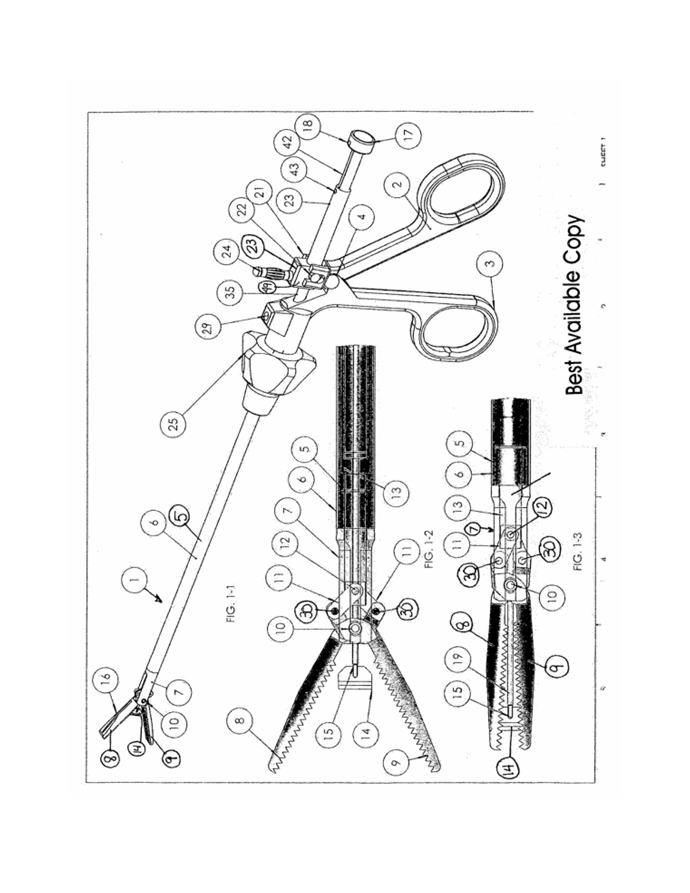
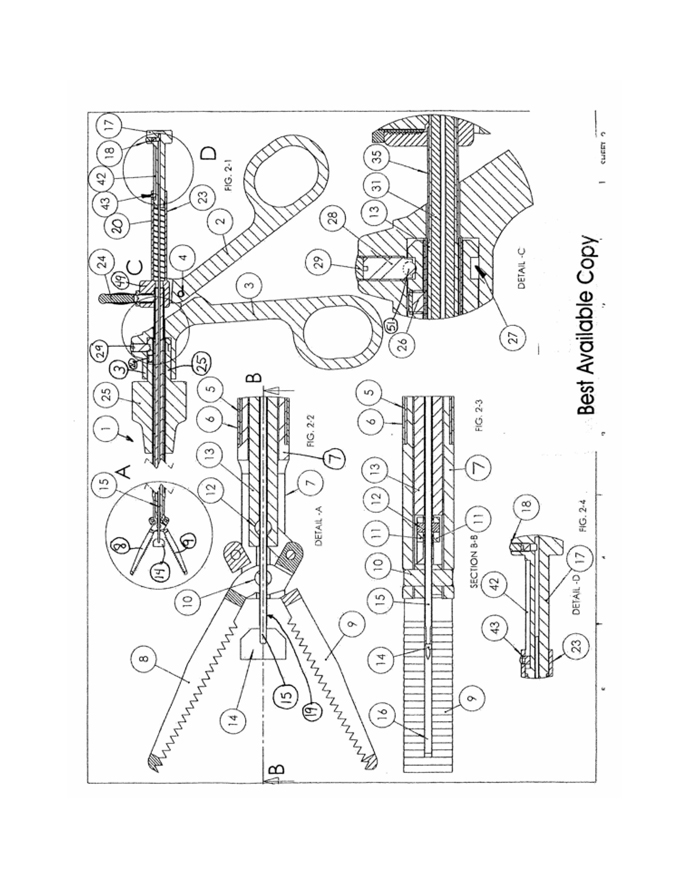
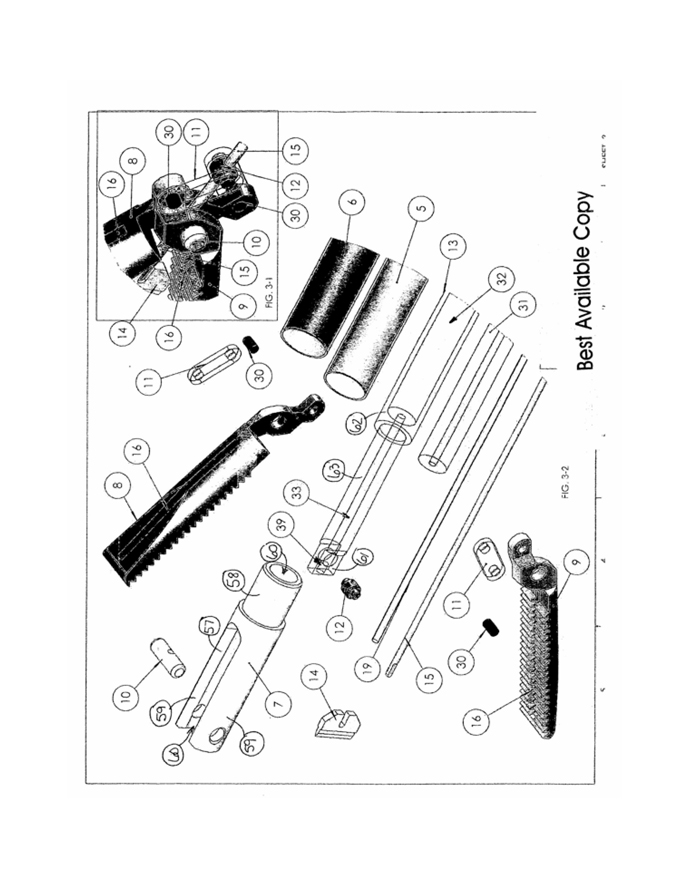
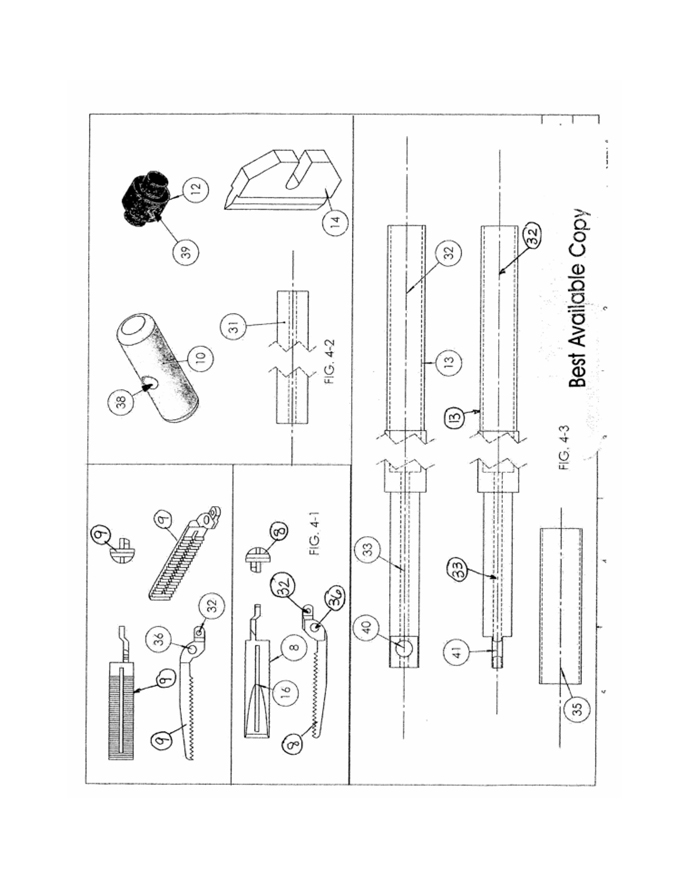
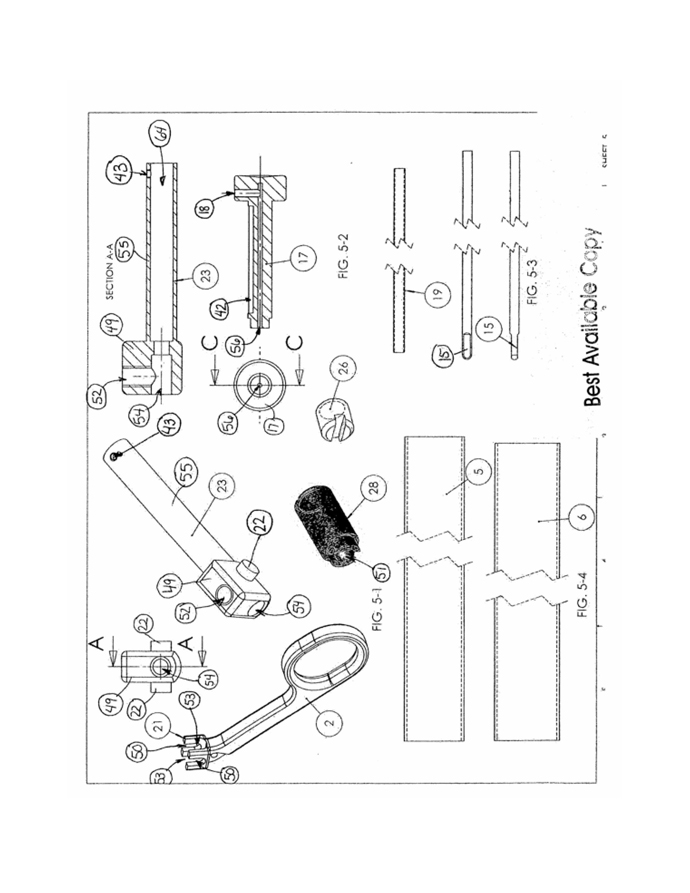
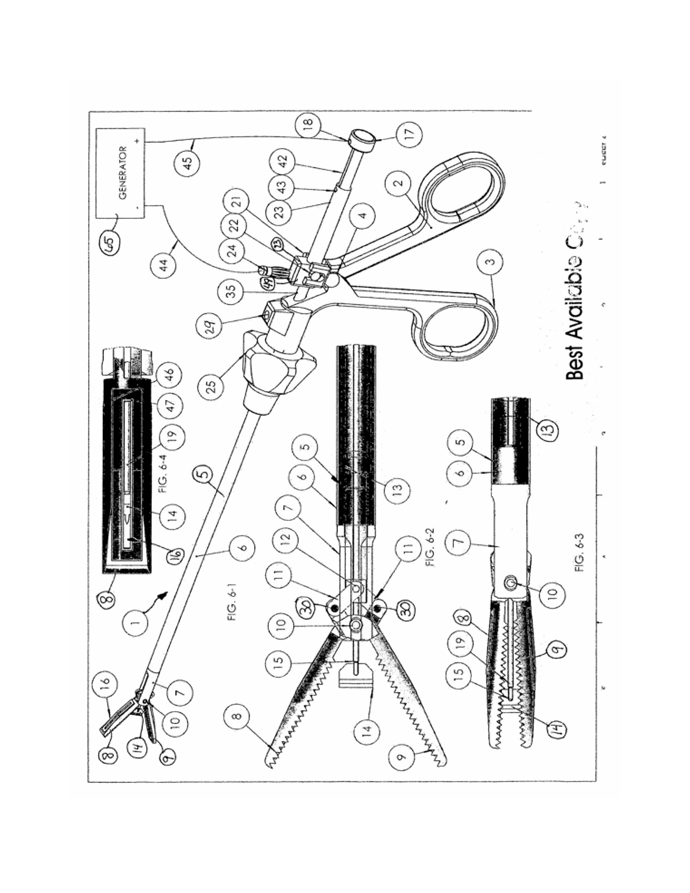
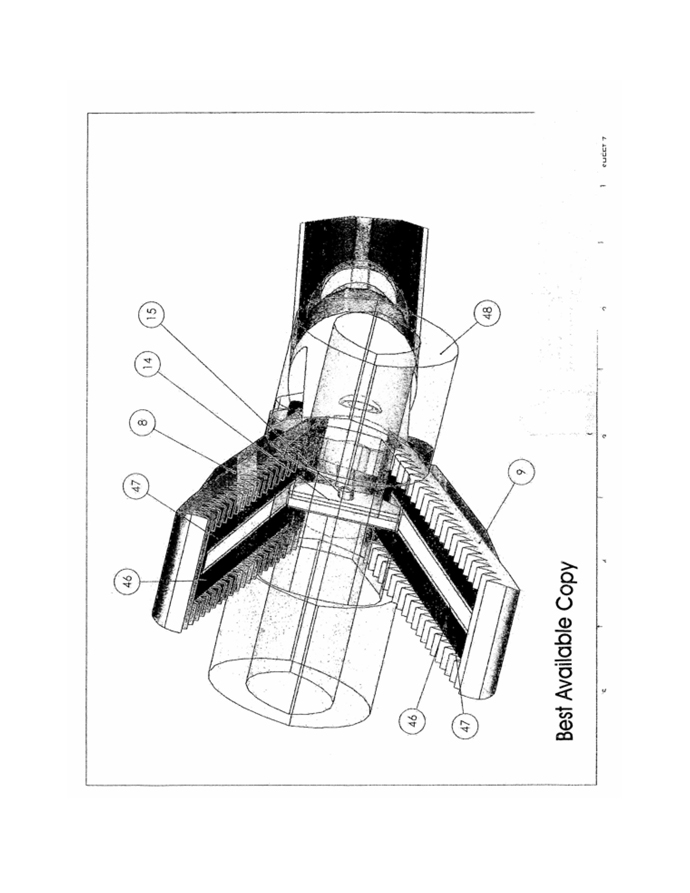
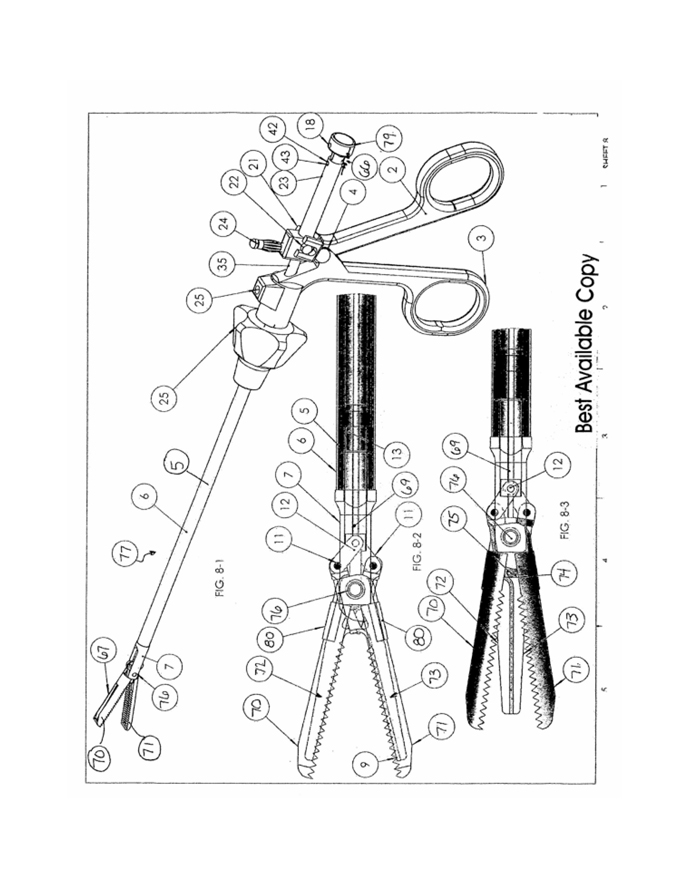
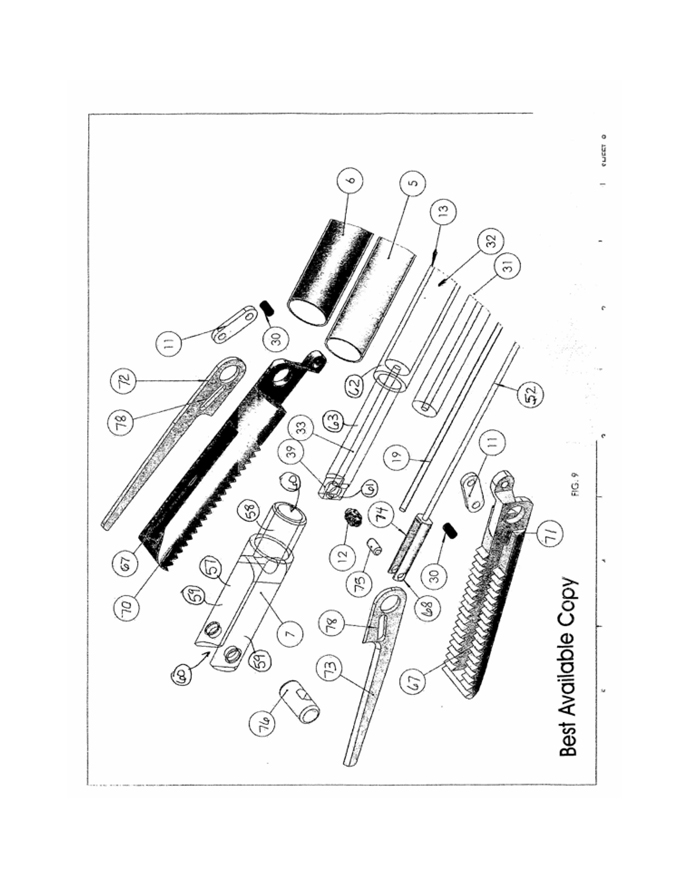
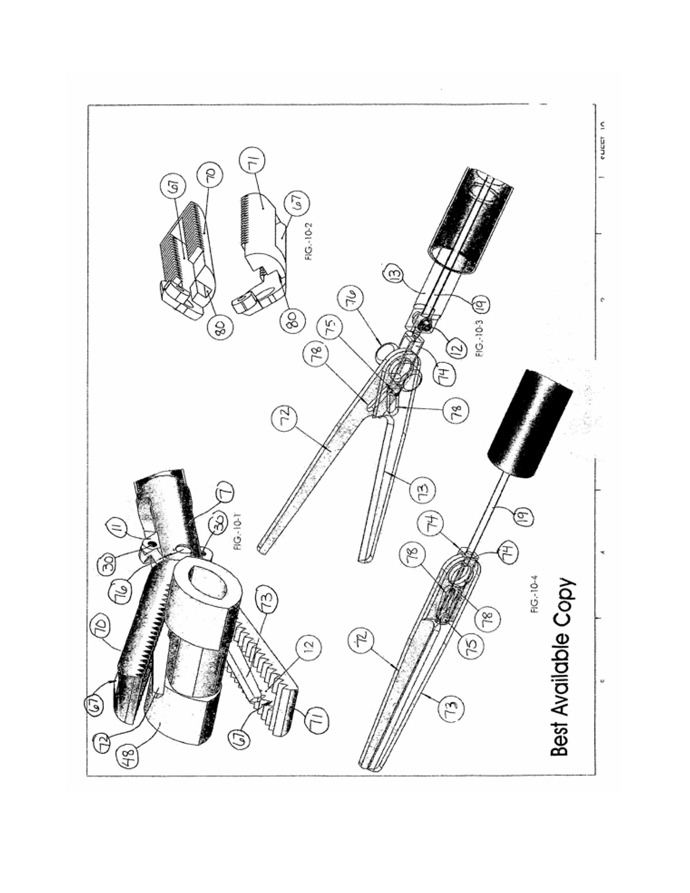
EXHIBIT D
FORCEPS
FOR PERFORMING ENDOSCOPIC OR
ARTHROSCOPIC
SURGERY
BACKGROUND
OF THE INVENTION
[0001] Today's
endoscopic and arthroscopic surgical instruments encompass a multitude of
different designs. While all may be designed to serve the same
function, for example, each one may be shaped differently to provide the surgeon
better access to perform the procedure. For example, a pair of
forceps may include a tube that extends from a pair of handles. A
blade is disposed at an end to the tube for performing the
surgery. The tube, near the blade in one pair of forceps is bent
upward to provide the surgeon with the required access in the patient to make a
first cut. However, if the surgeon needs to perform a second cut, on
the same patient, but in a different position, the surgeon must get a different
pair of forceps where the tube is bent to a different orientation.
[0002]
Based on the above, it is easy to relate to today's realities of the operating
room where a large inventory of specific instruments must be kept in an
inventory at a high cost. Managing and maintaining this inventory is
costly and complex. Lack of flexibility among the instruments are a
direct added cost to each surgery, while maintaining the different variety of
instruments necessitates trained personnel and sterilization facilities and
capabilities.
1
BRIEF
DESCRIPTION OF THE DRAWINGS
[0003] Other
advantages of the present invention will be readily appreciated, as the same
becomes better understood by reference to the following detailed description
when considered in connection with the accompanying drawings
wherein:
[0004] Figure
1 is cross-sectional side view of forceps;
[0005] Figure
2 is cross-sectional side view of a tip assembly showing a cable in an aft
position with a blade inside a tip of the tip assembly in a closed
position;
[0006] Figure
3 is a cross-sectional side view of the tip assembly showing the cable in a
forward position with the blade outside of the tip assembly in an open
position;
[0007] Figure
4 is a cross-sectional side view of a tube assembly with the blade in the open
position;
[0008] Figure
5 is a cross-sectional side view of the blade;
[0009] Figure
6 is cross-sectional front view of the blade taken along section A-A of Figure
5;
[0010] Figure
7 is a bottom view of the blade;
[0011] Figure
8 is cross-sectional side view of the tip;
[0012] Figure
9 is a bottom view of the tip;
[0013] Figure
10 is a side view of the cable;
[0014] Figure
11 is a bottom view of the cable;
[0015] Figure
12 is a side view of the cable showing a cable retainer assembled to a cable end
of the cable;
2
[0016] Figure
13 is a bottom view of the cable showing the cable retainer assembled to the
cable end of the cable;
[0017] Figure
14 is a cross-sectional side view of a body assembly;
[0018] Figure
15 is a cross-sectional front view of the body assembly showing a lock engaging
an adapter of the tube assembly;
[0019] Figure
16 is a cross-sectional front view of the body assembly showing a plunger
depressed and the lock disengaged from the adapter of the tube
assembly;
[0020] Figure
17 is a cross-sectional side view of the plunger;
[0021] Figure
18 is a cross-sectional front view of the plunger taken along line A-A of Figure
17;
[0022] Figure
19 is a top view of the lock;
[0023] Figure
20 is a side view of the lock;
[0024] Figure
21 is a cross-sectional view of the lock;
[0025] Figure
22 is a bottom view of the lock;
[0026] Figure
23 is a top view of the cable retainer;
[0027] Figure
24 is a cross-sectional side view of cable retainer;
[0028] Figure
25 is an end view of cable retainer;
[0029] Figure
26 is a partial cross-sectional side view of an articulation assembly
illustrating jaws of a collet in a closed position;
[0030] Figure
27 is a partial cross-sectional side view of the articulation assembly
illustrating the jaws of the collet in the open position;
3
[0031] Figure
28 is a partial cross-sectional top view of the articulation assembly
illustrating the jaws of the collet in the closed
position;
[0032] Figure
29 is a partial cross-sectional top view of the articulation assembly
illustrating the jaws of the collet in the open position;
[0033] Figure
30 is a partial cross-sectional side view of the forceps with handles closed and
the blade of the tube assembly in the closed position;
[0034] Figure
31 is a partial cross-sectional side view of the forceps with the handles open
and the blade of the tube assembly in the open position; and
[0035] Figure
32 is a partial cross-sectional side view of the forceps with the handles spread
to the loading position for removing or inserting the tube assembly into the
body assembly.
DETAILED
DESCRIPTION OF THE PREFERRED EMBODIMENT
[0036] Referring
to the Figures, wherein like numerals indicate like parts throughout the several
views, forceps are generally shown at 40. Forceps 40 are used for performing
various procedures during endoscopic or laparoscopic types of
surgery. A common type of procedure is cutting. However,
they can be used to perform other types of procedures such as grasping or
manipulating, for example.
[0037] The
forceps 40 include a
body-assembly 42, a tube
assembly 46, and a pair
of opposing handles 48,
50. The
handles 48, 50 include an upper handle
48 and a lower handle
50. The
handles 48, 50 are pivotally connected to
the body-assembly 42. A handle screw
52 attaches each handle
to the body-assembly 42
but allows the handles 48, 50 to pivot. A
Teflon washer 54 is
interposed between each of the handles 48, 50 and the body-assembly 42 for reducing friction when
pivoting each handle 48,
50 with respect to the
body-assembly 42.
4
[0038] The
tube assembly 46, shown
in Figure 4, includes a hollow tube 56 extending between an
adapter 58 and a tip
assembly 60. The adapter
58 encircles the tube
56 and defines a
plurality of locking grooves 62 encircling the adapter
58. The tube
56 and the adapter 58 each define a hollow
interior 59. A flushing port
66 is formed in and
extends from the adapter 58. The flushing
port 66 defines a duct
68 into the hollow
interior 59 of the
adapter 58 for flushing
the tube assembly 46. A cable 70 is connected to the tip
assembly 60 and extends
through the tube assembly 46 and out beyond the adapter
58.
[0039] The
tip assembly 60, shown
in Figures 2 and 3, extends from a distal end 72 of the tube 56 for performing the cutting
procedures. The cable 70, shown in Figures 10-13,
extends through the tube 56 and interconnects the tip
assembly 60 to the
handles 48, 50. The cable 70 is flat, having a thickness
T, and extending between
a blade-end 74 and a
cable-end 76. The blade-end
74 is disposed in the
body 134 proximate the
tip assembly 60, as
shown in Figure 14. The cable-end 76 is disposed in the body
assembly 42, proximate
the handles 48, 50. The cable 70 tapers to a reduced width
W before each of the
blade-end 74 and the
cable-end 76. The blade-end
74 extends from the
reduced width W and has
a generally trapezoidal shape with a front sloping edge 78 and a top-edge 79. The
blade-end 74 defines a
shoulder 80, opposite
the front sloping edge 78 and adjacent the reduced
width W. The
blade-end 74 defines a
tip pinhole 82. The cable-end
76 has a generally
rectangular shape that extends from the reduced width W. The cable-end
76 defines a shear
pinhole 84. A
cable retainer 86, for
mounting to the cable-end 76, is generally bullet-shaped
with a round cross-section, as shown in Figures 23-25. The cable
retainer 86 defines a
shear pin hole 84. A slot 85 is defined in the cable
retainer 86 that is at
least equal in size to the thickness T of the cable 70. The cable
retainer 86 also defines
a shear pinhole 84 that
extends through the slot 85. The thickness
T of the cable-end 76 is inserted into the slot
85 and the shear pin
holes 84 are aligned
along the same axis. A shear pin 88 is inserted through the
shear pin holes 84 to
retain the cable retainer 86 onto the cable-end 76.
5
[0040] The
tip assembly 60 includes
a blade 90 and a tip
92. The blade
90, shown in Figures
5-7, pivots relative to the tip 92 to perform the cutting
procedure. The blade 90 is flat and is generally
rectangular in shape. The blade 90 is bounded by a bottom
surface 94, an upper
surface 96, a front
98, and a rear 100. The bottom
surface 94 of the blade
90 defines a concave
cutting region 102. The upper
surface 96 of the blade
90, opposite the bottom
surface 94 and the
cutting region 102, is
rounded toward a front 98 of the blade 90. The rounded
upper surface 96 and the
concave cutting region 102 give the blade 90 the appearance of a
“claw”. The rear 100 of the blade 90 defines a blade cavity
106 that extends into
the blade 90. The blade 90 also defines a tip pin hole
82 and a cable pin hole
83 extending through the
blade 90 and the blade
cavity 106. Finally, the
blade 90 includes a
first blade-stop 107 and
a second blade-stop 109
extending between the bottom surface 94 and the upper surface 96.
6
[0041] Referring
to Figures 8 and 9, a tip 92
includes a shaft 108 that extends between a
circular neck 110 and a
cutting portion 112. The shaft
108 has a diameter H. The neck 110 has an external diameter
D which is less than the
height H and the
diameter H of the shaft
108. The neck
110 defines a pair of
external circumferential grooves 114 that encircle the neck
110. The neck
110 is engaged when
inserted into the distal end 72 of the tube 56 for retaining the tip
assembly 60 to the tube
56. The neck
110 can be attached to
the shaft 108 by
braising, laser welding, or soldering, for example. When the shaft
108 is soldered to the
shaft 108, a soldering
compound is applied to the grooves 114. Additionally,
the neck 110 is
removable from the distal end 72 of the tube 56 such that just the tip
assembly 60 can be
inserted and/or removed from the tube 56. Additionally,
an adhesive can be applied in the grooves 114 prior to inserting the
neck 110 into the distal
end 72 of the tube 56. Additionally,
the grooves 114 are
optional when O-rings are not used. As yet another alternative, the
neck 110 can be
press-fit into the distal end 72 of the tube 56. The cutting
portion 112 extends from
the shaft 108, opposite
the neck 110. The tip 92 is formed from a circular
rod and includes a top surface 116 that slopes forward to the
cutting portion 112 to
provide the cutting portion 112 with a height HT less than the diameter
H of the shaft 108. The width of
the cutting portion 112
is equal to the diameter H of the shaft 108 to provide a smooth
exterior to the tip 92
for performing surgical procedures. The cutting portion 112 and a portion of the shaft
108 define a cutting
opening 118 that is
generally rectangular in shape. The neck 110 and shaft 108 define a cable opening
120 that extends into
the cutting opening 118
to form a single continuous tip chamber 122. The cutting
opening 118, proximate a
front 124 of the tip
92, defines a front
curved surface 126. The cutting
opening 118, proximate
the neck 110 and the
cable opening 120,
defines a rear curved surface 128. A hip 130 is formed on the rear
curved surface 128,
along the bottom of the tip 92 for providing a stop for
the shoulder 80 of the
cable 70.
7
[0042] The
shaft 108, proximate the
cutting portion 112,
also defines a tip pin hole 82 that extends though the
shaft 108 and the hollow
interior 59. The blade-end
74 of the cable 70 is inserted into the hollow
interior 59 and the
respective cable pin holes 83 and tip pin holes 82 are aligned. The
blade 90 is assembled to
the blade-end 74 and a
cable pin 132 is
inserted through the aligned cable pin holes 83 to pivotally connect the
blade 90 to the cable
70. Likewise,
the blade 90 is
assembled to the tip 92
by inserting the blade 90 within the hollow interior
59 between the tip pin
holes 82 of the tip
92 and a tip pin 133 is inserted through the
aligned tip pin holes 82
to pivotally connect the blade 90 to the tip 92. Because the tip
92 is connected directly
to the tube 56, the tip
92 remains
stationary. As the blade-end 74 is moved fore/aft inside
the hollow interior 59,
by virtue of sliding the cable 70 inside the tube 56, the cable pin hole 83 slides fore/aft relative to
the tip pin hole 82,
which remains stationary. Therefore, the movement of the cable pin
hole 83, relative to the
fixed tip pin hole 82,
causes the blade 90 to
pivot about the tip pin 133 while moving the cutting
member into and out of the hollow interior 59 of the tip 92. Movement of the
cutting member relative to the cutting surface facilitates the cutting
procedure. To limit the amount the blade 90 can enter the hollow
interior 59 of the tip
92, when the blade-end
74 of the cable 70 is in an aft position, and
the blade 90 closed
(i.e., the cutting member is in the hollow interior 59 of the tip 92), the shoulder 80 is stopped by the hip 130. Therefore, the
hip 130 acts as a stop
to limit the amount the blade 90 can enter the hollow
interior 59 of the tip
92.
8
[0043] The
body-assembly 42, shown
in Figure 14, includes a body 134 and an arm 136 extending from the body
134. The
body-assembly 42 defines
a passage 138 extending
through the body 134 and
the arm 136 along a
common axis. The body 134 defines a chamber 140, which is circular, along
the passage 138. The arm 136 defines a collet-chamber
142, which is also
circular, along the passage 138. The diameter
of the collet-chamber 142 is a smaller diameter than
the diameter of the chamber 140 and extends to an
end-surface 143 on a
locking nut 197. Rests 144 are formed on the outside
of the arm 136 for
providing a stop for each of the handles 48, 50. The
body-assembly 42
includes an upper surface 96 that defines a threaded
hole 146 extending to an
opening 148. The opening
148 extends between the
threaded hole 146 and
the chamber 140 on a
locking axis AA.
[0044] A
lock 150 is disposed in
the opening 148. The lock 150 includes a base 152 that is sized to fit
within the opening 148. A locking-pin
154, which is round,
depends from the base 152 for engaging a
corresponding locking groove 62 on the tube assembly 46. A locking ramp
156 that slopes from a
top 158 of the base
152 toward the
locking-pin 154 is
formed on opposite sides of the base 152. The body 134 also defines a locking
hole 160 that is
perpendicular to and intersects the opening 148. A spring cap
162 is threadedly
engaged with the threaded hole 146. The spring cap
162 compresses and
retains a spring 164
between the spring cap 162 and the lock 150 to bias the lock 150 toward the chamber 140.
[0045] A
release plunger 166,
shown in Figures 15-18, includes a plunger-shaft 168 and a head 170 and an end 172. The
plunger-shaft 168 is
disposed in the locking hole 160 along a plunger axis BB. The
plunger-shaft 168
defines a plunger ramp 174, formed in the
plunger-shaft 168,
adjacent the end 172. When the
plunger 166 is disposed
in the locking hole 160,
the plunger ramp 174
opposes the locking ramp 156 and the locking ramp 156 imparts a force on the
plunger ramp 174 along
the locking axis AA.
9
[0046] When
the plunger 166 is
pushed along the plunger axis BB, toward the body 134, the plunger ramp 174 moves along the locking
ramp 156 and pushes the
lock 150 upward and away
from the plunger 166,
along the locking axis AA. When this
happens, the locking-pin 154 disengages the locking
groove 62 of the tube
assembly 46. When the
locking-pin 154 is
disengaged from the locking groove 62, the tube assembly 46 is free to be rotated
within the chamber 140
of the body 134 and
align a different locking groove 62 with the locking-pin 154. The tip
assembly 60 rotates with
the entire tube assembly 46 by virtue of the fixed
connection between the tip assembly 60 and the tube 56 of the tube assembly 46. Therefore, if a
different radial orientation of the tip assembly 60 is desired, relative to the
body assembly 42 and
handles 48, 50, the tube assembly 46 is rotated and locked into
the preferred orientation via the locking-pin 154. When the
plunger 166 is released,
the force imparted to the lock 150 from the locking spring
164 causes the
locking-pin 154 to
automatically engage the locking groove 62.
[0047] An
articulation assembly 175 includes a collet 176 and a stem 178. The collet
176 includes a
collet-housing 180 and
jaws 181 extending from
the collet-housing 180. The
collet-housing 180 is
generally circular and defines a stem opening 182 for receiving a portion of
the stem 178. The stem
opening 182 extends
through the collet-housing 180 and into the
jaws. The jaws 181 include four fingers 184 that extend from the
collet-housing 180 to a
cable end retainer 86 at
each end thereof. Each cable end retainer 86 extends outward and away
from each finger 184
along a slope 188. In a “relaxed”
position, the fingers 184 and their corresponding
cable end retainer 86
diverge from the collet-housing 180, as shown in Figures 27
and 29. When the fingers 184 and their corresponding
cable end retainer 86
are disposed inside of the collet-chamber 142, the fingers 184 and cable end retainer
86 are “restricted” by
the collet-chamber 142
such that they extend from the collet-housing 180 in a generally parallel
relationship 130, as
shown in Figures 26 and 28. When a tube assembly 46 is inserted into the body
134 and the fingers
184 and cable end
retainer 86 are inside
of the collet-chamber 142, the cable end retainer
86 engage and retain the
cable-end 76. The stem 178 includes a stem shaft
190 and a pair of stem
arms 192, extending from
the stem 178 in a spaced
and parallel relationship. The stem arms 192 each define a stem hole
194, aligned along the
same axis.
10
[0048] When
the articulation assembly 175 is disposed in the
collet-chamber 142, a
resistance-spring 195
surrounds the stem shaft 190, inside of the collet
chamber 142. The
resistance-spring 195 is
positioned between the collet-housing 180 and the end-surface 143. Accordingly,
as the articulation assembly 175 is pulled rearward in the
collet-chamber 142, the
resistance-spring 195 is
compressed between the collet-housing 180 and the end-surface 143. When the
articulation assembly 175 is released, the
resistance-spring 195
forces the articulation assembly 175 to slide forward in the
collet-chamber 142.
[0049] A
top link 196 and a
bottom link 198 are used
to interconnect the stem 178 and the upper and the
lower handles 48, 50. Each link
defines a link hole 204
and a stem hole 194 at
opposite ends thereof. Each handle 48, 50 defines a link hole 204. The top and
the bottom links 198 are
inserted between the arms of the stem 178 and the stem holes 194 of the top and the bottom
links 198 are aligned
with the stem holes 194
of the stem arms 192. A stem screw
208 is inserted through
all of the stem holes 194 to retain the links 196, 198 to the stem arms 192, while allowing the links
196, 198 to pivot with respect to
the handles 48, 50. The link hole
204 of the top link
196 is aligned with the
link hole 204 of the
upper handle 48. A link screw
200 is inserted through
the link holes 204,
while allowing the top link 196 to pivot with respect to
the upper handle 48. The link hole
204 of the bottom link
198 is aligned with the
link hole 204 of the
lower handle 50. A link screw
200 is inserted through
the link holes 204 while
allowing the bottom link 198 to pivot with respect to
the lower handle 50.
11
[0050] Loading
and unloading a tube assembly 46 into the body-assembly
42 is facilitated by
spreading the upper and lower handles 48, 50 far apart, i.e., pulled
apart from one another, such that the links 196, 198 cause the stem 178 to push the fingers 184 and cable end retainer
86 all the way into the
body chamber 140, as
shown in Figure 32. When the fingers 184 and the cable end retainer
86 of the collet 176 enter the body chamber
140, the fingers 184 and cable end retainer
86 are no longer
restricted by the collet-chamber 142 and no longer engage the
cable-end 76, if a tube
assembly 46 is already
loaded into the body-assembly 42. If the plunger
166 is also depressed
and the locking-pin 154
is no longer engaging the locking groove 62, the tube assembly 46 may be removed from the
body assembly 42.
[0051] As
the upper and the lower handles 48, 50 are closed, i.e., pulled
toward one another, the links 196, 198 cause the stem 178 to pull the fingers 184 and the cable end retainer
86 into the
collet-chamber 142. The slope
188 on each of the cable
end retainer 86 rides
along an edge 206
located between the chamber 140 of the body and the
collet-chamber 142. Because the
diameter of the collet-chamber 142 is smaller than the
diameter of the chamber 140 of the body 134, the slope 188 and the edge 206 cooperate to close the
fingers 184 and the
cable end retainer 86. As the cable
end retainer 86 close,
they grasp the cable-end 76 if a tube assembly 46 is inserted into the body
assembly 42.
12
[0052] Similarly,
movement of the handles 48, 50 relative to one another
moves the blade 90
relative to the tip 92
in the tip assembly 60. However, the
handles 48, 50 are not spread as far apart
as when loading and unloading a tube assembly 46 from the body-assembly
42. Therefore, when
the handles 48, 50 are moved apart, as shown
in Figure 31, the links 196, 198 cause the stem 178 to push the fingers 184 forward in the
collet-chamber 142
which, in turn, pushes the cable 70 forward through the tube
56. As the
cable 70 moves forward
in the tube 56, the
cable-end 76 and the
blade 90, at the cable
pin holes 83, slide
forward in the tip assembly 60. However,
because the blade 90
remains only pivotally connected to the tip 92 via the tip pinhole 82, the blade 90 rotates out of the hollow
interior 59 of the tip
92. Likewise,
as the handles 48, 50 are moved together, as
shown in Figure 30, the links 196, 198 cause the stem 178 to pull the fingers 184 rearward in the tube 56. As the cable
70 moves rearward in the
tube 56, the cable-end
76 and the blade 90, at the cable pinhole 83, slide rearward in the tip
assembly 60. Accordingly,
the blade 90 rotates
into the hollow interior 59 of the tip 92 by pivoting about the tip
pin 133.
[0053] There
are three stops within the forceps 40 which operate to limit the
rotation of the blade 90
with respect to the tip 92. First, as the
handles 48, 50 are closed, stops on the
body-assembly 42 limit
the travel of the handles 48, 50 which limits the amount the
blade 90 can enter the
tip 92 of the tip
assembly 60. Second, the hip
130 on the rear curved
surface 128 of the tip
92 provides a stop for
the shoulder 80 of the
cable 70 to limit the
travel of the blade 90
and prevent the cutting region 102 of the blade 90 from extending through the
tip 92. Third, the
top-edge 79 of the cable
90 cooperates with the
second blade-stop 109 to
limit the travel of the blade 90 and limit the angle CC the blade 90 opens with respect to the
tip 92. The
desired angle CC of the
blade 90 with respect to
the tip 92 is usually no
greater than 50 to 60 degrees, as shown in Figure 3.
13
[0054] The
shear pin 88 that
retains the cable-end 76
to the cable retainer 86
has a lower shear force than the tip pin 133 and the cable pin 132. This means
that if too great of force is exerted on the entire tube assembly 46 by virtue of moving the
handles 48, 50, the shear pin 88 will break and the tip pin
133 and the cable pin
132 will
not. This is important because the shear pin 88 is inside of the chamber
140 of the body and will
not result in any loose parts accidentally entering the patient during the
surgical procedure should the shear pin 88 break.
[0055] Obviously,
many modifications and variations of the present invention are possible in light
of the above teachings. In addition, the reference numerals in the
claims are merely for convenience and are not to be read in any way as
limiting.
14
FORCEPS
FOR PERFORMING ENDOSCOPIC OR ARTHROSCOPIC SURGERY
ABSTRACT
OF THE DISCLOSURE
Forceps
for performing endoscopic or arthroscopic surgery include a body-assembly, a
tube assembly, and a pair of handles that pivot with respect to the
body. The tube assembly is removably attached to the body
assembly. The tube assembly includes a hollow tube and a removable
tip assembly. The tip assembly includes a blade for performing the
surgery. The tip assembly and the blade are connected to the body and
the handles by a cable. As the handles pivot, the cable slides within
the tube to move the blade. When a different tube assembly or tip
assembly are desired, either one is removed and replaces by a new tube assembly
or tip assembly respectively.
